Paul van Yperen's Blog, page 390
February 25, 2015
Firmin Gémier
Firmin Gémier (1869-1933) was actor, director and theatre manager at the French stage. He was a promoter of theatre for the people and founder of the first Théâtre National Populaire in Paris in 1920. From the 1910s to the 1930s, Gémier also acted in silent and sound French films.
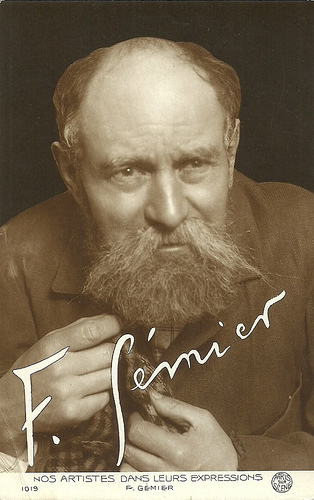
French postcard in the series Nos artistes dans leurs expressions, no. 1019, by Paris sur scene.
Refused at the Conservatory
Firmin Gémier was born as Firmin Tonnerre in Aubervilliers, France, in 1869. His father was a tanner, his mother came from a family of carpenters.
Living in the Parisian workers quartier of Belleville, he was able to go to the upper primary school Turgot thanks to a scholarship. Twice refused to study at the Conservatory, he studied acting in neighbourhood theatres, including the Théâtre de Belleville and that of Bouffes du Nord.
In 1892 (some sources say 1891), he entered the famous Théâtre Libre of André Antoine, where he worked as an actor and as a stage manager. While working for Antoine, Firmin Gémier discovered his desire to offer quality theatre at a cheap price. His debut role was that Ubu in the first performance of Ubu Roi by Alfred Jarry, at the Nouveau-Théâtre.
He then left Antoine with some other members of the troupe and played at the Théâtre du Gymnase for one season. Then he directed the Théâtre de la Renaissance, where he tried out popular theatre for the first time with the staging of Quatorze Juillet by Romain Rolland in 1902. Many plays at the Renaissance followed that year. In order to pay for the contractual debts at the Renaissance, he became actor in 1903.
He associated with Camille de Sainte-Croix in order to create a popular Parisian theatre, which was backed by the committee of the Chambre des Députés (House of Commons) in 1906, but refused by the Paris City Council. At the Odéon, he also staged La Rabouilleuse after Honoré de Balzac, in which he played Philippe Bridau.
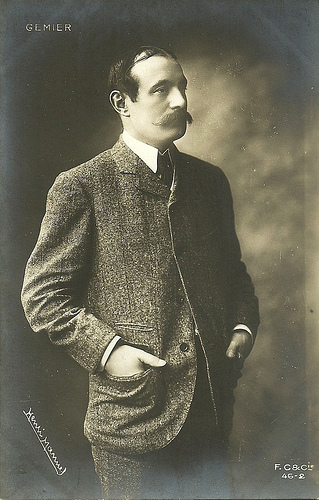
French postcard by F.C. & Cie, no. 46-2. Photo: Henri Manuel.
Beautiful, emotional, artistic - and aristocratic - sights
Between 1906 and 1919, Firmin Gémier was the head of the Théâtre Antoine. He alternated popular hits with new authors to balance the revenues.
Influenced by Romain Rolland and his ‘théâtre pour le peuple’ (theatre for the people) and by the Théâtre du Peuple at Bussang, Gémier created the Théâtre National Ambulant (1911-1912), with the help of Joseph Paul-Boncour. This was a removable auditorium with seating for 1650 persons.
With several trucks for the transport of the auditorium, he travelled across France to present the pieces he had staged with the Théâtre Antoine in Paris, such as Anna Karenina, La Rabouilleuse and Les Gaîtés de l'escadron.
Despite its big popular success, the revenues of the Théâtre National Ambulant were insufficient, and the experience was quickly abandoned.
In 1917 Gémier founded the Société Shakespeare and created The Merchant of Venice. Like Antoine, Gémier sought to renew the mise-en-scène: he made the auditorium part of the stage, used the effects of crowds, continued Antoine’s work on light by removing the ramp, and worked with Émile Jaques-Dalcroze to integrate music in the representation.
Gémier founded the Théâtre National Populaire in 1920 in Paris at the Palais de Chaillot. According to critic Régis Messac, Firmin Gémier found ‘the exact formula of the Popular Theatre. [...] Gémier has thought of offering the people sights that are beautiful, emotional, artistic - and aristocratic. He presents old and new masterpieces of our drama, with the best actors. [...] Excellent orchestras play Beethoven or Mozart. [...] The people press to these magnificent performances. People with taste expressed to be enchanted and delighted. "
Gémier also simultaneously ran one of France's national theatres, the Théâtre de l'Odéon (1921-1929, some sources say 1922-1930). In 1924, he organised the ceremonial transfer of the remains of French Socialist leader Jean Jaures to the Panthéon, the secular mausoleum in Paris containing the remains of distinguished French citizens.
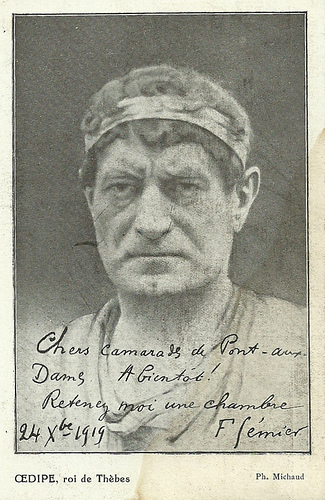
French postcard. Photo: Michaud. Publicity still of Firmin Gémier in the stage production Oedipe, roi de Thèbes. Written: "Chers camarades de Pont-aux-Dame. A' bientôt! Retenez-moi une chambre. 24 Octobre 1919. F. Gémier." (Dear fellows of P. See you soon! Keep a room for me.)
Sincerity, emotion, interiority, naturalness
Incidentally, Firmin Gémier was also a film actor and director. His cinema debut was for Pathé Frères in L'Homme qui assassina/The man who murdered (Henri Andréani, 1913). Earlier he had directed a short film for Pathé, Le père Milon/Father Milon (Firmin Gémier, Henry Houry, 1909), an adaptation of a story by Guy de Maupassant about the Franco-Prussian War.
In 1917 he played Emile Berliac, one of the leads in Abel Gance ’s Mater Dolorosa/Sorrowful Mother/The Torture of Silence, opposite Emmy Lynn as Manon Berliac and Armand Tallier as François Rolland.
In the 1920s he acted in La Branche morte/The dead branch (Giuseppe Guarino, 1926) with Dolly Davis , and played Dr. Porhoet in Rex Ingram’s The Magician (1926), a MGM production shot in Paris and Nice and based on a novel by Somerset Maugham. The Magician starred Alice Terry as a female sculptor who has an affair with a surgeon ( Iván Petrovich ) who saves her. However, another doctor and hypnotist ( Paul Wegener ) is doing experiments for which he needs female blood…
In the 1930s, Gémier acted in a few sound films. First he was Heinrich Martin in Un homme sans nom/A man without a name (Roger Le Bon, Gustav Ucicky, 1932), based on Balzac’s Le Colonel Chabert. Gémier had the lead as a German industrial who 15 years after the war returns to Germany but cannot cope with his identity as he is officially declared death. He changes his name, leaves his wife to his assistant who also has taken over direction of the firm, and starts a new life. A simultaneously made German version of the film, Mensch ohne Nahmen, had Werner Krauss in the lead.
Gémier also had the lead in the only film he directed himself, Le Simoun (Firmin Gémier, 1933). Originally Rex Ingram would have filmed Le Simoun, with exteriors in North Africa and interiors in his studio in Nice. After the flop of Ingram's film Baroud, his loss of control at the Nice studio, and his old crew leaving him alone, Rex Ingram quited the project and film making at all. Le Simoun was released four weeks after Gémier’s death. It was not a financial success.
Then Gémier had his last film part as in La Fusée/Grandeur and Decadence (Jacques Natanson, 1933). Gémier played Etienne Girbal, a factory owner who loses his wife (Marcelle Géniat) and is ruined because of the crisis, so he has to start all over again.
In 2004, Nathalie Coutelet stated in the French film historical journal 1895: "Gémier exemplifies the transition made by most theatre artists to cinema at the beginning of the 20th century. He participated in silent films, then talkies… taking up certain of his former roles with success. An emblematic figure in adapting theatre acting to the cinema, he turned to his usual creative techniques: sincerity, emotion, interiority, naturalness. The close relationship between the cinema and theatre was evident for Gémier. Yet, he conceived of cinematographic interpretation as a potential means for modernising acting and actor training, as well as a means for artistic poly valence and international collaboration."
Firmin Gémier died of heart failure in 1933 in Paris. An ardent admirer of Shakespeare, at the time of his death he was in the process of adapting The Merchant of Venice for the cinema.
As an homage, the Théâtre Firmin Gémier was founded in 1967 in Ville d'Antony in the region Île-de-France.
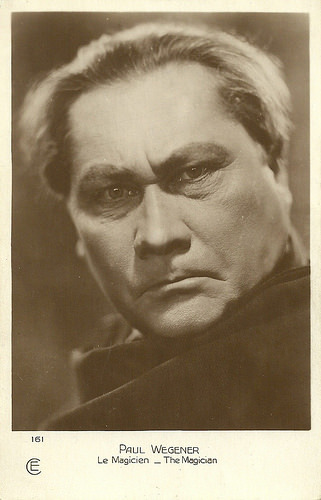
French postcard by Editions Cinémagazine, no. 161. Paul Wegener in The Magician (Rex Ingram, 1926).
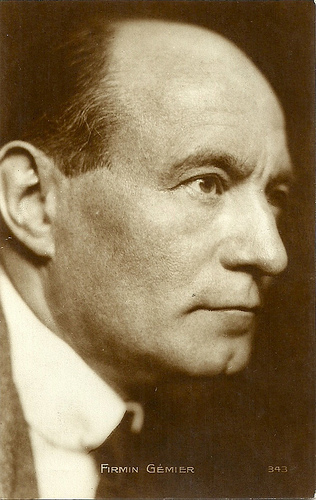
French postcard by Editions Cinémagazine, no. 343.
Sources: Nathalie Coutelet (1895 - French), Leonhard Gmür (Rex Ingram: Hollywood's Rebel of the Silver Screen), Wikipedia (French), and .

French postcard in the series Nos artistes dans leurs expressions, no. 1019, by Paris sur scene.
Refused at the Conservatory
Firmin Gémier was born as Firmin Tonnerre in Aubervilliers, France, in 1869. His father was a tanner, his mother came from a family of carpenters.
Living in the Parisian workers quartier of Belleville, he was able to go to the upper primary school Turgot thanks to a scholarship. Twice refused to study at the Conservatory, he studied acting in neighbourhood theatres, including the Théâtre de Belleville and that of Bouffes du Nord.
In 1892 (some sources say 1891), he entered the famous Théâtre Libre of André Antoine, where he worked as an actor and as a stage manager. While working for Antoine, Firmin Gémier discovered his desire to offer quality theatre at a cheap price. His debut role was that Ubu in the first performance of Ubu Roi by Alfred Jarry, at the Nouveau-Théâtre.
He then left Antoine with some other members of the troupe and played at the Théâtre du Gymnase for one season. Then he directed the Théâtre de la Renaissance, where he tried out popular theatre for the first time with the staging of Quatorze Juillet by Romain Rolland in 1902. Many plays at the Renaissance followed that year. In order to pay for the contractual debts at the Renaissance, he became actor in 1903.
He associated with Camille de Sainte-Croix in order to create a popular Parisian theatre, which was backed by the committee of the Chambre des Députés (House of Commons) in 1906, but refused by the Paris City Council. At the Odéon, he also staged La Rabouilleuse after Honoré de Balzac, in which he played Philippe Bridau.

French postcard by F.C. & Cie, no. 46-2. Photo: Henri Manuel.
Beautiful, emotional, artistic - and aristocratic - sights
Between 1906 and 1919, Firmin Gémier was the head of the Théâtre Antoine. He alternated popular hits with new authors to balance the revenues.
Influenced by Romain Rolland and his ‘théâtre pour le peuple’ (theatre for the people) and by the Théâtre du Peuple at Bussang, Gémier created the Théâtre National Ambulant (1911-1912), with the help of Joseph Paul-Boncour. This was a removable auditorium with seating for 1650 persons.
With several trucks for the transport of the auditorium, he travelled across France to present the pieces he had staged with the Théâtre Antoine in Paris, such as Anna Karenina, La Rabouilleuse and Les Gaîtés de l'escadron.
Despite its big popular success, the revenues of the Théâtre National Ambulant were insufficient, and the experience was quickly abandoned.
In 1917 Gémier founded the Société Shakespeare and created The Merchant of Venice. Like Antoine, Gémier sought to renew the mise-en-scène: he made the auditorium part of the stage, used the effects of crowds, continued Antoine’s work on light by removing the ramp, and worked with Émile Jaques-Dalcroze to integrate music in the representation.
Gémier founded the Théâtre National Populaire in 1920 in Paris at the Palais de Chaillot. According to critic Régis Messac, Firmin Gémier found ‘the exact formula of the Popular Theatre. [...] Gémier has thought of offering the people sights that are beautiful, emotional, artistic - and aristocratic. He presents old and new masterpieces of our drama, with the best actors. [...] Excellent orchestras play Beethoven or Mozart. [...] The people press to these magnificent performances. People with taste expressed to be enchanted and delighted. "
Gémier also simultaneously ran one of France's national theatres, the Théâtre de l'Odéon (1921-1929, some sources say 1922-1930). In 1924, he organised the ceremonial transfer of the remains of French Socialist leader Jean Jaures to the Panthéon, the secular mausoleum in Paris containing the remains of distinguished French citizens.

French postcard. Photo: Michaud. Publicity still of Firmin Gémier in the stage production Oedipe, roi de Thèbes. Written: "Chers camarades de Pont-aux-Dame. A' bientôt! Retenez-moi une chambre. 24 Octobre 1919. F. Gémier." (Dear fellows of P. See you soon! Keep a room for me.)
Sincerity, emotion, interiority, naturalness
Incidentally, Firmin Gémier was also a film actor and director. His cinema debut was for Pathé Frères in L'Homme qui assassina/The man who murdered (Henri Andréani, 1913). Earlier he had directed a short film for Pathé, Le père Milon/Father Milon (Firmin Gémier, Henry Houry, 1909), an adaptation of a story by Guy de Maupassant about the Franco-Prussian War.
In 1917 he played Emile Berliac, one of the leads in Abel Gance ’s Mater Dolorosa/Sorrowful Mother/The Torture of Silence, opposite Emmy Lynn as Manon Berliac and Armand Tallier as François Rolland.
In the 1920s he acted in La Branche morte/The dead branch (Giuseppe Guarino, 1926) with Dolly Davis , and played Dr. Porhoet in Rex Ingram’s The Magician (1926), a MGM production shot in Paris and Nice and based on a novel by Somerset Maugham. The Magician starred Alice Terry as a female sculptor who has an affair with a surgeon ( Iván Petrovich ) who saves her. However, another doctor and hypnotist ( Paul Wegener ) is doing experiments for which he needs female blood…
In the 1930s, Gémier acted in a few sound films. First he was Heinrich Martin in Un homme sans nom/A man without a name (Roger Le Bon, Gustav Ucicky, 1932), based on Balzac’s Le Colonel Chabert. Gémier had the lead as a German industrial who 15 years after the war returns to Germany but cannot cope with his identity as he is officially declared death. He changes his name, leaves his wife to his assistant who also has taken over direction of the firm, and starts a new life. A simultaneously made German version of the film, Mensch ohne Nahmen, had Werner Krauss in the lead.
Gémier also had the lead in the only film he directed himself, Le Simoun (Firmin Gémier, 1933). Originally Rex Ingram would have filmed Le Simoun, with exteriors in North Africa and interiors in his studio in Nice. After the flop of Ingram's film Baroud, his loss of control at the Nice studio, and his old crew leaving him alone, Rex Ingram quited the project and film making at all. Le Simoun was released four weeks after Gémier’s death. It was not a financial success.
Then Gémier had his last film part as in La Fusée/Grandeur and Decadence (Jacques Natanson, 1933). Gémier played Etienne Girbal, a factory owner who loses his wife (Marcelle Géniat) and is ruined because of the crisis, so he has to start all over again.
In 2004, Nathalie Coutelet stated in the French film historical journal 1895: "Gémier exemplifies the transition made by most theatre artists to cinema at the beginning of the 20th century. He participated in silent films, then talkies… taking up certain of his former roles with success. An emblematic figure in adapting theatre acting to the cinema, he turned to his usual creative techniques: sincerity, emotion, interiority, naturalness. The close relationship between the cinema and theatre was evident for Gémier. Yet, he conceived of cinematographic interpretation as a potential means for modernising acting and actor training, as well as a means for artistic poly valence and international collaboration."
Firmin Gémier died of heart failure in 1933 in Paris. An ardent admirer of Shakespeare, at the time of his death he was in the process of adapting The Merchant of Venice for the cinema.
As an homage, the Théâtre Firmin Gémier was founded in 1967 in Ville d'Antony in the region Île-de-France.

French postcard by Editions Cinémagazine, no. 161. Paul Wegener in The Magician (Rex Ingram, 1926).

French postcard by Editions Cinémagazine, no. 343.
Sources: Nathalie Coutelet (1895 - French), Leonhard Gmür (Rex Ingram: Hollywood's Rebel of the Silver Screen), Wikipedia (French), and .
Published on February 25, 2015 22:00
February 24, 2015
Arthur Grimm
Arthur Grimm (1908–ca. 1990) was a German photographer. He was one of the most prominent photojournalists in the Nazi era, and after the war he worked for cinema and television and made many portraits for German film star postcards.
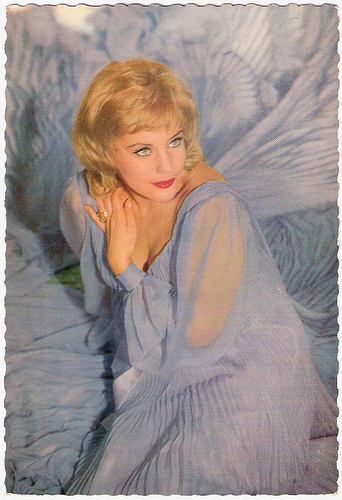
Maria Schell . German postcard by Ufa (Universum-Film Aktiengesellschaft), Berlin-Tempelhof, no. CK 420. Retail price: 30 Pfg. Photo: Arthur Grimm / Ufa.
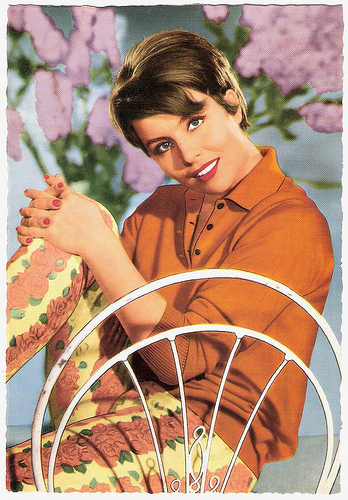
Sonja Ziemann . German postcard by WS-Druck, Wanne-Eickel, no. F 168. Photo: CCC / Arthur Grimm.
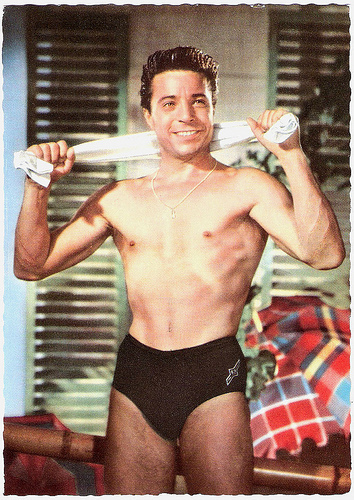
Peter Garden . German postcard by Ufa (Universum-Film Aktiengesellschaft), Berlin-Tempelhof, no. CK-87. Retail price: 30 Pfg. Photo: Arthur Grimm / Ufa.
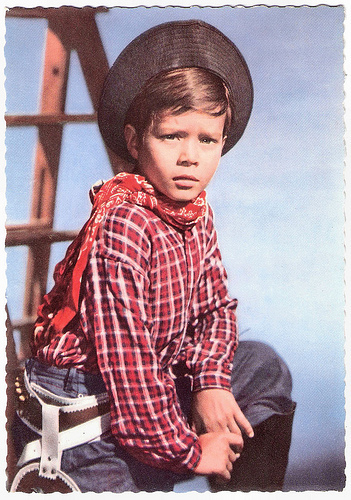
Oliver Grimm - a nephew of Arthur Grimm. German postcard by Ufa, Berlin-Tempelhof, no. CK-29. Photo: Arthur Grimm / Ufa.
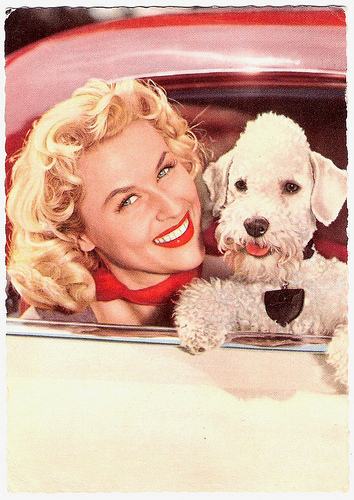
Bibi Johns . German postcard by Universum-Film Aktiengesellschaft (Ufa), Berlin-Tempelhof, no. CK-91. Sent by mail in Germany in 1962. Photo: Arthur Grimm.
Anti-Semitic ‘photojournalism’
Arthur Grimm was born in Rehau, Germany, in 1908. His older brother was the director Hans Grimm, and his sister Betti was married since 1938 with the director and producer Kurt Hoffmann.
In 1933 Grimm was a member of the NSDAP group in Rehau. The following year, he moved to Berlin. Before the Second World War, Grimm made press photos of numerous political events of the Nazis.
In 1936, he was responsible for the stills and some of the set photographs during the filming of Leni Riefenstahl 's Olympia (1936). He accompanied Riefenstahl and her team to Greece.
In the same year he recorded the Spanish Civil War as a photojournalist for a French news agency. In March 1939, he photographed the mob from the roadside when the Germans marched into Prague.
In the fall of 1939, Grimm worked in the Warsaw Ghetto. His anti-Semitic ‘photojournalism’ appeared on 5 December 1939 in the Berliner Illustrierte Zeitung.
From May 1940 to 1945 he worked as a special agent in a propaganda company for the magazine Signal. There appeared his photo stories about the war in France, the Balkan and especially in the Soviet Union.
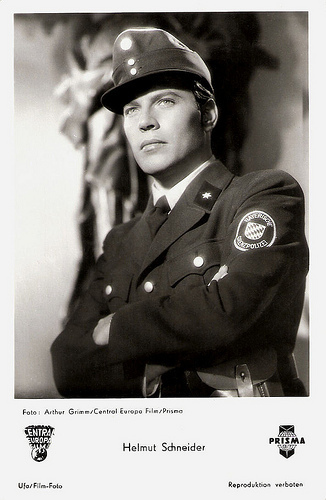
Helmuth Schneider . German postcard by Ufa, Berlin-Tempelhof, no. FK 1268. Photo: Arthur Grimm / Central Europa Film / Prisma. Publicity still for Die Schützenliesel/Schützenliesel (Rudolf Schündler, 1954).
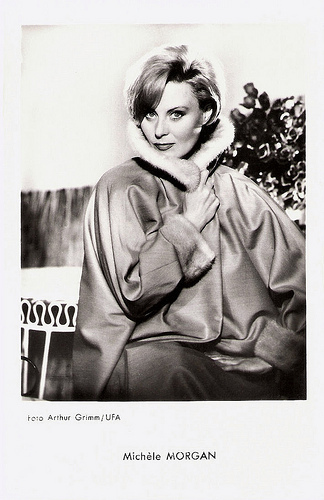
Michèle Morgan . French postcard by Editions P.I., Paris (Licency holder in France for Ufa), no. FK 17A. Offered by Les carbones Korès 'Carboplane'. Photo: Arthur Grimm / Ufa.
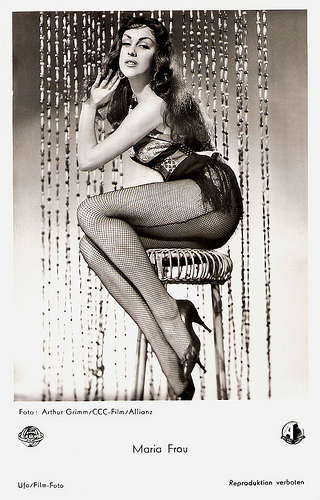
Maria Frau . German postcard by Ufa, Berlin-Tempelhof, no. FK 455. Photo: Arthur Grimm / CCC-Film / Allianz. Publicity still for Stern von Rio (Kurt Neumann, 1955).
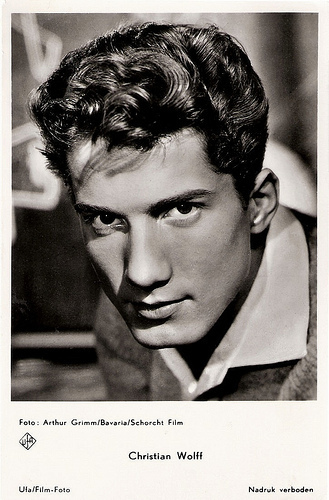
Christian Wolff . Dutch postcard by Gebr. Spanjersberg N.V., Rotterdam, no. 3846. Photo: Arthur Grimm / Bavaria /Schorcht Film. Gebr. Spanjersberg was the licence holder for the Netherlands of the postcards by Ufa (Universum-Film Aktiengesellschaft), Berlin-Tempelhoff.
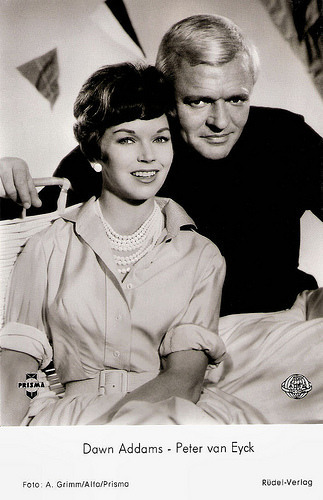
Dawn Addams and Peter van Eyck . German postcard by Rüdel-Verlag, Hamburg-Bergedorf, no. 2852. Photo: Arthur Grimm / Alfa / Prisma. Publicity still for Geheimaktion Schwarze Kapelle/The Black Chapel (Ralph Habib, 1959).
Fritz Lang
Around 1945 Arthur Grimm moved his studio to Wernigerode in the Harz Mountains. In the immediate post-war years, he trained young photographers including the later known photographer Horst Lang.
At some point he returned to West Berlin and from 1951 until 1984 he worked successfully as still photographer for film and television.
Films for which made film stills were Sündige Grenze/Illegal Border (Robert A. Stemmle, 1951) with Inge Egger , the crime thriller Die Spur führt nach Berlin/Adventure in Berlin (František Čáp, 1952) and the adventure film Stern von Rio/Star of Rio (Kurt Neumann, 1954) with Maria Frau .
In 1955, the former Nazi propaganda photograph even made the stills for the war film Der 20. Juli/The Plot to Assassinate Hitler (Falck Harnack, 1955).
For the drama Die Ratten/The Rats (Robert Siodmak, 1955) with Maria Schell and Curd Jürgens , Grimm was credited as the ‘star photographer’. Later he also made the stills for Fritz Lang’s Die 1000 Augen des Dr. Mabuse/Diabolical Dr. Mabuse (1960).
When the German television took over the cinema, the ZDF station became one of his regular clients. One of his last feature films was Herrliche Zeiten im Spessart/Glorious Times in the Spessart (Kurt Hoffmann, 1967) with Liselotte Pulver .
His studio was located in the Englerallee in Berlin-Dahlem. The last years of his life he lived in Hamburg. In 1971 he handed over parts of his archive to the Bildarchiv Preußischer Kulturbesitz (Prussian Heritage Image Archive) in Berlin. Additional material from his collection was in 1983 bought by the kPa-Fotoarchiv which passed again in 1998 in the possession of the Agency Content Mine International AG in Cologne.
Where and when exactly Arthur Grimm died is unclear.
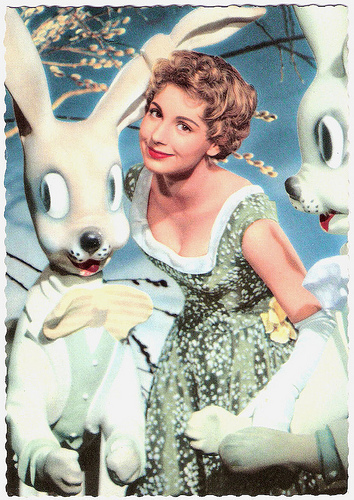
Johanna von Koczian . German postcard by Ufa, Berlin-Tempelhof, no. CK-64. Photo: Arthur Grimm / Central Europa Film.
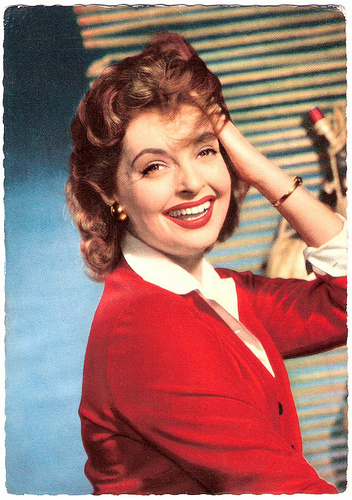
Nadja Tiller . German postcard by Ufa (Universum-Film Aktiengesellschaft), Berlin-Tempelhof, no. CK-123. Photo: Arthur Grimm / Ufa.
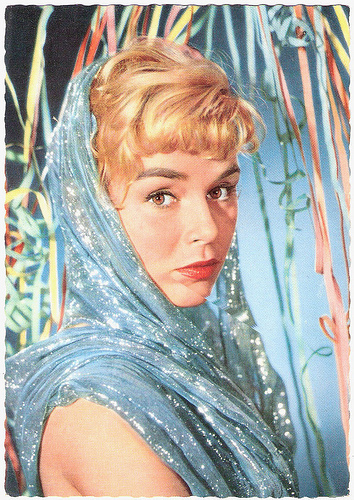
Susanne Cramer . German postcard by Ufa (Universum-Film Aktiengesellschaft) Berlin-Tempelhof, no. CK-114. Retail price: 30 Pfg. Photo: Arthur Grimm.
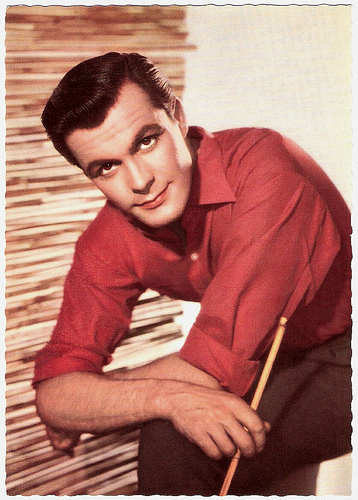
Toni Sailer . German postcard by Ufa, Berlin-Tempelhof, no. CK-314. Photo: Arthur Grimm / Ufa.
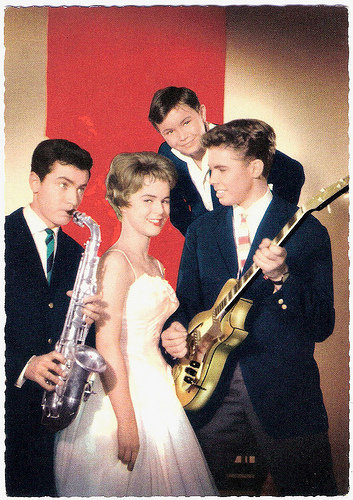
Conny Froboess , Rex Gildo , Peter Kraus and Rolf Pinegger. German postcard by ISV, no. E 13. Photo: Constantin / Grimm.
Check out our other posts on film star photographers. See the links at right under the caption 'The Photographers'.
Sources: Filmportal.de, Wikipedia (German) and IMDb.

Maria Schell . German postcard by Ufa (Universum-Film Aktiengesellschaft), Berlin-Tempelhof, no. CK 420. Retail price: 30 Pfg. Photo: Arthur Grimm / Ufa.

Sonja Ziemann . German postcard by WS-Druck, Wanne-Eickel, no. F 168. Photo: CCC / Arthur Grimm.

Peter Garden . German postcard by Ufa (Universum-Film Aktiengesellschaft), Berlin-Tempelhof, no. CK-87. Retail price: 30 Pfg. Photo: Arthur Grimm / Ufa.

Oliver Grimm - a nephew of Arthur Grimm. German postcard by Ufa, Berlin-Tempelhof, no. CK-29. Photo: Arthur Grimm / Ufa.

Bibi Johns . German postcard by Universum-Film Aktiengesellschaft (Ufa), Berlin-Tempelhof, no. CK-91. Sent by mail in Germany in 1962. Photo: Arthur Grimm.
Anti-Semitic ‘photojournalism’
Arthur Grimm was born in Rehau, Germany, in 1908. His older brother was the director Hans Grimm, and his sister Betti was married since 1938 with the director and producer Kurt Hoffmann.
In 1933 Grimm was a member of the NSDAP group in Rehau. The following year, he moved to Berlin. Before the Second World War, Grimm made press photos of numerous political events of the Nazis.
In 1936, he was responsible for the stills and some of the set photographs during the filming of Leni Riefenstahl 's Olympia (1936). He accompanied Riefenstahl and her team to Greece.
In the same year he recorded the Spanish Civil War as a photojournalist for a French news agency. In March 1939, he photographed the mob from the roadside when the Germans marched into Prague.
In the fall of 1939, Grimm worked in the Warsaw Ghetto. His anti-Semitic ‘photojournalism’ appeared on 5 December 1939 in the Berliner Illustrierte Zeitung.
From May 1940 to 1945 he worked as a special agent in a propaganda company for the magazine Signal. There appeared his photo stories about the war in France, the Balkan and especially in the Soviet Union.

Helmuth Schneider . German postcard by Ufa, Berlin-Tempelhof, no. FK 1268. Photo: Arthur Grimm / Central Europa Film / Prisma. Publicity still for Die Schützenliesel/Schützenliesel (Rudolf Schündler, 1954).

Michèle Morgan . French postcard by Editions P.I., Paris (Licency holder in France for Ufa), no. FK 17A. Offered by Les carbones Korès 'Carboplane'. Photo: Arthur Grimm / Ufa.

Maria Frau . German postcard by Ufa, Berlin-Tempelhof, no. FK 455. Photo: Arthur Grimm / CCC-Film / Allianz. Publicity still for Stern von Rio (Kurt Neumann, 1955).

Christian Wolff . Dutch postcard by Gebr. Spanjersberg N.V., Rotterdam, no. 3846. Photo: Arthur Grimm / Bavaria /Schorcht Film. Gebr. Spanjersberg was the licence holder for the Netherlands of the postcards by Ufa (Universum-Film Aktiengesellschaft), Berlin-Tempelhoff.

Dawn Addams and Peter van Eyck . German postcard by Rüdel-Verlag, Hamburg-Bergedorf, no. 2852. Photo: Arthur Grimm / Alfa / Prisma. Publicity still for Geheimaktion Schwarze Kapelle/The Black Chapel (Ralph Habib, 1959).
Fritz Lang
Around 1945 Arthur Grimm moved his studio to Wernigerode in the Harz Mountains. In the immediate post-war years, he trained young photographers including the later known photographer Horst Lang.
At some point he returned to West Berlin and from 1951 until 1984 he worked successfully as still photographer for film and television.
Films for which made film stills were Sündige Grenze/Illegal Border (Robert A. Stemmle, 1951) with Inge Egger , the crime thriller Die Spur führt nach Berlin/Adventure in Berlin (František Čáp, 1952) and the adventure film Stern von Rio/Star of Rio (Kurt Neumann, 1954) with Maria Frau .
In 1955, the former Nazi propaganda photograph even made the stills for the war film Der 20. Juli/The Plot to Assassinate Hitler (Falck Harnack, 1955).
For the drama Die Ratten/The Rats (Robert Siodmak, 1955) with Maria Schell and Curd Jürgens , Grimm was credited as the ‘star photographer’. Later he also made the stills for Fritz Lang’s Die 1000 Augen des Dr. Mabuse/Diabolical Dr. Mabuse (1960).
When the German television took over the cinema, the ZDF station became one of his regular clients. One of his last feature films was Herrliche Zeiten im Spessart/Glorious Times in the Spessart (Kurt Hoffmann, 1967) with Liselotte Pulver .
His studio was located in the Englerallee in Berlin-Dahlem. The last years of his life he lived in Hamburg. In 1971 he handed over parts of his archive to the Bildarchiv Preußischer Kulturbesitz (Prussian Heritage Image Archive) in Berlin. Additional material from his collection was in 1983 bought by the kPa-Fotoarchiv which passed again in 1998 in the possession of the Agency Content Mine International AG in Cologne.
Where and when exactly Arthur Grimm died is unclear.

Johanna von Koczian . German postcard by Ufa, Berlin-Tempelhof, no. CK-64. Photo: Arthur Grimm / Central Europa Film.

Nadja Tiller . German postcard by Ufa (Universum-Film Aktiengesellschaft), Berlin-Tempelhof, no. CK-123. Photo: Arthur Grimm / Ufa.

Susanne Cramer . German postcard by Ufa (Universum-Film Aktiengesellschaft) Berlin-Tempelhof, no. CK-114. Retail price: 30 Pfg. Photo: Arthur Grimm.

Toni Sailer . German postcard by Ufa, Berlin-Tempelhof, no. CK-314. Photo: Arthur Grimm / Ufa.

Conny Froboess , Rex Gildo , Peter Kraus and Rolf Pinegger. German postcard by ISV, no. E 13. Photo: Constantin / Grimm.
Check out our other posts on film star photographers. See the links at right under the caption 'The Photographers'.
Sources: Filmportal.de, Wikipedia (German) and IMDb.
Published on February 24, 2015 22:00
February 23, 2015
Carmen Boni
Italian silent film star Carmen Boni (1901-1963) had a successful career in the Italian cinema of the early 1920s, before moving to Germany where she made one film after another till the sound era.
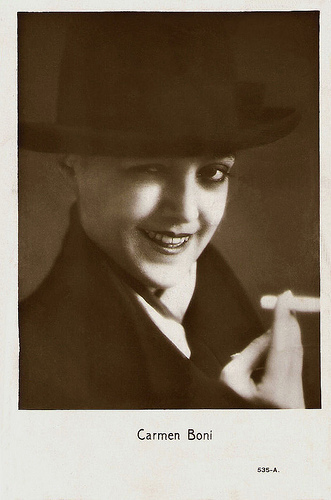
Italian postcard by G.B. Falci Editore, Milano, no. 535-A.
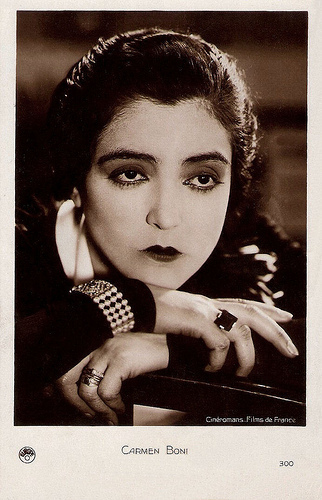
French postcard by Europe, no. 300. Photo: Cineromans / Films de France.
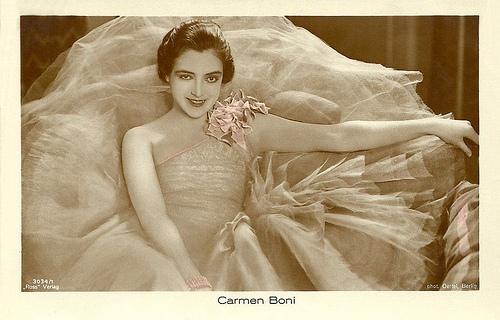
German postcard by Ross Verlag, no. 3034/1, 1928-1929. Photo: Oertel, Berlin.
The European Clara Bow
Carmen Boni was born as Maria Carmela Bonicatti in 1901 in Rome, Italy. She was the sister of cinematographer Mario Bonicatti.
In 1919, she made her first film appearance under her own name for Nova Film in La pecorella/The sheep (Pio Vanzi, 1920) with Ignazio Lupi .
Then she played in the Italian silent drama Ave Maria (Memmo Genua, Diana Karenne, 1920). For this film, she was still credited with her birth name. Diana Karenne suggested her to change her name, so enter Carmen Boni.
That year, the young actress also played leads in Miss Dorothy (Giulio Antamoro, 1920) with Lia Formia and Diana Karenne , Il fiore del Caucaso/The flower of the Caucasus (Augusto Camerini, 1920), and Monella di strada/Monella Street (Umberto Fracchia, 1920) opposite Romano Calò.
In the early 1920s, Boni had a successful career in the Italian cinema. She worked with director Guglielmo Zorzi at La preda/The prey (1921), La piccola ignota/The little unknown (1923), and Il riscatto/The redemption (1924) opposite André Habay and Lido Manetti .
A success was the comedy La dama de Chez Maxim's (Amleto Palermi, 1923) in which she co-starred with Pina Menichelli. It is an adaptation of the 1899 play La Dame de chez Maxim by Georges Feydeau.
With director Augusto Genina, she made La moglie bella/The beautiful wife (1924) with Ruggero Ruggeri , Il focolare spento/The hearth turned off (1925) with Lido Manetti , her international breakthrough L'ultimo lord/The last lord (1926) with Oreste Bilancia and Addio giovinezza!/Goodbye Youth (1927).
Addio giovinezza!/Goodbye Youth was adapted from the 1911 play of the same name by Nino Oxilia and Sandro Camasio. The film is set in Turin at the beginning of the Twentieth century, where a student ( Walter Slezak ) begins a romance with a seamstress Dorina (Boni). However, he is lured away by a sophisticated older woman ( Elena Sangro ) leaving Dorina distressed. Genina had previously directed an earlier version of the play in 1918. It was remade as a sound film of the same title in 1940.
These films were produced by Genina Film. Genina was both her Pygmalion and her husband. Together they moved to Germany when the Italian film industry got in a crisis in the mid 1920s and there were no possibilities anymore for Genina Film.
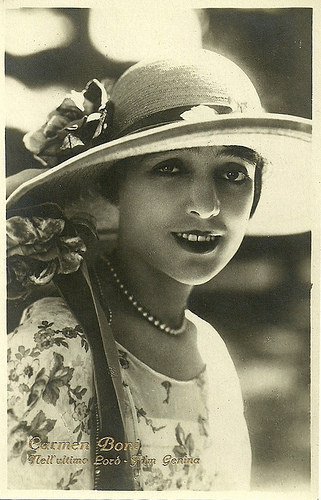
Italian postcard by Ed. G.B. Falci, no. 480. Photo: Film Genina. Carmen Boni in L'ultimo lord/The last lord (Augusto Genina, 1926).
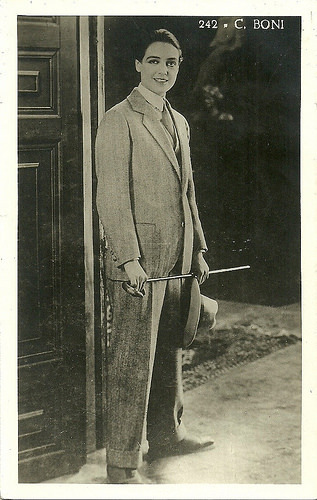
Italian postcard, no. 242. Card mailed in Italy in 1930. Photo: FotoEbung. Probably a publicity still for L'ultimo lord/The last lord (Augusto Genina, 1926).
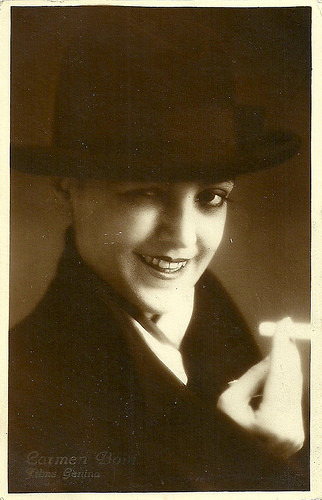
Italian postcard by G.B. Falci Ed., no. 688. Photo: Films Genina. Probably a publicity still for L'ultimo lord/The last lord (Augusto Genina, 1926).
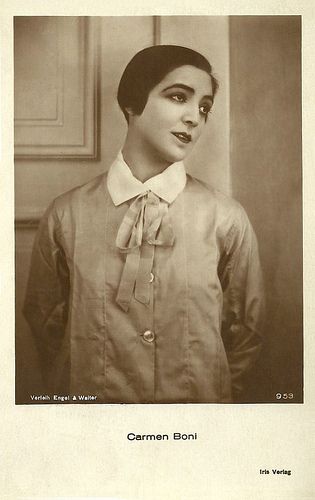
Austrian postcard by Iris Verlag, no. 953. Photo: Verleih Engel & Welter.
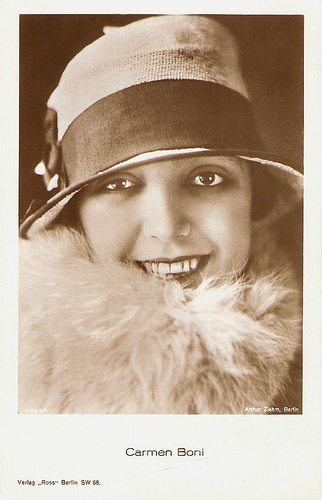
German postcard by Ross Verlag, no. 1783/1, 1927-1928. Photo: Arthur Ziehm, Berlin.
Suicide Attempt
Berlin was the European film capital at the time and Carmen Boni made one film after another during the late 1920s. Her German films include Venus im Frack/Venus in Tails (Robert Land, 1927) with Georg Alexander and Henri de Vries, Gehetzte Frauen (Richard Oswald, 1927) starring Asta Nielsen as Boni's mother, and Scampolo (Augusto Genina, 1928) in which she played a young Roman orphan.
Reviewer Luke-28 at IMDb : "An unpretentious but amazingly witty little comedy, Scampolo confirms Genina's special 'touch': a mix of subtle irony and social satire akin to Lubitsch's own bittersweet vision of the world. Scampolo also serves as a perfect vehicle for Carmen Boni's verve and comic skills."
With her verve and comic skills, Boni managed to switch from big laughter to genuine emotion with uncommon natural ease. Carmen Boni had a modern type of beauty, and she became the European equivalent of Hollywood stars like Clara Bow, Colleen Moore and Louise Brooks .
The last postcard in this post mentions the Karl Grune Film. This company only made one film with Carmen Boni: Katharina Knie (Karl Grune, 1929), based on the 1928 play of the same title by Carl Zuckmayer. Carmen Boni played the title role as the circus princess, with Eugen Klöpfer as her father. It was her last film in Germany.
After some more films in Italy, La Grazia/The Grace (Aldo De Benedetti, 1929), she moved to France where she performed in several Italian versions of Paramount films in the early 1930s, shot at the Paramount studio's in Joinville.
These films included the dramas Il richiamo del cuore/Appeal of the Heart (Jack Salvatori, 1930) and La vacanza del diavolo/The Devil's Holiday (Jack Salvatori, 1931).
In France, she also made with her husband the comedy La femme en home/The Woman Dressed As a Man (Augusto Genina, 1932) with Armand Bernard , and Ne sois pas jalousie/Don't be jealous (Augusto Genina, 1934). When Genina divorced her, she tried to commit suicide.
Then she focused on other things instead of cinema. In 1938 she married the French actor Jean Rigaux .
She returned in only two more French films. The first was the Swashbuckler Le comte de Monte Cristo, 2ème époque: Le châtiment/The Count of Monte Christo, Part II (Robert Vernay, Ferrucio Cerio, 1943) featuring Pierre Richard-Willm , and based on the classic novel by Alexandre Dumas père. Her final film was D'Homme à homme/Man to Men (Christian-Jaque, 1948), about the founder of the Red Cross, Henri Dunant, played by Jean-Louis Barrault .
In 1963 Carmen Boni was killed in Paris by a reckless car driver, while crossing a zebra path. She was 62.
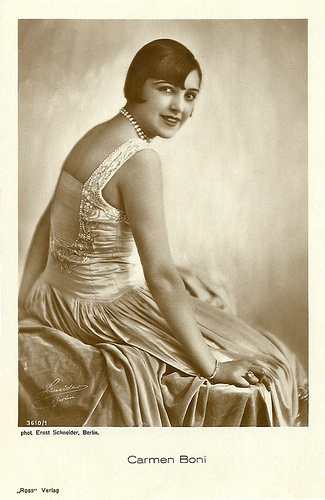
German postcard by Ross Verlag, no. 3610/1, 1928-1929. Photo: Ernst Schneider, Berlin.
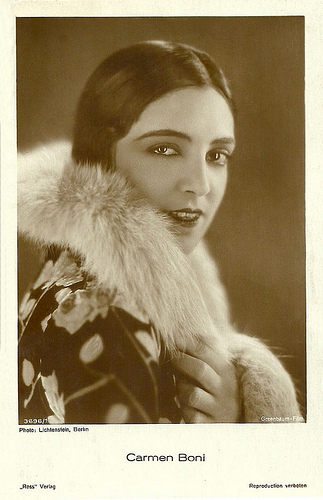
German postcard by Ross Verlag, no. 3696/1, 1928-1929. Photo Lichtenstein, Berlin / Greenbaum Film.
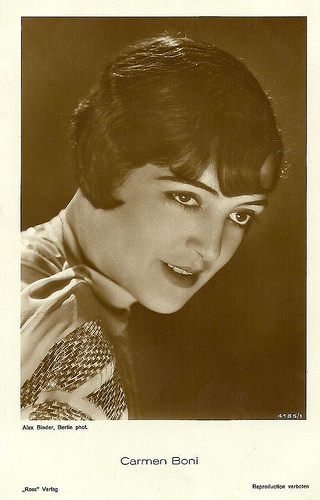
German postcard by Ross Verlag, no. 4185/1, 1929-1930. Photo: Alex Binder, Berlin.
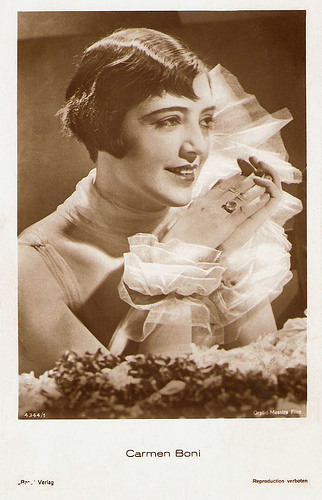
German postcard by Ross Verlag, no. 4344/1, 1929-1930. Photo: Orplid Messtro Film.
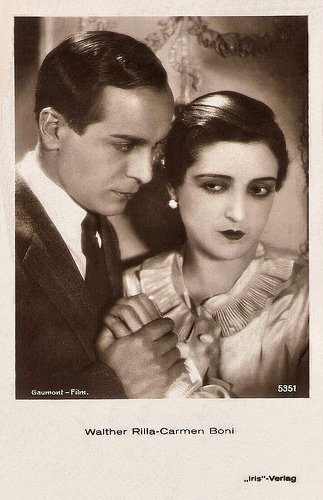
Austrian postcard by Iris-Verlag, no. 5351. Photo: Gaumont-Film. Publicity still for Prinzessin Olala/Princess Olala (Robert Land, 1928) with Walter Rilla .
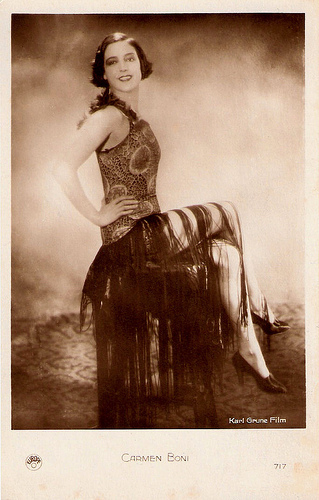
French postcard by Europe, no. 717. Photo: Karl Grune Film. Publicity still for Katharina Knie (Karl Grune, 1929).
Sources: Vittorio Martinelli (Le dive del silenzio - Italian), Luke-28 (IMDb), Wikipedia (English and Italian) and

Italian postcard by G.B. Falci Editore, Milano, no. 535-A.

French postcard by Europe, no. 300. Photo: Cineromans / Films de France.

German postcard by Ross Verlag, no. 3034/1, 1928-1929. Photo: Oertel, Berlin.
The European Clara Bow
Carmen Boni was born as Maria Carmela Bonicatti in 1901 in Rome, Italy. She was the sister of cinematographer Mario Bonicatti.
In 1919, she made her first film appearance under her own name for Nova Film in La pecorella/The sheep (Pio Vanzi, 1920) with Ignazio Lupi .
Then she played in the Italian silent drama Ave Maria (Memmo Genua, Diana Karenne, 1920). For this film, she was still credited with her birth name. Diana Karenne suggested her to change her name, so enter Carmen Boni.
That year, the young actress also played leads in Miss Dorothy (Giulio Antamoro, 1920) with Lia Formia and Diana Karenne , Il fiore del Caucaso/The flower of the Caucasus (Augusto Camerini, 1920), and Monella di strada/Monella Street (Umberto Fracchia, 1920) opposite Romano Calò.
In the early 1920s, Boni had a successful career in the Italian cinema. She worked with director Guglielmo Zorzi at La preda/The prey (1921), La piccola ignota/The little unknown (1923), and Il riscatto/The redemption (1924) opposite André Habay and Lido Manetti .
A success was the comedy La dama de Chez Maxim's (Amleto Palermi, 1923) in which she co-starred with Pina Menichelli. It is an adaptation of the 1899 play La Dame de chez Maxim by Georges Feydeau.
With director Augusto Genina, she made La moglie bella/The beautiful wife (1924) with Ruggero Ruggeri , Il focolare spento/The hearth turned off (1925) with Lido Manetti , her international breakthrough L'ultimo lord/The last lord (1926) with Oreste Bilancia and Addio giovinezza!/Goodbye Youth (1927).
Addio giovinezza!/Goodbye Youth was adapted from the 1911 play of the same name by Nino Oxilia and Sandro Camasio. The film is set in Turin at the beginning of the Twentieth century, where a student ( Walter Slezak ) begins a romance with a seamstress Dorina (Boni). However, he is lured away by a sophisticated older woman ( Elena Sangro ) leaving Dorina distressed. Genina had previously directed an earlier version of the play in 1918. It was remade as a sound film of the same title in 1940.
These films were produced by Genina Film. Genina was both her Pygmalion and her husband. Together they moved to Germany when the Italian film industry got in a crisis in the mid 1920s and there were no possibilities anymore for Genina Film.

Italian postcard by Ed. G.B. Falci, no. 480. Photo: Film Genina. Carmen Boni in L'ultimo lord/The last lord (Augusto Genina, 1926).

Italian postcard, no. 242. Card mailed in Italy in 1930. Photo: FotoEbung. Probably a publicity still for L'ultimo lord/The last lord (Augusto Genina, 1926).

Italian postcard by G.B. Falci Ed., no. 688. Photo: Films Genina. Probably a publicity still for L'ultimo lord/The last lord (Augusto Genina, 1926).

Austrian postcard by Iris Verlag, no. 953. Photo: Verleih Engel & Welter.

German postcard by Ross Verlag, no. 1783/1, 1927-1928. Photo: Arthur Ziehm, Berlin.
Suicide Attempt
Berlin was the European film capital at the time and Carmen Boni made one film after another during the late 1920s. Her German films include Venus im Frack/Venus in Tails (Robert Land, 1927) with Georg Alexander and Henri de Vries, Gehetzte Frauen (Richard Oswald, 1927) starring Asta Nielsen as Boni's mother, and Scampolo (Augusto Genina, 1928) in which she played a young Roman orphan.
Reviewer Luke-28 at IMDb : "An unpretentious but amazingly witty little comedy, Scampolo confirms Genina's special 'touch': a mix of subtle irony and social satire akin to Lubitsch's own bittersweet vision of the world. Scampolo also serves as a perfect vehicle for Carmen Boni's verve and comic skills."
With her verve and comic skills, Boni managed to switch from big laughter to genuine emotion with uncommon natural ease. Carmen Boni had a modern type of beauty, and she became the European equivalent of Hollywood stars like Clara Bow, Colleen Moore and Louise Brooks .
The last postcard in this post mentions the Karl Grune Film. This company only made one film with Carmen Boni: Katharina Knie (Karl Grune, 1929), based on the 1928 play of the same title by Carl Zuckmayer. Carmen Boni played the title role as the circus princess, with Eugen Klöpfer as her father. It was her last film in Germany.
After some more films in Italy, La Grazia/The Grace (Aldo De Benedetti, 1929), she moved to France where she performed in several Italian versions of Paramount films in the early 1930s, shot at the Paramount studio's in Joinville.
These films included the dramas Il richiamo del cuore/Appeal of the Heart (Jack Salvatori, 1930) and La vacanza del diavolo/The Devil's Holiday (Jack Salvatori, 1931).
In France, she also made with her husband the comedy La femme en home/The Woman Dressed As a Man (Augusto Genina, 1932) with Armand Bernard , and Ne sois pas jalousie/Don't be jealous (Augusto Genina, 1934). When Genina divorced her, she tried to commit suicide.
Then she focused on other things instead of cinema. In 1938 she married the French actor Jean Rigaux .
She returned in only two more French films. The first was the Swashbuckler Le comte de Monte Cristo, 2ème époque: Le châtiment/The Count of Monte Christo, Part II (Robert Vernay, Ferrucio Cerio, 1943) featuring Pierre Richard-Willm , and based on the classic novel by Alexandre Dumas père. Her final film was D'Homme à homme/Man to Men (Christian-Jaque, 1948), about the founder of the Red Cross, Henri Dunant, played by Jean-Louis Barrault .
In 1963 Carmen Boni was killed in Paris by a reckless car driver, while crossing a zebra path. She was 62.

German postcard by Ross Verlag, no. 3610/1, 1928-1929. Photo: Ernst Schneider, Berlin.

German postcard by Ross Verlag, no. 3696/1, 1928-1929. Photo Lichtenstein, Berlin / Greenbaum Film.

German postcard by Ross Verlag, no. 4185/1, 1929-1930. Photo: Alex Binder, Berlin.

German postcard by Ross Verlag, no. 4344/1, 1929-1930. Photo: Orplid Messtro Film.

Austrian postcard by Iris-Verlag, no. 5351. Photo: Gaumont-Film. Publicity still for Prinzessin Olala/Princess Olala (Robert Land, 1928) with Walter Rilla .

French postcard by Europe, no. 717. Photo: Karl Grune Film. Publicity still for Katharina Knie (Karl Grune, 1929).
Sources: Vittorio Martinelli (Le dive del silenzio - Italian), Luke-28 (IMDb), Wikipedia (English and Italian) and
Published on February 23, 2015 22:00
February 22, 2015
Leny Marenbach
Lady-like Leny Marenbach (1907–1984) was one of the leading Ufa stars in the Nazi era. The German actress appeared in several popular comedies with Heinz Rühmann, like the hit Der Mustergatte/The Model Husband (1937). After the Second World War, she only played in a few films for the DEFA.

German postcard by Film-Foto-Verlag, no. G 138, 1941-1944. Photo: Star-Photo-Atelier.
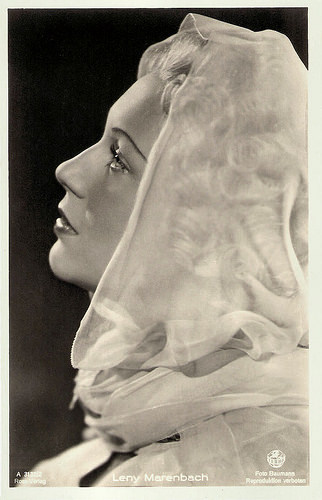
German postcard by Film-Foto-Verlag, no. A 3132/2, 1941-1944. Photo: Baumann / Terra.
A dream couple of the German cinema
Leni Marenbach was born in Essen in the German Empire in 1907. At the age of 16, she had her debut at the Schauspielhaus Essen, where she played Clara in Goethe’s Egmont and Luise in Schiller’s Kabale und Liebe.
She then spent three years at the Schauspielhaus Zurich, followed by engagements in Darmstadt, at the Theater in der Josefstadt in Vienna and at the Kammerspiele in Munich.
In 1935, she made her film debut in Prague as Jana in the German-language film Jana, das Mädchen aus dem Böhmerwald/Jana, the Girl from the Bohemian Forest (Robert Land, 1935).
The following year, she played Heinz Rühmann ’s wife in the comedy Wenn wir alle Engel wären/If We All Were Angels (Carl Froelich, 1936). Rühmann was Germany's number one box-office star in these years.
The film was her breakthrough and for a time she and Rühmann were a dream couple of the German cinema. Also privately, they were a couple.
She played the female lead in the adventure film Alarm in Peking (Herbert Selpin, 1937) opposite Gustav Fröhlich , and Peter Voß. This propaganda film is set against the backdrop of the 1900 Boxer Rebellion in China. German filmmakers had frequently used China as a setting since the 1910s, but from 1931 onwards they made a series of films with political overtones. After the war the film was forbidden.
A huge success was the comedy Der Mustergatte/The Model Husband (Wolfgang Liebeneiner, 1937), in which she co-starred with Heinz Rühmann and Hans Söhnker . The comedy was screened at the Venice Film Festival where it won an award, and in the 1950s it was remade twice.
Marenbach and Rühmann were again a couple in the comedy Fünf Millionen suchen einen Erben/Five Million Look for an Heir (Carl Boese, 1938).
Her next film, Ziel in den Wolken/Target in the Clouds (Wolfgang Liebeneiner, 1939) is a drama featuring Albert Matterstock as the German aviation pioneer Walter von Suhr, an officer in the pre-First World War German army who saw the potential for military aircraft.
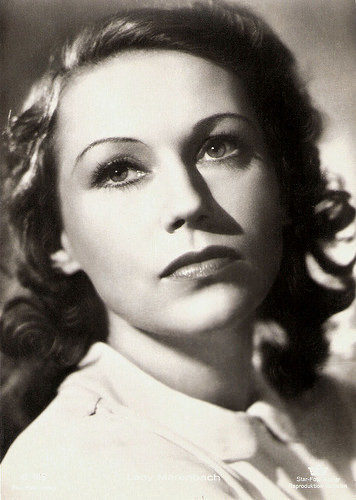
German postcard by Film-Foto-Verlag, no. G 186, 1941-1944. Photo: Star-Photo-Atelier / Tobis.
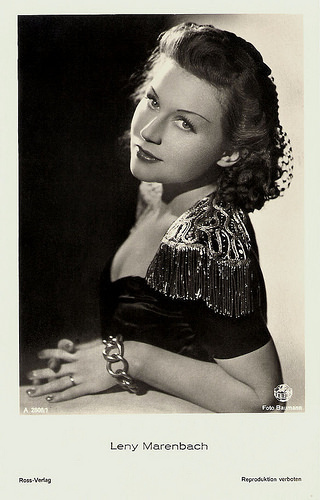
German postcard by Ross-Verlag, no. A 2808/1, 1939-1940. Photo: Baumann / Terra.
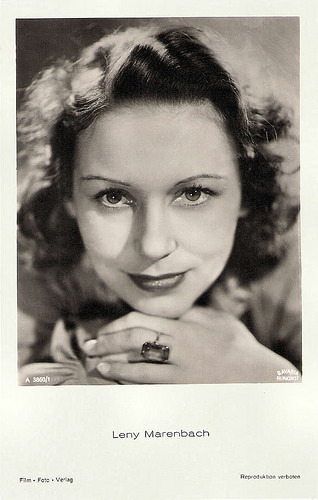
German postcard by Film-Foto-Verlag, no. A 3860/1, 1941-1944. Photo: Bavaria Filmkunst.
Sympathetic naturalness
Leny Marenbach was loved by the German public for her sympathetic naturalness. I.S. Mowis describes her at IMDb as ‘Germany's answer to Irene Dunne’: “She seemed to have little artifice about her and was therefore ideally suited to play gentle, impeccably well-mannered model wives or brave battlers against the forces of adversity. In more emancipated mode, she added a much-needed sparkle to assorted mainstream melodramas and could also occasionally display a deft talent for comedy.”
Leny showcased her versatility as a dramatic actress in her dual role in Frau nach Maß/Woman-to-measure (Helmut Käutner, 1940) opposite Hans Söhnker . The film was written under pseudonym by Erich Kästner.
During the war years, she got star billing even if she played only a supporting part such as in Friedemann Bach (Traugott Müller, Gustaf Gründgens, 1941). This biopic depicts the life of Johann Sebastian Bach's gifted son Wilhelm Friedemann Bach ( Gustav Gründgens ), who tries to escape his father's shadow.
In Ein Zug fährt ab/A train leaves (Johannes Guter,1942) her co-star was Ferdinand Marian , in the comedy Die Wirtin zum Weißen Rößl/The landlady of the White Horse Inn (Karl Anton, 1943) she appeared opposite Karl Schönböck , and in the comedy Wildvogel/Wild-Bird (Johannes Meyer, 1943) with Volker von Collande.
In 1944 she appeared with Carl Raddatz and Hansi Knoteck in the Heimatfilm Das war mein Leben/That was my life (Paul Martin, 1944). The family comedy Wie sagen wir es unseren Kindern?/How do we say so to our children? (Hans Deppe, 1945) with Mathias Wieman, only reached the cinemas after the war, in 1949.
After World War II, Marenbach’s popularity declined. In 1949 she appeared with Willy Fritsch in the musical comedy Hallo – Sie haben Ihre Frau vergessen/Hello – You have forgotten your wife (Kurt E. Walter, 1949).
In 1952, she received a contract by the DEFA (Deutsche Film-Aktiengesellschaft), the state-owned film studio in the German Democratic Republic (East Germany). Among her East-German films are the spy thriller Geheimakten Solvay/Secret Files of Solvay (Martin Hellberg, 1953) and the comedy Wer seine Frau lieb hat/Who loves his wife (Kurt Jung-Alsen,1955) with Albert Garbe.
Geheimakten Solvay aroused criticism in the West for its blatant propagandist content. Because of her East-German work, she was not offered film roles in West-Germany.
Marenbach played theatre in Berlin. On West-German TV, she could be seen in a few series like Am grünen Strand der Spree/On the green beach of the river Spree (Fritz Umgelter, 1960).
At the end of the 1960s, she retired from show business. She was briefly married with the cameraman Walter Pindter and had a son with him.
Leny Marenbach died of heart failure in West-Berlin, West-Germany in 1984.
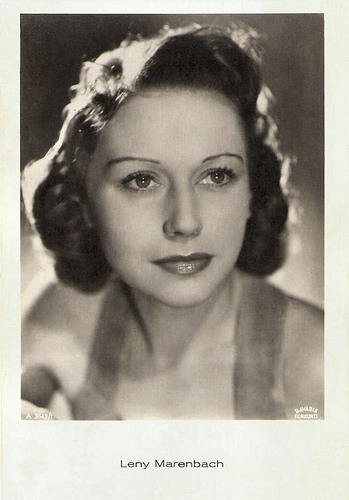
German postcard, no. A 3643/1, 1941-1944. Photo: Bavaria Filmkunst.
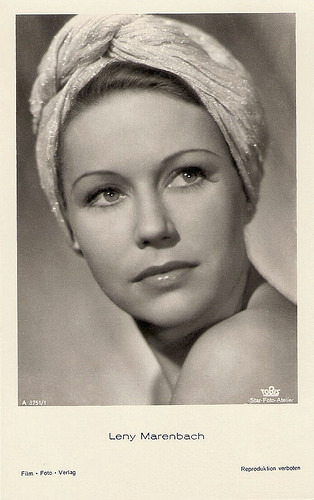
German postcard by Film-Foto-Verlag, no. A 3751/1, 1941-1944. Photo: Tobis / Star-Foto-Atelier.
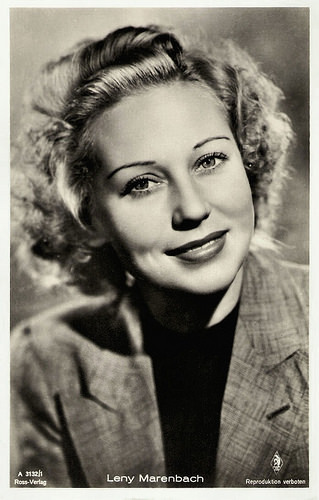
German postcard by Ross Verlag, no. A 3132/1, 1941-1944.
Sources: Stephanie D’heil (Steffi-line – German), Thomas Staedeli (Cyranos), Film-Zeit.de (German), Defa-stiftung (German), Wikipedia (German and English) and .

German postcard by Film-Foto-Verlag, no. G 138, 1941-1944. Photo: Star-Photo-Atelier.

German postcard by Film-Foto-Verlag, no. A 3132/2, 1941-1944. Photo: Baumann / Terra.
A dream couple of the German cinema
Leni Marenbach was born in Essen in the German Empire in 1907. At the age of 16, she had her debut at the Schauspielhaus Essen, where she played Clara in Goethe’s Egmont and Luise in Schiller’s Kabale und Liebe.
She then spent three years at the Schauspielhaus Zurich, followed by engagements in Darmstadt, at the Theater in der Josefstadt in Vienna and at the Kammerspiele in Munich.
In 1935, she made her film debut in Prague as Jana in the German-language film Jana, das Mädchen aus dem Böhmerwald/Jana, the Girl from the Bohemian Forest (Robert Land, 1935).
The following year, she played Heinz Rühmann ’s wife in the comedy Wenn wir alle Engel wären/If We All Were Angels (Carl Froelich, 1936). Rühmann was Germany's number one box-office star in these years.
The film was her breakthrough and for a time she and Rühmann were a dream couple of the German cinema. Also privately, they were a couple.
She played the female lead in the adventure film Alarm in Peking (Herbert Selpin, 1937) opposite Gustav Fröhlich , and Peter Voß. This propaganda film is set against the backdrop of the 1900 Boxer Rebellion in China. German filmmakers had frequently used China as a setting since the 1910s, but from 1931 onwards they made a series of films with political overtones. After the war the film was forbidden.
A huge success was the comedy Der Mustergatte/The Model Husband (Wolfgang Liebeneiner, 1937), in which she co-starred with Heinz Rühmann and Hans Söhnker . The comedy was screened at the Venice Film Festival where it won an award, and in the 1950s it was remade twice.
Marenbach and Rühmann were again a couple in the comedy Fünf Millionen suchen einen Erben/Five Million Look for an Heir (Carl Boese, 1938).
Her next film, Ziel in den Wolken/Target in the Clouds (Wolfgang Liebeneiner, 1939) is a drama featuring Albert Matterstock as the German aviation pioneer Walter von Suhr, an officer in the pre-First World War German army who saw the potential for military aircraft.

German postcard by Film-Foto-Verlag, no. G 186, 1941-1944. Photo: Star-Photo-Atelier / Tobis.

German postcard by Ross-Verlag, no. A 2808/1, 1939-1940. Photo: Baumann / Terra.

German postcard by Film-Foto-Verlag, no. A 3860/1, 1941-1944. Photo: Bavaria Filmkunst.
Sympathetic naturalness
Leny Marenbach was loved by the German public for her sympathetic naturalness. I.S. Mowis describes her at IMDb as ‘Germany's answer to Irene Dunne’: “She seemed to have little artifice about her and was therefore ideally suited to play gentle, impeccably well-mannered model wives or brave battlers against the forces of adversity. In more emancipated mode, she added a much-needed sparkle to assorted mainstream melodramas and could also occasionally display a deft talent for comedy.”
Leny showcased her versatility as a dramatic actress in her dual role in Frau nach Maß/Woman-to-measure (Helmut Käutner, 1940) opposite Hans Söhnker . The film was written under pseudonym by Erich Kästner.
During the war years, she got star billing even if she played only a supporting part such as in Friedemann Bach (Traugott Müller, Gustaf Gründgens, 1941). This biopic depicts the life of Johann Sebastian Bach's gifted son Wilhelm Friedemann Bach ( Gustav Gründgens ), who tries to escape his father's shadow.
In Ein Zug fährt ab/A train leaves (Johannes Guter,1942) her co-star was Ferdinand Marian , in the comedy Die Wirtin zum Weißen Rößl/The landlady of the White Horse Inn (Karl Anton, 1943) she appeared opposite Karl Schönböck , and in the comedy Wildvogel/Wild-Bird (Johannes Meyer, 1943) with Volker von Collande.
In 1944 she appeared with Carl Raddatz and Hansi Knoteck in the Heimatfilm Das war mein Leben/That was my life (Paul Martin, 1944). The family comedy Wie sagen wir es unseren Kindern?/How do we say so to our children? (Hans Deppe, 1945) with Mathias Wieman, only reached the cinemas after the war, in 1949.
After World War II, Marenbach’s popularity declined. In 1949 she appeared with Willy Fritsch in the musical comedy Hallo – Sie haben Ihre Frau vergessen/Hello – You have forgotten your wife (Kurt E. Walter, 1949).
In 1952, she received a contract by the DEFA (Deutsche Film-Aktiengesellschaft), the state-owned film studio in the German Democratic Republic (East Germany). Among her East-German films are the spy thriller Geheimakten Solvay/Secret Files of Solvay (Martin Hellberg, 1953) and the comedy Wer seine Frau lieb hat/Who loves his wife (Kurt Jung-Alsen,1955) with Albert Garbe.
Geheimakten Solvay aroused criticism in the West for its blatant propagandist content. Because of her East-German work, she was not offered film roles in West-Germany.
Marenbach played theatre in Berlin. On West-German TV, she could be seen in a few series like Am grünen Strand der Spree/On the green beach of the river Spree (Fritz Umgelter, 1960).
At the end of the 1960s, she retired from show business. She was briefly married with the cameraman Walter Pindter and had a son with him.
Leny Marenbach died of heart failure in West-Berlin, West-Germany in 1984.

German postcard, no. A 3643/1, 1941-1944. Photo: Bavaria Filmkunst.

German postcard by Film-Foto-Verlag, no. A 3751/1, 1941-1944. Photo: Tobis / Star-Foto-Atelier.

German postcard by Ross Verlag, no. A 3132/1, 1941-1944.
Sources: Stephanie D’heil (Steffi-line – German), Thomas Staedeli (Cyranos), Film-Zeit.de (German), Defa-stiftung (German), Wikipedia (German and English) and .
Published on February 22, 2015 22:00
February 21, 2015
12 European Oscar Winners
Tonight is the 87th Academy Awards ceremony. The Academy Awards, better known as The Oscars, were first presented in 1929 at the Hollywood Roosevelt Hotel, and are seen now as the most prestigious cinema awards ceremony in the world. This year, the Brits Benedict Cumberbatch (for his portrayal of Alan Turing in The Imitation Game) and Eddie Redmayne (for his role as Stephen Hawking in The Theory of Everything) are nominated as Best Actor in a Leading Role. As Best Actress in a Leading Role are nominated French Marion Cotillard (for Two Days, One Night), British Felicity Jones (for The Theory of Everything) and British Rosamund Pike (for Gone Girl). Through the years many European Film Stars have won an Oscar: so today at EFSP 12 postcards of European winners from the past.
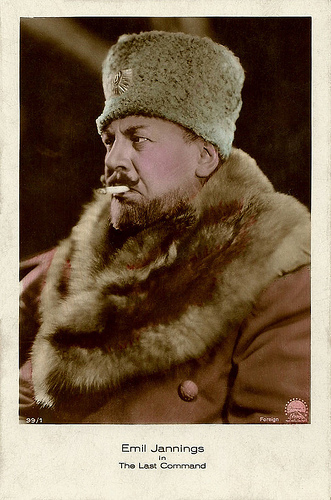
1927-1928: Emil Jannings won for both The Last Command and The Way of All Flesh. German postcard by Ross Verlag, Foreign, no. 99/1. Photo: Paramount. Publicity still for The Last Command (Josef von Sternberg, 1928). Jannings received the award at the 1st Academy Awards ceremony ever held. In the first three years of the awards, actors were nominated as the best in their categories. At that time, all of their work during the qualifying period (as many as three films, in some cases) was listed after the award.
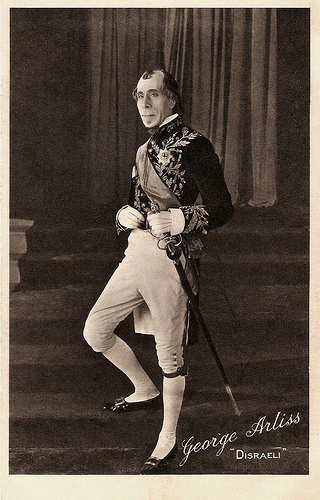
1929-1930: George Arliss won for Disraeli. Vintage postcard. Photo: publicity still for Disraeli (Alfred E. Green, 1929). During the 3rd ceremony held in 1930, only one of the films was cited in each winner's final award, even though each of the acting winners had two films following their names on the ballots. For Arliss it was The Green Goddess. Both films were based on hit stage plays in which Arliss had starred. The following year, this unwieldy and confusing award system was replaced by the current system in which an actor is nominated for a specific performance in a single film.
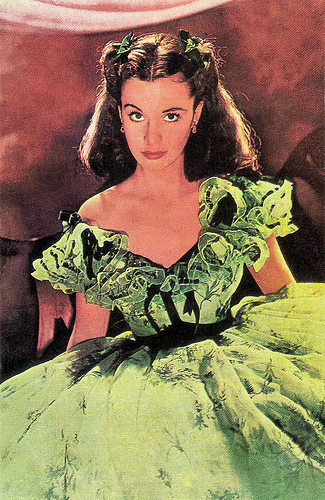
1939: Vivien Leigh won for Gone with the Wind. Romanian postcard by Casa Filmului Acin. Photo: MGM. Publicity still for Gone with the Wind (Victor Flemyng, 1939). Gone with the Wind brought Leigh immediate attention and fame. The film won 10 Academy Awards including a Best Actress award for Leigh, who also won a New York Film Critics Circle Award for Best Actress. She won another Oscar for her role as Blanche DuBois in the film version of A Streetcar Named Desire (Elia Kazan, 1951).
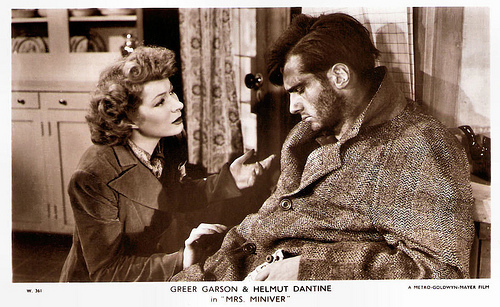
1942: Greer Garson won for Mrs. Miniver. British postcard in the Picturegoer Series, London, nr. W 361. Photo: MGM. Publicity still for Mrs. Miniver (1942) with Helmut Dantine. As one of MGM's major stars during the 1940s, Garson received seven Academy Award nominations, including a record five consecutive nominations, winning the Best Actress award for Mrs. Miniver (1942).
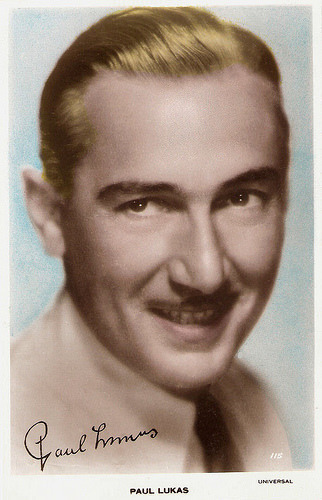
1943: Paul Lukas won for Watch on the Rhine. British Art Photo postcard, no. 115. Photo: Universal. In Watch on the Rhine (Herman Shumlin, 1943), Lukas played a man working against the Nazis, a role he originated in the Broadway premiere of the play of the same name in 1941. His portrayal of Kurt Mueller, a German émigré with an American wife, played by Bette Davis, was universally lauded by critics. He won out over luminary efforts as Humphrey Bogart in Casablanca, and Gary Cooper in For Whom the Bell Tolls.
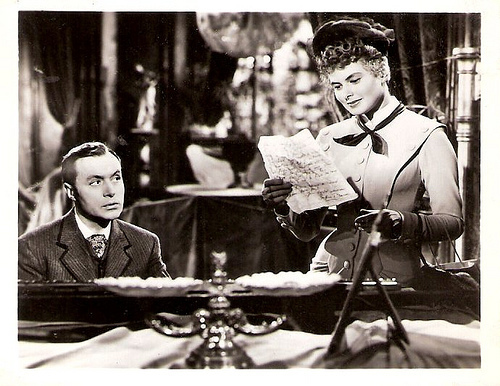
1944: Ingrid Bergman for Gaslight. Small card. Photo: MGM. Photo: still for Gaslight (George Cukor, 1944) with Charles Boyer . Bergman won three Academy Awards, two Emmy Awards, four Golden Globe Awards and the Tony Award for Best Actress. In 1944, she won her first Academy Award for Best Actress for Gaslight (George Cukor, 1944), a film in which George Cukor directed her as a wife driven close to madness by co-star Boyer.
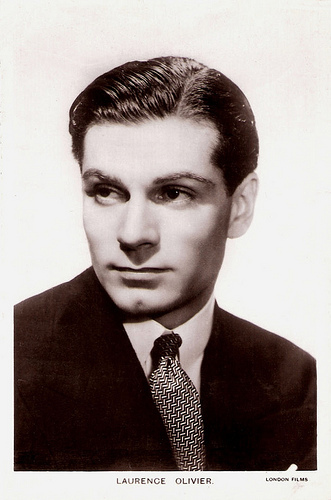
1948: Laurence Olivier won for Hamlet. British postcard in the Picturegoer Series, London, no. 695b. Photo: London Films. Hamlet was part of a trilogy of Shakespeare films Olivier made as actor-director: Henry V (1944), Hamlet (1948), and Richard III (1955). Hamlet became the first non-American film to win the Academy Award for Best Picture.
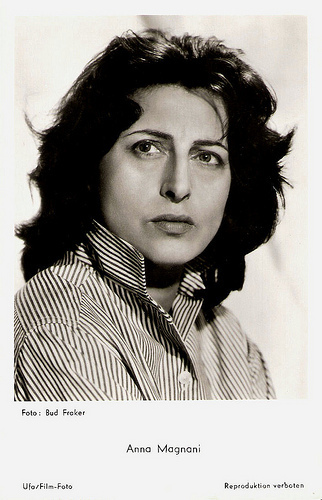
1955: Anna Magnani won for The Rose Tattoo. German postcard by Ufa, Berlin-Tempelhof, no. FK 4136. Photo: Bud Fraker. Magnani won the Oscar along with four other international awards, for her portrayal of a Sicilian widow in The Rose Tattoo (Daniel Mann, 1955), based on the play by Tennessee Williams. It co-starred Burt Lancaster, and was Magnani's first English speaking role in a mainstream Hollywood movie.
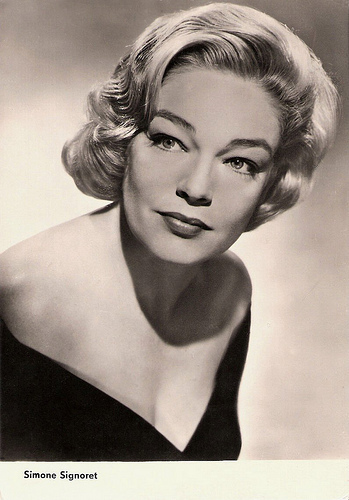
1959: Simone Signoret for Room at the Top. East-German postcard by VEB Progress Film-Vertrieb, Berlin, no. 1412. Signoret was the only French cinema actress to receive an Oscar until Juliette Binoche in 1997 (Supporting Actress) and Marion Cotillard in 2008 (Best Actress), and the first woman to win the award appearing in a foreign film, Room at the Top (1959). In her lifetime, Signoret also received a César, three BAFTAs, an Emmy, Cannes Film Festival recognition, the Silver Bear for Best Actress awards and a Golden Globe nomination.
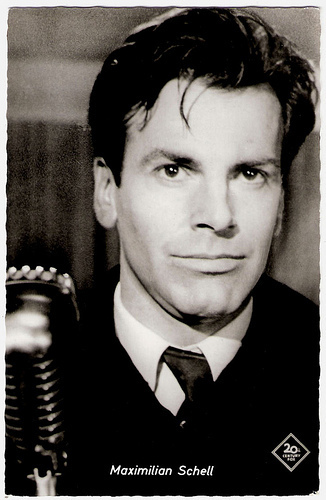
1961: Maximilian Schell for Judgement at Nuremberg. German postcard by Friedr. W. Sander-Verlag, Minden/Kolbri-Karte, no. 2005. Photo: 20th Century Fox. Publicity still for Judgment at Nuremberg (Stanley Kramer, 1961). For Schell, his part as an attorney in Judgment at Nuremberg, a fictionalized re-creation of the Nuremberg War Trials, was his second acting role in Hollywood. In 1959, he had already played the same role on TV in an edition of Playhouse 90 a live TV production of Judgment at Nuremberg. His performance in the TV drama was considered so good that he was selected to play the same part in the film version. His Oscar was the first win for a German-speaking actor since World War II.
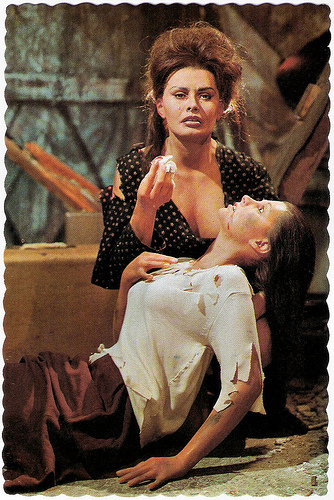
1961: Sophia Loren for La ciociara/Two Women. American postcard by Movieland Wax Museum, Buena Park. Photo: Mike Roberts. Wax figures of Sophia Loren and Eleonor Brown in La ciociara/Two Women (1960). Loren donated the tattered dress she wore during filming of La ciociara for her figure to wear at Movieland. Loren's performance as Cesira in Vittorio De Sica's La ciociara made her the first artist to win an Oscar for a foreign-language performance. She holds the record for having earned six David di Donatello Awards for Best Actress, the most ever received: La ciociara/Two Women(Vittorio De Sica, 1960), Yesterday, Ieri, oggi, domani/Yesterday, Today And Tomorrow (Vittorio De Sica, 1963), Matrimonio all'Italiana/Marriage Italian Style (Vittorio De Sica, 1964) for which she was nominated for a second Oscar, I Girasoli/The Sunflowers (Vittorio De Sica, 1972), Il Viaggio/The Voyage (Vittorio De Sica, 1974) and Una giornata particolare/A Special Day (Ettore Scola, 1977).

1964: Julie Andrews for Mary Poppins. French postcard by Les Presses de Belleville, no.107. Photo: Walt Disney Productions. Still from Mary Poppins (1964). British Julie Andrews made her feature film debut in Mary Poppins (Robert Stevenson, 1964). The following year, she received her second Academy Award nomination for The Sound of Music (Robert Wise, 1965), and won the Golden Globe Award for Best Actress in a Musical.
Since its inception, the Best Actor award has been given to 77 actors. Daniel Day-Lewis has received the most awards in this category with three Oscars. Spencer Tracy and Laurence Olivier were nominated on nine occasions, more than any other actor. There have been two years in which all four of the top acting Academy Awards were presented to Europeans. At the 37th Academy Awards (1964), the winners were Rex Harrison (British), Julie Andrews (British), Peter Ustinov (British), and Lila Kedrova (Russian-born French). At the 80th Academy Awards (2007), the winners were Daniel Day-Lewis (British and Irish), Marion Cotillard (French), Javier Bardem (Spanish), and Tilda Swinton (British).
Source: Wikipedia.

1927-1928: Emil Jannings won for both The Last Command and The Way of All Flesh. German postcard by Ross Verlag, Foreign, no. 99/1. Photo: Paramount. Publicity still for The Last Command (Josef von Sternberg, 1928). Jannings received the award at the 1st Academy Awards ceremony ever held. In the first three years of the awards, actors were nominated as the best in their categories. At that time, all of their work during the qualifying period (as many as three films, in some cases) was listed after the award.

1929-1930: George Arliss won for Disraeli. Vintage postcard. Photo: publicity still for Disraeli (Alfred E. Green, 1929). During the 3rd ceremony held in 1930, only one of the films was cited in each winner's final award, even though each of the acting winners had two films following their names on the ballots. For Arliss it was The Green Goddess. Both films were based on hit stage plays in which Arliss had starred. The following year, this unwieldy and confusing award system was replaced by the current system in which an actor is nominated for a specific performance in a single film.

1939: Vivien Leigh won for Gone with the Wind. Romanian postcard by Casa Filmului Acin. Photo: MGM. Publicity still for Gone with the Wind (Victor Flemyng, 1939). Gone with the Wind brought Leigh immediate attention and fame. The film won 10 Academy Awards including a Best Actress award for Leigh, who also won a New York Film Critics Circle Award for Best Actress. She won another Oscar for her role as Blanche DuBois in the film version of A Streetcar Named Desire (Elia Kazan, 1951).

1942: Greer Garson won for Mrs. Miniver. British postcard in the Picturegoer Series, London, nr. W 361. Photo: MGM. Publicity still for Mrs. Miniver (1942) with Helmut Dantine. As one of MGM's major stars during the 1940s, Garson received seven Academy Award nominations, including a record five consecutive nominations, winning the Best Actress award for Mrs. Miniver (1942).

1943: Paul Lukas won for Watch on the Rhine. British Art Photo postcard, no. 115. Photo: Universal. In Watch on the Rhine (Herman Shumlin, 1943), Lukas played a man working against the Nazis, a role he originated in the Broadway premiere of the play of the same name in 1941. His portrayal of Kurt Mueller, a German émigré with an American wife, played by Bette Davis, was universally lauded by critics. He won out over luminary efforts as Humphrey Bogart in Casablanca, and Gary Cooper in For Whom the Bell Tolls.

1944: Ingrid Bergman for Gaslight. Small card. Photo: MGM. Photo: still for Gaslight (George Cukor, 1944) with Charles Boyer . Bergman won three Academy Awards, two Emmy Awards, four Golden Globe Awards and the Tony Award for Best Actress. In 1944, she won her first Academy Award for Best Actress for Gaslight (George Cukor, 1944), a film in which George Cukor directed her as a wife driven close to madness by co-star Boyer.

1948: Laurence Olivier won for Hamlet. British postcard in the Picturegoer Series, London, no. 695b. Photo: London Films. Hamlet was part of a trilogy of Shakespeare films Olivier made as actor-director: Henry V (1944), Hamlet (1948), and Richard III (1955). Hamlet became the first non-American film to win the Academy Award for Best Picture.

1955: Anna Magnani won for The Rose Tattoo. German postcard by Ufa, Berlin-Tempelhof, no. FK 4136. Photo: Bud Fraker. Magnani won the Oscar along with four other international awards, for her portrayal of a Sicilian widow in The Rose Tattoo (Daniel Mann, 1955), based on the play by Tennessee Williams. It co-starred Burt Lancaster, and was Magnani's first English speaking role in a mainstream Hollywood movie.

1959: Simone Signoret for Room at the Top. East-German postcard by VEB Progress Film-Vertrieb, Berlin, no. 1412. Signoret was the only French cinema actress to receive an Oscar until Juliette Binoche in 1997 (Supporting Actress) and Marion Cotillard in 2008 (Best Actress), and the first woman to win the award appearing in a foreign film, Room at the Top (1959). In her lifetime, Signoret also received a César, three BAFTAs, an Emmy, Cannes Film Festival recognition, the Silver Bear for Best Actress awards and a Golden Globe nomination.

1961: Maximilian Schell for Judgement at Nuremberg. German postcard by Friedr. W. Sander-Verlag, Minden/Kolbri-Karte, no. 2005. Photo: 20th Century Fox. Publicity still for Judgment at Nuremberg (Stanley Kramer, 1961). For Schell, his part as an attorney in Judgment at Nuremberg, a fictionalized re-creation of the Nuremberg War Trials, was his second acting role in Hollywood. In 1959, he had already played the same role on TV in an edition of Playhouse 90 a live TV production of Judgment at Nuremberg. His performance in the TV drama was considered so good that he was selected to play the same part in the film version. His Oscar was the first win for a German-speaking actor since World War II.

1961: Sophia Loren for La ciociara/Two Women. American postcard by Movieland Wax Museum, Buena Park. Photo: Mike Roberts. Wax figures of Sophia Loren and Eleonor Brown in La ciociara/Two Women (1960). Loren donated the tattered dress she wore during filming of La ciociara for her figure to wear at Movieland. Loren's performance as Cesira in Vittorio De Sica's La ciociara made her the first artist to win an Oscar for a foreign-language performance. She holds the record for having earned six David di Donatello Awards for Best Actress, the most ever received: La ciociara/Two Women(Vittorio De Sica, 1960), Yesterday, Ieri, oggi, domani/Yesterday, Today And Tomorrow (Vittorio De Sica, 1963), Matrimonio all'Italiana/Marriage Italian Style (Vittorio De Sica, 1964) for which she was nominated for a second Oscar, I Girasoli/The Sunflowers (Vittorio De Sica, 1972), Il Viaggio/The Voyage (Vittorio De Sica, 1974) and Una giornata particolare/A Special Day (Ettore Scola, 1977).

1964: Julie Andrews for Mary Poppins. French postcard by Les Presses de Belleville, no.107. Photo: Walt Disney Productions. Still from Mary Poppins (1964). British Julie Andrews made her feature film debut in Mary Poppins (Robert Stevenson, 1964). The following year, she received her second Academy Award nomination for The Sound of Music (Robert Wise, 1965), and won the Golden Globe Award for Best Actress in a Musical.
Since its inception, the Best Actor award has been given to 77 actors. Daniel Day-Lewis has received the most awards in this category with three Oscars. Spencer Tracy and Laurence Olivier were nominated on nine occasions, more than any other actor. There have been two years in which all four of the top acting Academy Awards were presented to Europeans. At the 37th Academy Awards (1964), the winners were Rex Harrison (British), Julie Andrews (British), Peter Ustinov (British), and Lila Kedrova (Russian-born French). At the 80th Academy Awards (2007), the winners were Daniel Day-Lewis (British and Irish), Marion Cotillard (French), Javier Bardem (Spanish), and Tilda Swinton (British).
Source: Wikipedia.
Published on February 21, 2015 22:00
February 20, 2015
Le Petit Poucet (1972)
The classic fairy-tale story Le Petit Poucet/Little Thumb by Charles Perrault has been filmed several times. In 1972, well-known French director Michel Boisrond made Le Petit Poucet, a poetic film adaptation with the young Jean-Christophe Maillot as Little Tom Thumb and legendary French singer Marie Laforêt as the elegant Queen.
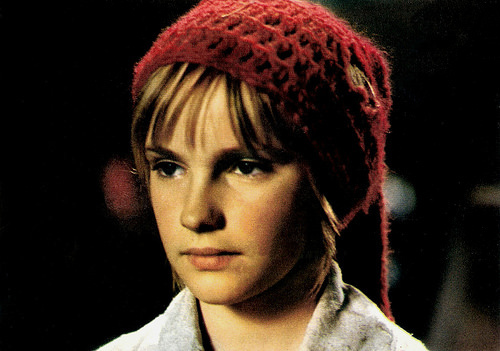
French postcard by Librairie Hachette, Paris, no. 11. Photo: Parc Film Navarre & associés. Publicity still for Le Petit Poucet/Tom Thumb (Michel Boisrond, 1972) with Jean-Christophe Maillot.
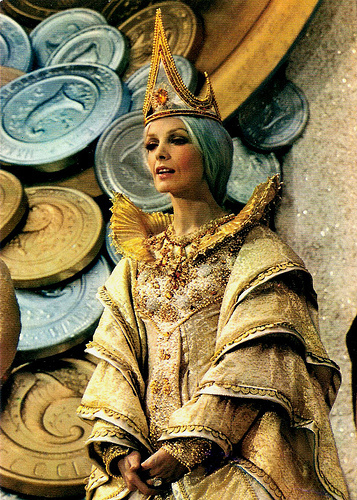
French postcard by Librairie Hachette, Paris, no. 2. Photo: Parc Film Navarre & associés. Publicity still for Le Petit Poucet/Tom Thumb (Michel Boisrond, 1972) with Marie Laforêt .
Lost in the wood
Le petit Poucet is one of the eight fairy-tales published by Charles Perrault in Histoires ou Contes du temps passé (1697), now world-renowned.
Little Tom's parents are poor and want to leave him and his brothers in the forest. But Tom Thumb (played by Titoyo aka Jean-Christophe Maillot) is clever and marks his way by white pebbles from a river.
However, the second time he is unsuccessful - he has only bread-crumbs and birds eat them. The brothers are lost in the wood.
Tom climbs up a tree and spots a distant light. The boys walk towards it. They come at last to a house, and learn that it belongs to an ogre (Jean-Pierre Marielle) who has a princess in his entrapment. Tom is determined to free the princess (Marianne Ridoret).
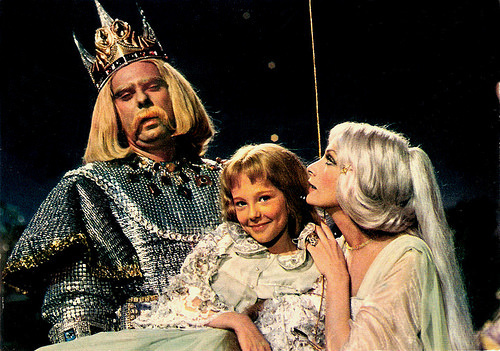
French postcard by Librairie Hachette, Paris, no. 3. Photo: Parc Film Navarre & associes. Publicity still for Le Petit Poucet/Tom Thumb (Michel Boisrond, 1972) with Jean-Luc Bideau as the King, Marianne Ridoret as the princess and Marie Laforêt as the Queen.
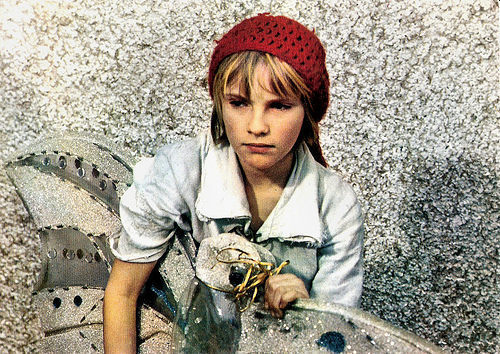
French postcard by Librairie Hachette, Paris, no. 9. Photo: Parc Film Navarre & associés. Publicity still for Le Petit Poucet/Tom Thumb (Michel Boisrond, 1972) with Jean-Christophe Maillot.
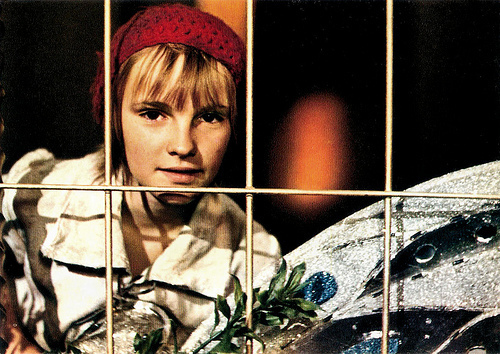
French postcard by Librairie Hachette, Paris, no. 10. Photo: Parc Film Navarre & associés. Publicity still for Le Petit Poucet/Tom Thumb (Michel Boisrond, 1972) with Jean-Christophe Maillot.
Horrifying music
The fairy-tale of Little Thumb has been filmed several times. This little shown 1972 version is a cult film for many French people who grew up in the 1970s.
Due to its great success in France was that the magazine Lisette followed the film by Michel Boisrond in an illustrated adaptation. The story was published in 16 chapters from September to November 1972.
The quite horrifying music was composed by Francis Lai. The cast included well-known actors as Jean-Luc Bideau, Marie Laforêt, and Jean-Pierre Marielle.
Jean-Christophe Maillot, credited as Titoyo, was 12 at the time. Le Petit Poucet was his only film.
Maillot became a dancer and choreographer. At the moment he is the director of the Ballets de Monte-Carlo.
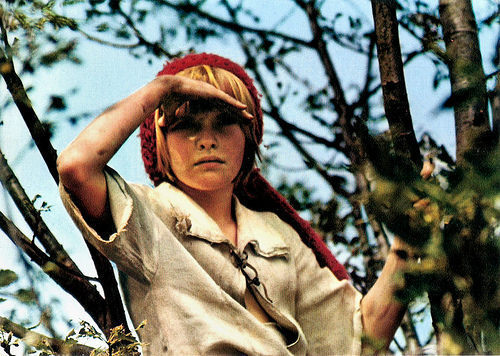
French postcard by Librairie Hachette, Paris, no. 12. Photo: Parc Film Navarre & associés. Publicity still for Le Petit Poucet/Tom Thumb (Michel Boisrond, 1972) with Jean-Christophe Maillot.
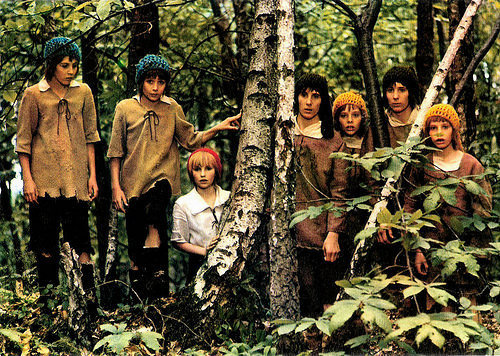
French postcard by Librairie Hachette, Paris, no. 13. Photo: Parc Film Navarre & associés. Publicity still for Le Petit Poucet/Tom Thumb (Michel Boisrond, 1972) with Jean-Christophe Maillot in the title role.
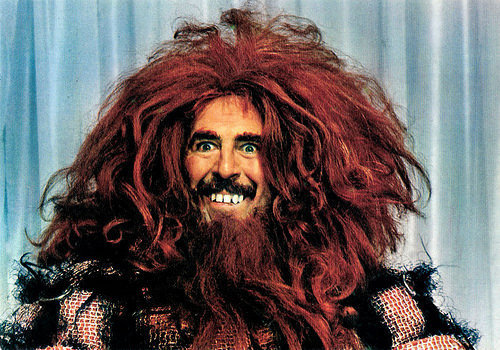
French postcard by Librairie Hachette, Paris, no. 17. Photo: Parc Film Navarre & associés. Publicity still for Le Petit Poucet/Tom Thumb (Michel Boisrond, 1972) with Jean-Pierre Marielle.
Sources: Jan Lipsansky (IMDb), Wikipedia (French and English) and IMDb.

French postcard by Librairie Hachette, Paris, no. 11. Photo: Parc Film Navarre & associés. Publicity still for Le Petit Poucet/Tom Thumb (Michel Boisrond, 1972) with Jean-Christophe Maillot.

French postcard by Librairie Hachette, Paris, no. 2. Photo: Parc Film Navarre & associés. Publicity still for Le Petit Poucet/Tom Thumb (Michel Boisrond, 1972) with Marie Laforêt .
Lost in the wood
Le petit Poucet is one of the eight fairy-tales published by Charles Perrault in Histoires ou Contes du temps passé (1697), now world-renowned.
Little Tom's parents are poor and want to leave him and his brothers in the forest. But Tom Thumb (played by Titoyo aka Jean-Christophe Maillot) is clever and marks his way by white pebbles from a river.
However, the second time he is unsuccessful - he has only bread-crumbs and birds eat them. The brothers are lost in the wood.
Tom climbs up a tree and spots a distant light. The boys walk towards it. They come at last to a house, and learn that it belongs to an ogre (Jean-Pierre Marielle) who has a princess in his entrapment. Tom is determined to free the princess (Marianne Ridoret).

French postcard by Librairie Hachette, Paris, no. 3. Photo: Parc Film Navarre & associes. Publicity still for Le Petit Poucet/Tom Thumb (Michel Boisrond, 1972) with Jean-Luc Bideau as the King, Marianne Ridoret as the princess and Marie Laforêt as the Queen.

French postcard by Librairie Hachette, Paris, no. 9. Photo: Parc Film Navarre & associés. Publicity still for Le Petit Poucet/Tom Thumb (Michel Boisrond, 1972) with Jean-Christophe Maillot.

French postcard by Librairie Hachette, Paris, no. 10. Photo: Parc Film Navarre & associés. Publicity still for Le Petit Poucet/Tom Thumb (Michel Boisrond, 1972) with Jean-Christophe Maillot.
Horrifying music
The fairy-tale of Little Thumb has been filmed several times. This little shown 1972 version is a cult film for many French people who grew up in the 1970s.
Due to its great success in France was that the magazine Lisette followed the film by Michel Boisrond in an illustrated adaptation. The story was published in 16 chapters from September to November 1972.
The quite horrifying music was composed by Francis Lai. The cast included well-known actors as Jean-Luc Bideau, Marie Laforêt, and Jean-Pierre Marielle.
Jean-Christophe Maillot, credited as Titoyo, was 12 at the time. Le Petit Poucet was his only film.
Maillot became a dancer and choreographer. At the moment he is the director of the Ballets de Monte-Carlo.

French postcard by Librairie Hachette, Paris, no. 12. Photo: Parc Film Navarre & associés. Publicity still for Le Petit Poucet/Tom Thumb (Michel Boisrond, 1972) with Jean-Christophe Maillot.

French postcard by Librairie Hachette, Paris, no. 13. Photo: Parc Film Navarre & associés. Publicity still for Le Petit Poucet/Tom Thumb (Michel Boisrond, 1972) with Jean-Christophe Maillot in the title role.

French postcard by Librairie Hachette, Paris, no. 17. Photo: Parc Film Navarre & associés. Publicity still for Le Petit Poucet/Tom Thumb (Michel Boisrond, 1972) with Jean-Pierre Marielle.
Sources: Jan Lipsansky (IMDb), Wikipedia (French and English) and IMDb.
Published on February 20, 2015 22:00
February 19, 2015
Sophia Loren
Sophia Loren (1934) rose to fame in post-war Italy as a voluptuous sex goddess, but proved to be an excellent, Oscar winning actress. She became one of the most successful international stars of the 20th Century with such unforgettable films as La Ciociara/Two Women (1960) and Una giornata particolare/A Special Day (1977). Loren made over 100 films in her 60-year career and her pictures in the 2007 Pirelli calendar proved that she is still a major sex symbol.

French postcard by Editions du Globe (EDUG), Paris, no. 373. Photo: Sam Lévin.
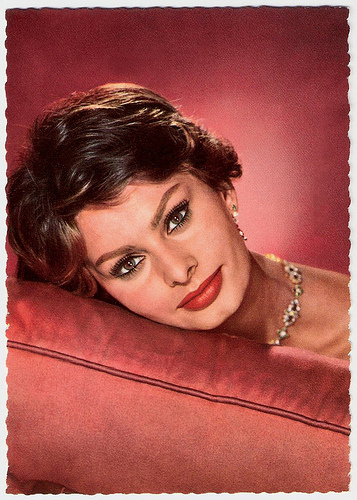
German postcard by Universum-Film Aktiengesellschaft, Berlin-Tempelhof (UFA), no. CK-221. Retail price: 30 Pfg. Photo: Sam Lévin/Ufa.
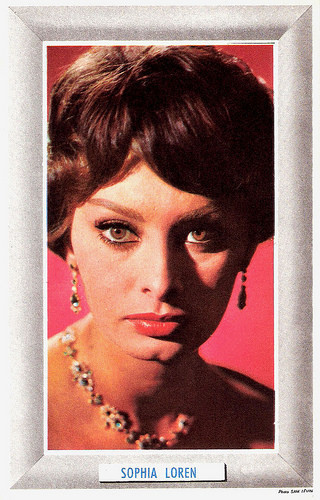
French postcard. Photo: Sam Lévin.
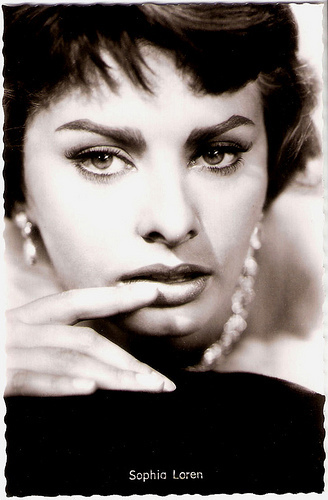
German postcard by Kolibri-Verlag, Minden/Westf., no. 2993.
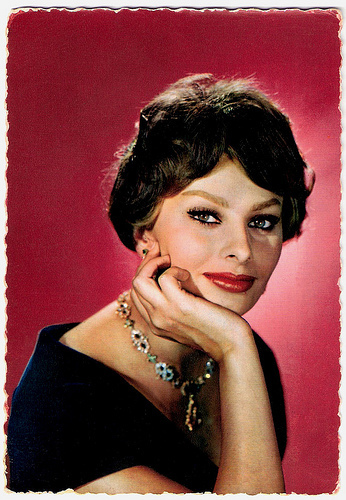
French postcard by Mexichrome, no. 16. Photo: Sam Lévin.
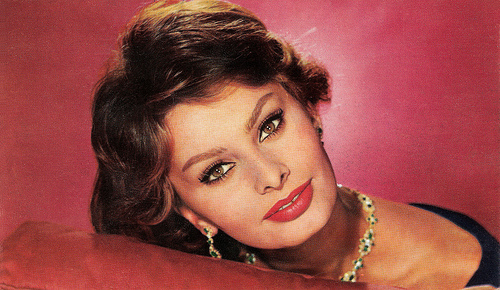
French postcard by E.D.U.G. (Editions du Globe), Paris, no. 39. Offered by Corvisart, Epinal. Photo: Sam Lévin.
Miss Eleganza
Sophia Loren was born Sofia Villani Scicolone in the charity ward of a Roman hospital in 1934. She was the illegitimate daughter of construction engineer Riccardo Scicolone and piano teacher and aspiring actress Romilda Villani. Riccardo was married to another woman and refused to marry Romilda, leaving her without support.
Romilda, Sofia and sister Maria returned to Pozzuoli to live with Sofia's grandmother. Pozzuoli was a small town outside Naples and one of the hardest hit during World War II. The family shared a two-room apartment with the grandmother and several aunts and uncles. The shy, stick thin girl regularly went hungry and had to flee from bombings.
At 14, Sofia had a voluptuous figure and entered a beauty contest. She was selected as one of the finalists, but did not win. In 1949, she was one of the contestants at the Miss Italia competition. She earned the 2nd place and was awarded ‘Miss Eleganza’.
While attending the Miss Rome beauty contest in 1950, she met judge Carlo Ponti, an up-and-coming film producer, 22 years her senior. He had helped launch Gina Lollobrigida 's career, and now began grooming Sofia for stardom. He hired an acting coach to tutor her.
At 16 she was in her first film, the Totó comedy Le Sei Mogli di Barbablù/Bluebeard’s Six Wives (Carlo Ludovico Bragaglia, 1950) under the name Sofia Lazzaro. She also appeared as an extra in Luci del varietà/Lights of the Variety (Federico Fellini, 1950), the smash hit Anna (Alberto Lattuada, 1951) and Quo Vadis (Mervyn Leroy, 1951).
During the early 1950s, she secured work modelling for fumetti magazines. These comic-like magazines used actual photographs. The dialogue bubbles were called 'fumetti' - hence the popular name.
At 17, she was cast by Ponti in her first larger role as the commoner who caught the prince's eye in the filmed opera La Favorita/The Favorite (Cesare Barlacchi, 1952). The next year she earned third billing after Silvana Pampanini and Eleanora Rossi-Drago in La Tratta Delle Bianche/The White Slave Trade (Luigi Comencini, 1953) and she played, complete with blackface and an Afro, the lead in another filmed opera, Aida (Clemente Fracassi, 1953) by Giuseppe Verdi. Her singing was dubbed by Renata Tebaldi. Ponti eventually changed her name to Sophia Loren.
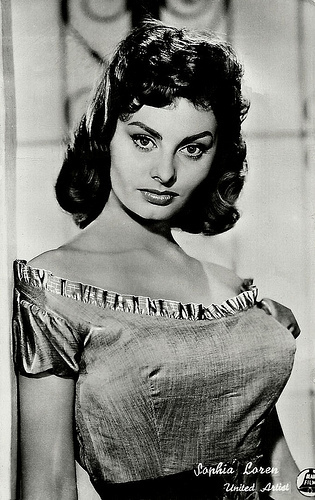
Belgian postcard by Bromophoto, Brussels.
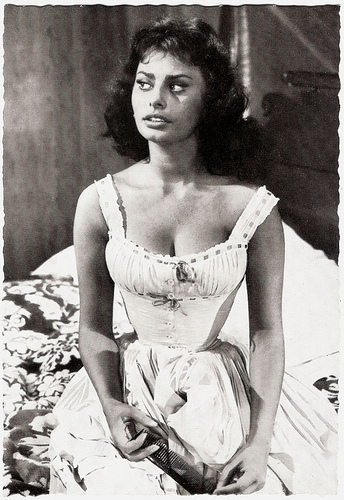
German postcard by WS-Druck, Wanne-Eickel, no. 283. Photo: U.P.
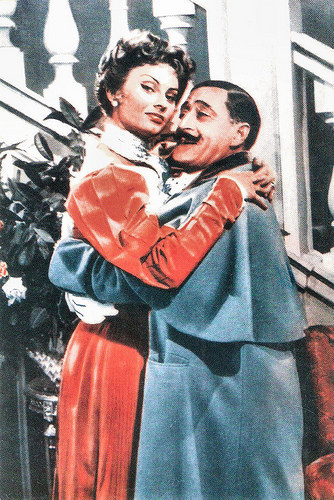
Italian postcard in the series Gli Artisti di Napoli. Photo: publicity still for Miseria e nobiltà/Misery and Nobility (Mario Mattoli, 1954) with Totò.
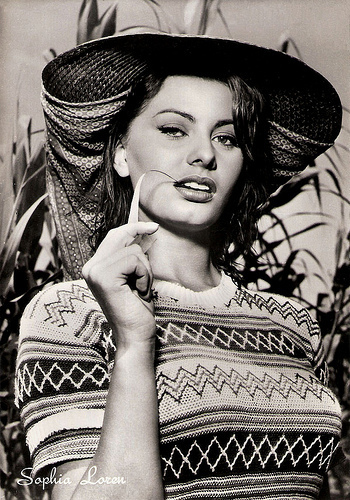
Italian postcard by Rotalfoto, Milano, no. 328. Photo: Ponti-De Laurentiis. Publicity still for La donna del fiume/Woman of the River (Mario Soldati, 1955).
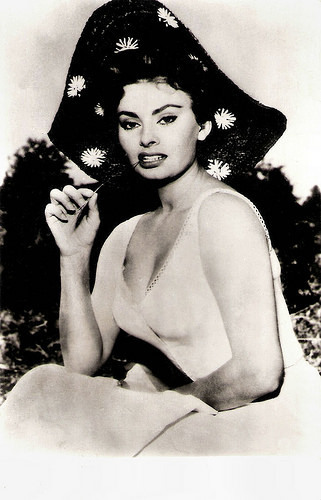
Yugoslavian postcard by Naz Glas, Smederevo, no. 113.
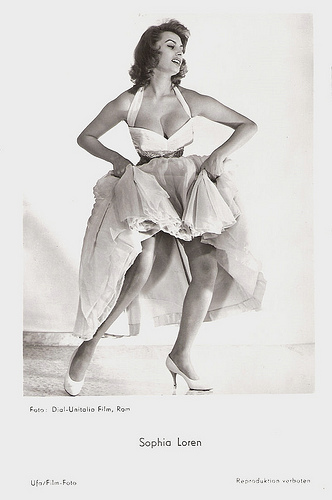
German postcard by Universum-Film Aktiengesellschaft, Berlin-Tempelhof, no. 1631. Photo: Dial / Unitalia Film, Rome.
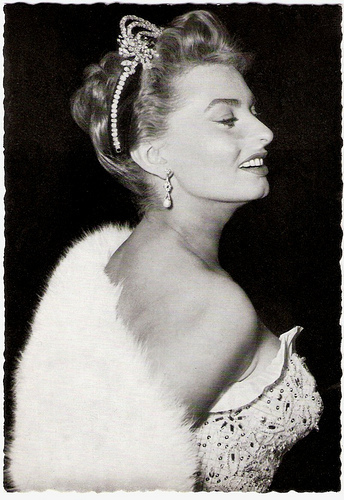
German postcard by WS-Druck, Wanne-Eickel, no. 185. Photo: dpa.
Va-va-va-voom Image
Sophia Loren appeared for the first time with Marcello Mastroianni in the romantic comedy Peccato che sia una canaglia/Too Bad She's Bad (Alessandro Blasetti, 1954). They would make 13 films together, including Tempi nostri/A Slice of Life (Alessandro Blasetti, Paul Paviot, 1954), La bella mugnaia/The Miller's Wife (Mario Camerini, 1955), and La fortuna di essere donna/What A Woman (Alessandro Blasetti, 1956).
L'Oro di Napoli/Gold of Naples (Vittorio de Sica, 1954), an anthology of tales depicting various aspects of Neapolitan life, was distributed internationally. At AllMovie , Jason Ankeny writes that in reviews "Loren was singled out for the strength of her performance as a Neapolitan shopkeeper, surprising many critics who had dismissed her as merely another bombshell".
The film established her persona as a sensuous working class earth mother. It also began a fruitful, career-long collaboration with De Sica.
Sophia’s first film to find international success was La Donna del Fiume/The River Girl (Mario Soldati, 1955), in which she danced sensually the Mambo Bacan. Hal Erickson at AllMovie : "Through it all, Sophia Loren looks like a million lire - and she even gets to sing and dance!".
She came to the attention of Stanley Kramer who offered her the female lead in The Pride And The Passion (Stanley Kramer, 1957) opposite Cary Grant and Frank Sinatra. Sophia played a Spanish peasant girl involved in an uprising against the French. This was the turning point in her career, and the film proved to be one of the top US box office successes of the year.
Her next English-language film was Boy on a Dolphin (Jean Negulesco, 1957) with Alan Ladd, where she was memorable mostly for emerging from the water in a wet, skin-tight, transparent dress. With her va-va-va-voom image she became an international film star and got a five-picture contract with Paramount Pictures.
Among her Paramount films were Desire Under the Elms (Delbert Mann, 1958) with Anthony Perkins and based upon the Eugene O'Neill play, Houseboat (Melville Shavelson, 1958), a romantic comedy co-starring Cary Grant, and the Western Heller in Pink Tights (George Cukor, 1960) in which she appeared for the first time with blonde hair (a wig). Most of these films were received lukewarmly at best.
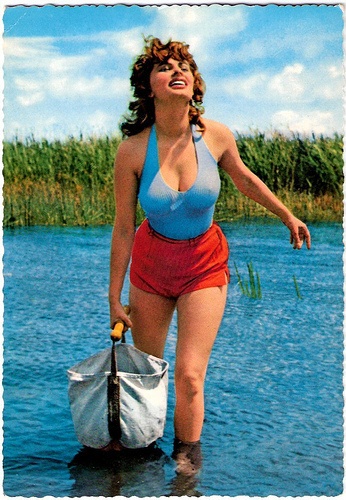
German postcard printed by Krüger, nr. 902/304. Photo: Georg Michalke. Publicity still for La donna del fiume/The River Girl (Mario Soldati, 1955).
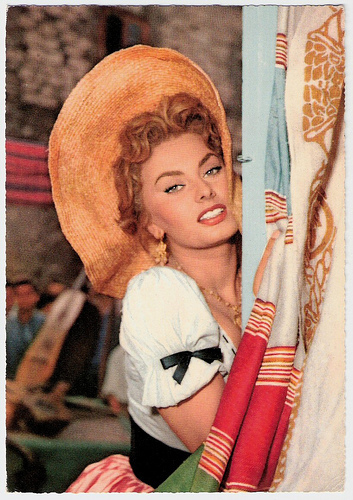
German postcard by Krüger, no. 902/446. Photo: UFA. Publicity still for La Bella Mugnaia/The Miller's Wife (Mario Camerini, 1955).
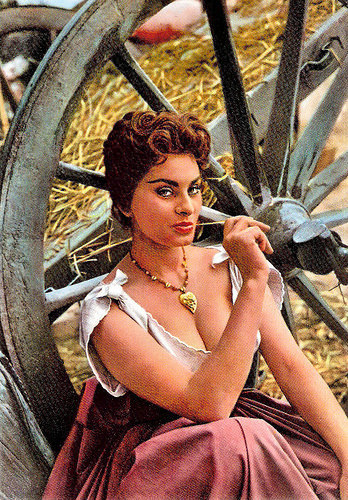
French postcard by P.I. / Korès, no. 38. Photo: Constantin Film. Publicity still for La bella mugnaia/The Miller's Wife (Mario Camerini, 1955).
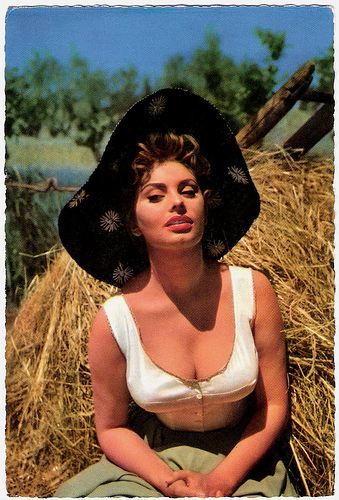
German postcard by UFA, no. 1007. Photo: UFA. Publicity still for La Bella Mugnaia/The Miller's Wife (Mario Camerini, 1955).
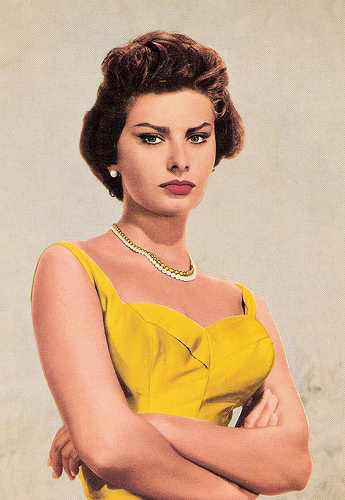
German postcard by Terra-Color, no. F 190. Sent by mail in 1962.
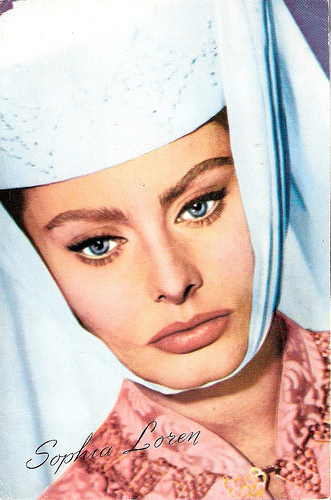
Dutch postcard.
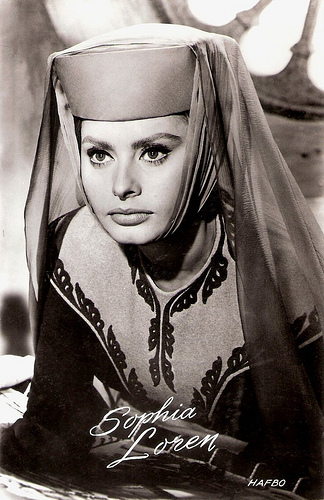
Dutch postcard by Uitg. Takken, Utrecht, no. 4894. Photo: Hafbo. Still from El Cid (Anthony Mann, 1961).
The most lavish costumes ever created for the cinema
In 1960 Sophia Loren returned to Italy to star in the biggest success of her career, La Ciociara/Two Women (Vittorio De Sica, 1960). She played a widow desperately trying to protect her daughter from danger during WW II, only to end up in a destructive love triangle with a young radical ( Jean Paul Belmondo ).
Hal Erickson at AllMovie : "A last-minute replacement for Anna Magnani , Sophia Loren brought hitherto untapped depths of emotion to her performance in Two Women; she later stated that she was utilizing 'sensory recall,' dredging up memories of her own wartime experiences." Loren won the Best Actress Oscar for her performance, and also the Cannes, Venice ánd Berlin Film Festivals' best performance prizes.
Next she played in Spain Samuel Bronston's epic production of El Cid (Anthony Mann, 1961) with Charlton Heston, followed by the De Sica episode of the anthology Boccaccio '70 (Vittorio De Sica, Federico Fellini, Luchino Visconti, 1962).
On the strength of her Oscar win, she also returned to English-language fare with Five Miles to Midnight (Anatole Litvak, 1963), followed a year later by The Fall of the Roman Empire (Anthony Mann, 1964), for which she received $1 million.
Among Loren's other films of this period are The Millionairess (Anthony Asquith, 1960) with Peter Sellers, It Started in Naples (Melville Shavelson, 1960) with Clark Gable, Lady L (Peter Ustinov, 1965) with Paul Newman, Arabesque (Stanley Donen, 1966) with Gregory Peck, and Charlie Chaplin 's final film, A Countess from Hong Kong (1967) with Marlon Brando.
Despite the failure of many of her films to generate sales at the box office, she invariably turned in a charming performance and she wore some of the most lavish costumes ever created for the cinema.
Her best Italian films include the triptych Ieri, oggi, domani/Yesterday, Today And Tomorrow (Vittorio De Sica, 1963), a comedy that poked fun at a Catholic priest and gently mocked the Italian law on birth control, and Matrimonio all'Italiana/Marriage Italian Style (Vittorio De Sica, 1964) with Loren as the hooker who lures Mastroianni into marriage.
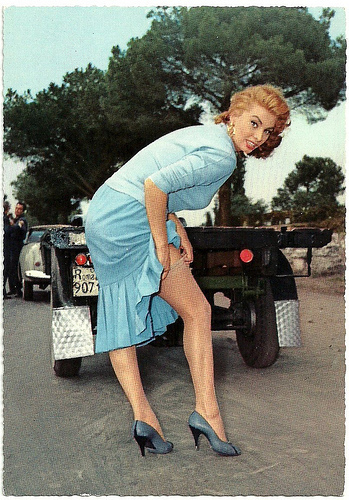
German postcard. Photo: UFA. Taken in Rome, Italy.
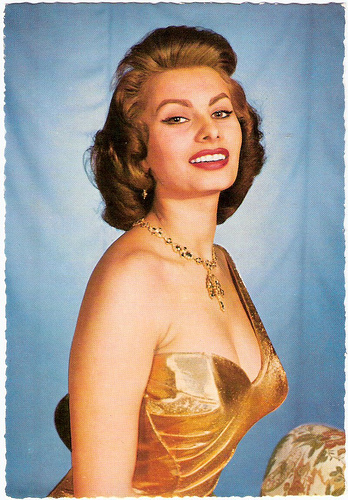
German Postcard by WS-Druck, Wanne-Eickel, no. F 13. Photo: Klaus Collignon.
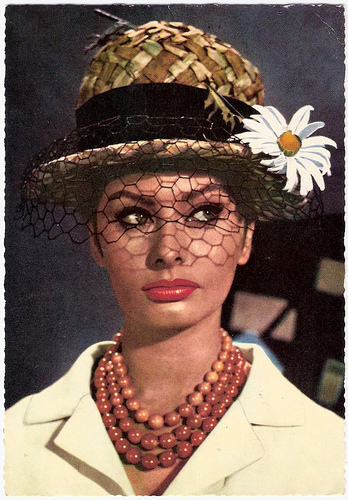
German postcard by ISV, no. A 93. Photo: 20th Century Fox. Publicity still for the British film The Millionairess (Anthony Asquith, 1960).
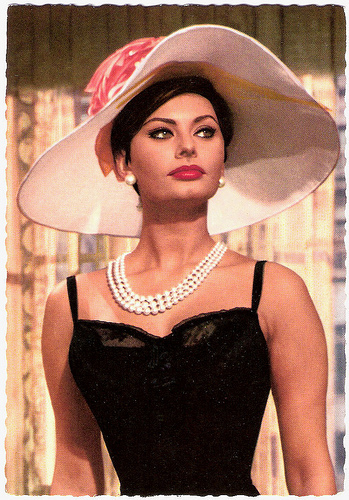
German postcard by Filmbilder-Vertrieb Ernst Freihoff, Essen, no. A 102. Photo: 20th Century Fox. Publicity still for The Millionairess (Anthony Asquith, 1960).
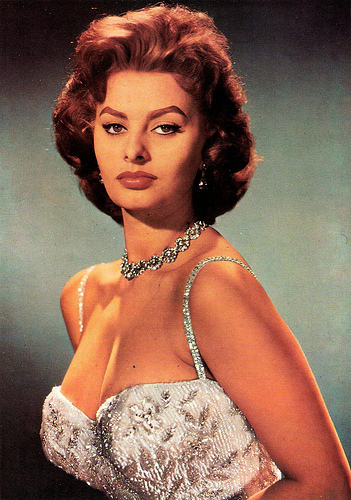
Photo.
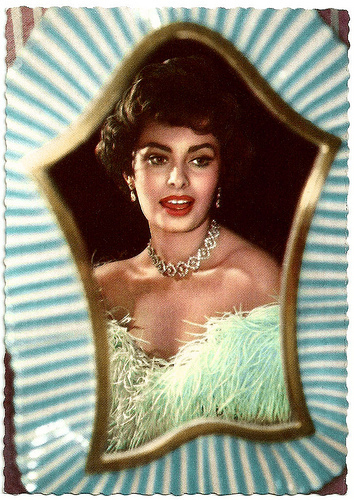
German postcard by UFA, no. CK224. Photo: Fried Agency.
A Special Day
After several miscarriages and a highly-publicized struggle to become pregnant, Sophia Loren gave birth to son Hubert Leoni Carlo Ponti in 1968. She started to work less, and moved into her 40s and 50s with roles in films like De Sica's war drama I Girasoli/The Sunflowers (Vittorio De Sica, 1972), Il Viaggio/The Voyage (Vittorio De Sica, 1974) opposite Richard Burton , and reuniting with Marcello Mastroianni in the mob comedy La Pupa del Gangster/Get Rita (Giorgio Capitani, 1975).
An artistic highlight was Una giornata particolare/A Special Day (Ettore Scola, 1977) which earned a Golden Globe for Best Foreign Film. Loren played a bored housewife at the day of the first meeting between Mussolini and Hitler. Left alone in her tenement home when her fascist husband runs off to attend the historic event, Loren strikes up a friendship with her homosexual neighbour ( Marcello Mastroianni ). As the day segues into night, Loren and Mastroianni develop a very special relationship that will radically alter both of their outlooks on life.
When a dubbed version of Una giornata particolare/A Special Day found favour with American audiences, Hollywood again came calling, resulting in a pair of thrillers, The Brass Target (John Hough, 1978) and Firepower (Michael Winner, 1979) which offered her a central role as a widow seeking answers in the murder of her chemist husband.
In 1980, Loren portrayed herself, as well as her mother, in Sophia Loren: Her Own Story (Mel Stuart, 1980), a made-for-television biopic adaptation of her autobiography. Actresses Ritza Brown and Chiara Ferrari played Loren at younger ages. She made headlines in 1982 when she served an 18-day prison sentence in Italy on tax evasion charges, a fact that didn't damage her career or popularity.
In her 60s, Loren ventured into various areas of business, including cook books, eyewear, jewellery and perfume. In honour of her lengthy career, Loren was the recipient of a special Oscar in 1991. She also made well-received appearances in her final film with Mastroianni, Prêt-à-Porter/Ready to Wear (1994), Robert Altman's take on the French fashion scene, and in the comedy hit Grumpier Old Men (Howard Deutch, 1995) playing a femme fatale opposite Walter Matthau and Jack Lemmon. In 1995 she received the Golden Globe Cecil B. DeMille Award.
At the age of 72, she appeared scantily-clad in the 2007 edition of the famous calendar of Italian racing tire giant Pirelli. It made her the oldest model in the calendar's history. The photos by Dutch photographers Inez van Lamsweerde and Vinoodh Matadin proved that she was still a major international sex symbol.
In 2007 Carlo Ponti died. It had been controversial in her native Italy when Sophia Loren had married her mentor Ponti in 1957. Not only was he 45 to her 23, but he had been married previously, and neither the Catholic Church nor Italian government recognized his Mexican divorce. Ponti was charged with bigamy, but the charges were dropped when they had their marriage annulled. They continued living together - scandalous at the time - and remarried after his legal problems had been cleared.
Ponti and Loren made three dozen films together. They had two children, symphony conductor Carlo Ponti Jr. and film director Edoardo Ponti.
After four years off the big screen, Sophia Loren co-starred in a film version of the Broadway musical Nine (Rob Marshall, 2009). She played the mother of famous film director Guido Contini, portrayed by Daniel Day-Lewis. According to Jason Ankeny at AllMovie, "Loren proved she still had movie star charisma with a role in Chicago director Rob Marshall's Nine - a lavish tribute to all things Italian."
Loren made a two-part television biopic of her early life titled La Mia Casa È Piena di Specchi/My House Is Full of Mirrors (Vittorio Sindoni, 2010), based on of the memoir written by her sister Maria Scicolone.
At 80, Sophia Loren returned to the screen in Human Voice (2014) directed by her son Edoardo Ponti. At the presentation Tribeca Film Festival in New York, 'the timeless beauty' stunned the press once again when she walked on the red carpet in a chic red pantsuit hand-in-hand with her 41-year-old son to promote the short film. Human Voice is based on the play by iconic French playwright Jean Cocteau and sees La Loren play a woman in her twilight years facing revelations from her past.
In late 2014, she also presented her first memoir, Ieri, oggi, domani. La mia vita/Today and Tomorrow: My Life as a Fairy Tale. It includes old pictures, letters and notes detailing encounters with Cary Grant and other film partners.
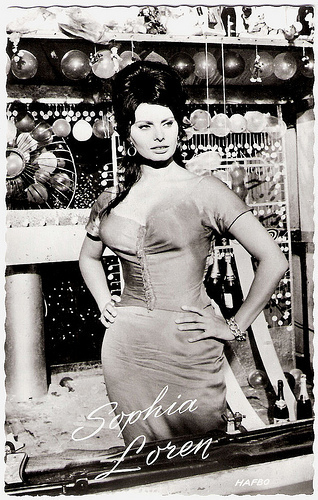
German postcard by Filmbilder-Vertrieb Ernst Freihoff, Essen, no. 5096. Photo: publicity still for Boccaccio '70 (Vittorio De Sica, 1962).
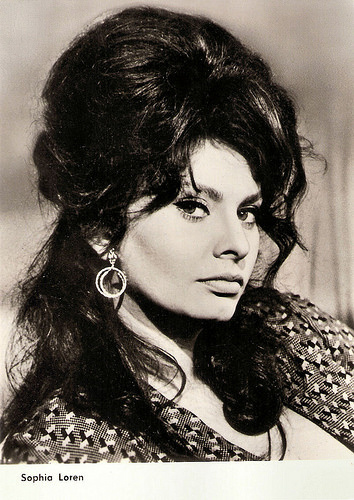
East-German card by VEB Progress Film-Vertrieb, Berlin, no. 2372, 1965. Photo: publicity still for Boccaccio '70 (Vittorio De Sica a.o., 1962).
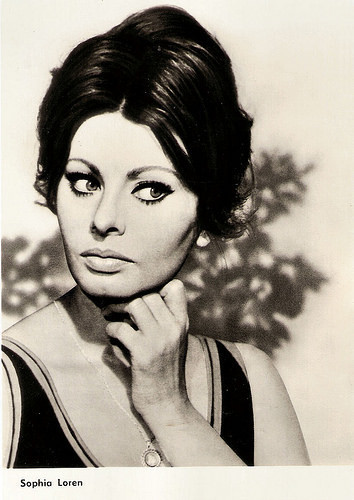
East-German postcard by VEB Progress Filmvertrieb, Berlin, no. 2676, 1966.
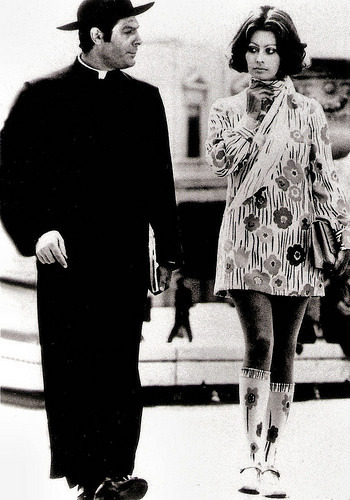
German postcard by pwe Verlag, München (Munich). Photo: publicity still for La moglie del prete/The Priest's Wife (Dino Risi, 1970) with Marcello Mastroianni.
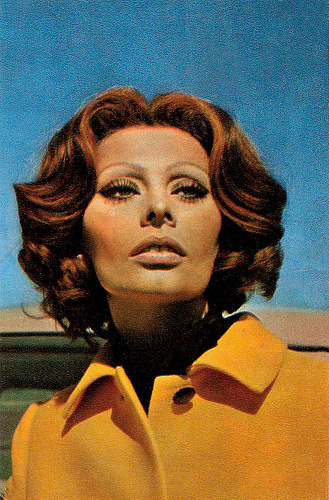
Russian postcard by Izdanije Byuro Propogandy Sovietskogo Kinoiskusstva, no. 4212, 1975. This postcard was printed in an edition of 300.000 cards. The price was 5 kop.
Sophia Loren dances the Mambo Bacan in La donna del fiume (1955). Source: primocarnero07 (YouTube).
Trailer for Nine (2009). Source: HQTrailers1 (YouTube).
Sources: Jason Ankeny (AllMovie), Hal Erickson (AllMovie), Shyam Dodge (Daily Mail), (IMDb), Wikipedia, NNDB, TCM and .

French postcard by Editions du Globe (EDUG), Paris, no. 373. Photo: Sam Lévin.

German postcard by Universum-Film Aktiengesellschaft, Berlin-Tempelhof (UFA), no. CK-221. Retail price: 30 Pfg. Photo: Sam Lévin/Ufa.

French postcard. Photo: Sam Lévin.

German postcard by Kolibri-Verlag, Minden/Westf., no. 2993.

French postcard by Mexichrome, no. 16. Photo: Sam Lévin.

French postcard by E.D.U.G. (Editions du Globe), Paris, no. 39. Offered by Corvisart, Epinal. Photo: Sam Lévin.
Miss Eleganza
Sophia Loren was born Sofia Villani Scicolone in the charity ward of a Roman hospital in 1934. She was the illegitimate daughter of construction engineer Riccardo Scicolone and piano teacher and aspiring actress Romilda Villani. Riccardo was married to another woman and refused to marry Romilda, leaving her without support.
Romilda, Sofia and sister Maria returned to Pozzuoli to live with Sofia's grandmother. Pozzuoli was a small town outside Naples and one of the hardest hit during World War II. The family shared a two-room apartment with the grandmother and several aunts and uncles. The shy, stick thin girl regularly went hungry and had to flee from bombings.
At 14, Sofia had a voluptuous figure and entered a beauty contest. She was selected as one of the finalists, but did not win. In 1949, she was one of the contestants at the Miss Italia competition. She earned the 2nd place and was awarded ‘Miss Eleganza’.
While attending the Miss Rome beauty contest in 1950, she met judge Carlo Ponti, an up-and-coming film producer, 22 years her senior. He had helped launch Gina Lollobrigida 's career, and now began grooming Sofia for stardom. He hired an acting coach to tutor her.
At 16 she was in her first film, the Totó comedy Le Sei Mogli di Barbablù/Bluebeard’s Six Wives (Carlo Ludovico Bragaglia, 1950) under the name Sofia Lazzaro. She also appeared as an extra in Luci del varietà/Lights of the Variety (Federico Fellini, 1950), the smash hit Anna (Alberto Lattuada, 1951) and Quo Vadis (Mervyn Leroy, 1951).
During the early 1950s, she secured work modelling for fumetti magazines. These comic-like magazines used actual photographs. The dialogue bubbles were called 'fumetti' - hence the popular name.
At 17, she was cast by Ponti in her first larger role as the commoner who caught the prince's eye in the filmed opera La Favorita/The Favorite (Cesare Barlacchi, 1952). The next year she earned third billing after Silvana Pampanini and Eleanora Rossi-Drago in La Tratta Delle Bianche/The White Slave Trade (Luigi Comencini, 1953) and she played, complete with blackface and an Afro, the lead in another filmed opera, Aida (Clemente Fracassi, 1953) by Giuseppe Verdi. Her singing was dubbed by Renata Tebaldi. Ponti eventually changed her name to Sophia Loren.

Belgian postcard by Bromophoto, Brussels.

German postcard by WS-Druck, Wanne-Eickel, no. 283. Photo: U.P.

Italian postcard in the series Gli Artisti di Napoli. Photo: publicity still for Miseria e nobiltà/Misery and Nobility (Mario Mattoli, 1954) with Totò.

Italian postcard by Rotalfoto, Milano, no. 328. Photo: Ponti-De Laurentiis. Publicity still for La donna del fiume/Woman of the River (Mario Soldati, 1955).

Yugoslavian postcard by Naz Glas, Smederevo, no. 113.

German postcard by Universum-Film Aktiengesellschaft, Berlin-Tempelhof, no. 1631. Photo: Dial / Unitalia Film, Rome.

German postcard by WS-Druck, Wanne-Eickel, no. 185. Photo: dpa.
Va-va-va-voom Image
Sophia Loren appeared for the first time with Marcello Mastroianni in the romantic comedy Peccato che sia una canaglia/Too Bad She's Bad (Alessandro Blasetti, 1954). They would make 13 films together, including Tempi nostri/A Slice of Life (Alessandro Blasetti, Paul Paviot, 1954), La bella mugnaia/The Miller's Wife (Mario Camerini, 1955), and La fortuna di essere donna/What A Woman (Alessandro Blasetti, 1956).
L'Oro di Napoli/Gold of Naples (Vittorio de Sica, 1954), an anthology of tales depicting various aspects of Neapolitan life, was distributed internationally. At AllMovie , Jason Ankeny writes that in reviews "Loren was singled out for the strength of her performance as a Neapolitan shopkeeper, surprising many critics who had dismissed her as merely another bombshell".
The film established her persona as a sensuous working class earth mother. It also began a fruitful, career-long collaboration with De Sica.
Sophia’s first film to find international success was La Donna del Fiume/The River Girl (Mario Soldati, 1955), in which she danced sensually the Mambo Bacan. Hal Erickson at AllMovie : "Through it all, Sophia Loren looks like a million lire - and she even gets to sing and dance!".
She came to the attention of Stanley Kramer who offered her the female lead in The Pride And The Passion (Stanley Kramer, 1957) opposite Cary Grant and Frank Sinatra. Sophia played a Spanish peasant girl involved in an uprising against the French. This was the turning point in her career, and the film proved to be one of the top US box office successes of the year.
Her next English-language film was Boy on a Dolphin (Jean Negulesco, 1957) with Alan Ladd, where she was memorable mostly for emerging from the water in a wet, skin-tight, transparent dress. With her va-va-va-voom image she became an international film star and got a five-picture contract with Paramount Pictures.
Among her Paramount films were Desire Under the Elms (Delbert Mann, 1958) with Anthony Perkins and based upon the Eugene O'Neill play, Houseboat (Melville Shavelson, 1958), a romantic comedy co-starring Cary Grant, and the Western Heller in Pink Tights (George Cukor, 1960) in which she appeared for the first time with blonde hair (a wig). Most of these films were received lukewarmly at best.

German postcard printed by Krüger, nr. 902/304. Photo: Georg Michalke. Publicity still for La donna del fiume/The River Girl (Mario Soldati, 1955).

German postcard by Krüger, no. 902/446. Photo: UFA. Publicity still for La Bella Mugnaia/The Miller's Wife (Mario Camerini, 1955).

French postcard by P.I. / Korès, no. 38. Photo: Constantin Film. Publicity still for La bella mugnaia/The Miller's Wife (Mario Camerini, 1955).

German postcard by UFA, no. 1007. Photo: UFA. Publicity still for La Bella Mugnaia/The Miller's Wife (Mario Camerini, 1955).

German postcard by Terra-Color, no. F 190. Sent by mail in 1962.

Dutch postcard.

Dutch postcard by Uitg. Takken, Utrecht, no. 4894. Photo: Hafbo. Still from El Cid (Anthony Mann, 1961).
The most lavish costumes ever created for the cinema
In 1960 Sophia Loren returned to Italy to star in the biggest success of her career, La Ciociara/Two Women (Vittorio De Sica, 1960). She played a widow desperately trying to protect her daughter from danger during WW II, only to end up in a destructive love triangle with a young radical ( Jean Paul Belmondo ).
Hal Erickson at AllMovie : "A last-minute replacement for Anna Magnani , Sophia Loren brought hitherto untapped depths of emotion to her performance in Two Women; she later stated that she was utilizing 'sensory recall,' dredging up memories of her own wartime experiences." Loren won the Best Actress Oscar for her performance, and also the Cannes, Venice ánd Berlin Film Festivals' best performance prizes.
Next she played in Spain Samuel Bronston's epic production of El Cid (Anthony Mann, 1961) with Charlton Heston, followed by the De Sica episode of the anthology Boccaccio '70 (Vittorio De Sica, Federico Fellini, Luchino Visconti, 1962).
On the strength of her Oscar win, she also returned to English-language fare with Five Miles to Midnight (Anatole Litvak, 1963), followed a year later by The Fall of the Roman Empire (Anthony Mann, 1964), for which she received $1 million.
Among Loren's other films of this period are The Millionairess (Anthony Asquith, 1960) with Peter Sellers, It Started in Naples (Melville Shavelson, 1960) with Clark Gable, Lady L (Peter Ustinov, 1965) with Paul Newman, Arabesque (Stanley Donen, 1966) with Gregory Peck, and Charlie Chaplin 's final film, A Countess from Hong Kong (1967) with Marlon Brando.
Despite the failure of many of her films to generate sales at the box office, she invariably turned in a charming performance and she wore some of the most lavish costumes ever created for the cinema.
Her best Italian films include the triptych Ieri, oggi, domani/Yesterday, Today And Tomorrow (Vittorio De Sica, 1963), a comedy that poked fun at a Catholic priest and gently mocked the Italian law on birth control, and Matrimonio all'Italiana/Marriage Italian Style (Vittorio De Sica, 1964) with Loren as the hooker who lures Mastroianni into marriage.

German postcard. Photo: UFA. Taken in Rome, Italy.

German Postcard by WS-Druck, Wanne-Eickel, no. F 13. Photo: Klaus Collignon.

German postcard by ISV, no. A 93. Photo: 20th Century Fox. Publicity still for the British film The Millionairess (Anthony Asquith, 1960).

German postcard by Filmbilder-Vertrieb Ernst Freihoff, Essen, no. A 102. Photo: 20th Century Fox. Publicity still for The Millionairess (Anthony Asquith, 1960).

Photo.

German postcard by UFA, no. CK224. Photo: Fried Agency.
A Special Day
After several miscarriages and a highly-publicized struggle to become pregnant, Sophia Loren gave birth to son Hubert Leoni Carlo Ponti in 1968. She started to work less, and moved into her 40s and 50s with roles in films like De Sica's war drama I Girasoli/The Sunflowers (Vittorio De Sica, 1972), Il Viaggio/The Voyage (Vittorio De Sica, 1974) opposite Richard Burton , and reuniting with Marcello Mastroianni in the mob comedy La Pupa del Gangster/Get Rita (Giorgio Capitani, 1975).
An artistic highlight was Una giornata particolare/A Special Day (Ettore Scola, 1977) which earned a Golden Globe for Best Foreign Film. Loren played a bored housewife at the day of the first meeting between Mussolini and Hitler. Left alone in her tenement home when her fascist husband runs off to attend the historic event, Loren strikes up a friendship with her homosexual neighbour ( Marcello Mastroianni ). As the day segues into night, Loren and Mastroianni develop a very special relationship that will radically alter both of their outlooks on life.
When a dubbed version of Una giornata particolare/A Special Day found favour with American audiences, Hollywood again came calling, resulting in a pair of thrillers, The Brass Target (John Hough, 1978) and Firepower (Michael Winner, 1979) which offered her a central role as a widow seeking answers in the murder of her chemist husband.
In 1980, Loren portrayed herself, as well as her mother, in Sophia Loren: Her Own Story (Mel Stuart, 1980), a made-for-television biopic adaptation of her autobiography. Actresses Ritza Brown and Chiara Ferrari played Loren at younger ages. She made headlines in 1982 when she served an 18-day prison sentence in Italy on tax evasion charges, a fact that didn't damage her career or popularity.
In her 60s, Loren ventured into various areas of business, including cook books, eyewear, jewellery and perfume. In honour of her lengthy career, Loren was the recipient of a special Oscar in 1991. She also made well-received appearances in her final film with Mastroianni, Prêt-à-Porter/Ready to Wear (1994), Robert Altman's take on the French fashion scene, and in the comedy hit Grumpier Old Men (Howard Deutch, 1995) playing a femme fatale opposite Walter Matthau and Jack Lemmon. In 1995 she received the Golden Globe Cecil B. DeMille Award.
At the age of 72, she appeared scantily-clad in the 2007 edition of the famous calendar of Italian racing tire giant Pirelli. It made her the oldest model in the calendar's history. The photos by Dutch photographers Inez van Lamsweerde and Vinoodh Matadin proved that she was still a major international sex symbol.
In 2007 Carlo Ponti died. It had been controversial in her native Italy when Sophia Loren had married her mentor Ponti in 1957. Not only was he 45 to her 23, but he had been married previously, and neither the Catholic Church nor Italian government recognized his Mexican divorce. Ponti was charged with bigamy, but the charges were dropped when they had their marriage annulled. They continued living together - scandalous at the time - and remarried after his legal problems had been cleared.
Ponti and Loren made three dozen films together. They had two children, symphony conductor Carlo Ponti Jr. and film director Edoardo Ponti.
After four years off the big screen, Sophia Loren co-starred in a film version of the Broadway musical Nine (Rob Marshall, 2009). She played the mother of famous film director Guido Contini, portrayed by Daniel Day-Lewis. According to Jason Ankeny at AllMovie, "Loren proved she still had movie star charisma with a role in Chicago director Rob Marshall's Nine - a lavish tribute to all things Italian."
Loren made a two-part television biopic of her early life titled La Mia Casa È Piena di Specchi/My House Is Full of Mirrors (Vittorio Sindoni, 2010), based on of the memoir written by her sister Maria Scicolone.
At 80, Sophia Loren returned to the screen in Human Voice (2014) directed by her son Edoardo Ponti. At the presentation Tribeca Film Festival in New York, 'the timeless beauty' stunned the press once again when she walked on the red carpet in a chic red pantsuit hand-in-hand with her 41-year-old son to promote the short film. Human Voice is based on the play by iconic French playwright Jean Cocteau and sees La Loren play a woman in her twilight years facing revelations from her past.
In late 2014, she also presented her first memoir, Ieri, oggi, domani. La mia vita/Today and Tomorrow: My Life as a Fairy Tale. It includes old pictures, letters and notes detailing encounters with Cary Grant and other film partners.

German postcard by Filmbilder-Vertrieb Ernst Freihoff, Essen, no. 5096. Photo: publicity still for Boccaccio '70 (Vittorio De Sica, 1962).

East-German card by VEB Progress Film-Vertrieb, Berlin, no. 2372, 1965. Photo: publicity still for Boccaccio '70 (Vittorio De Sica a.o., 1962).

East-German postcard by VEB Progress Filmvertrieb, Berlin, no. 2676, 1966.

German postcard by pwe Verlag, München (Munich). Photo: publicity still for La moglie del prete/The Priest's Wife (Dino Risi, 1970) with Marcello Mastroianni.

Russian postcard by Izdanije Byuro Propogandy Sovietskogo Kinoiskusstva, no. 4212, 1975. This postcard was printed in an edition of 300.000 cards. The price was 5 kop.
Sophia Loren dances the Mambo Bacan in La donna del fiume (1955). Source: primocarnero07 (YouTube).
Trailer for Nine (2009). Source: HQTrailers1 (YouTube).
Sources: Jason Ankeny (AllMovie), Hal Erickson (AllMovie), Shyam Dodge (Daily Mail), (IMDb), Wikipedia, NNDB, TCM and .
Published on February 19, 2015 22:00
February 18, 2015
New rare postcards from the Cinema of the Russian Empire
Last week, collector Didier Hanson sent me new scans of Russian film postcards from the pre-Soviet era. In October he shared already rare postcards of such silent stars as Vera Karalli, Nathalie Kovanko, Vitold Polonsky and Ossip Runitsch. This time we present you postcards of other stars of the cinema of the Russian empire, like Ivan Khudoleyev, Vasily Kachalov, Vladimir Nikolaevich Davydov, Leonid Leonidov and the beautiful Ye. Volkonskaya.
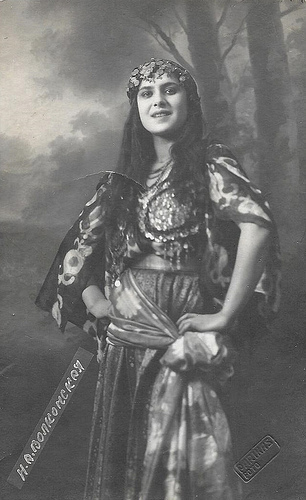
Ye. Volkonskaya. Russian postcard. Photo: Parikas Foto. Collection: Didier Hanson.
Ye. Volkonskaya is an actress, known for supporting roles in the films La fille sauvage/The wild girl (Henri Étiévant, 1922) starring Nathalie Lissenko and Romuald Joubé , Medvezhya svadba/The Bear's Wedding (Konstantin Eggert, Vladimir Gardin, 1925) with Vera Malinovskaya , and Belyy oryol/The Lash of the Czar (Yakov Protazanov, 1928), starring Vasily Kachalov and Anna Sten .
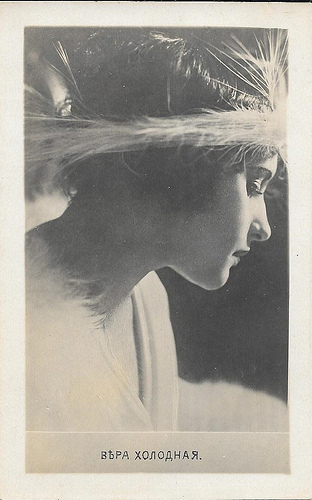
Vera Kholodnaya . Russian postcard. Collection: Didier Hanson.
Vera Kholodnaya (1893-1919) was the first star of the Russian silent cinema. Only 26, the ‘Queen of Screen’ died of the Spanish flu during the pandemic of 1919. Although she worked only three years for the cinema, she must have made between fifty and hundred short films. The Soviet authorities ordered to destroy many of the Kholodnaya features in 1924, and only five of her films still exist.
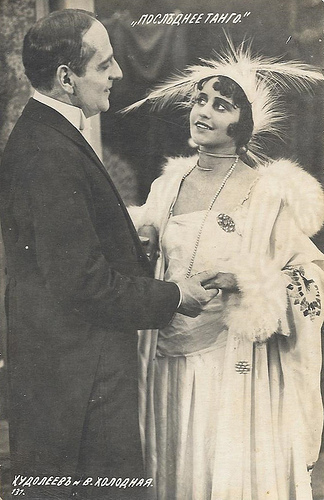
Ivan Khudoleyev and Vera Kholodnaya . Russian postcard, no. 137. Collection: Didier Hanson. Photo: publicity still for Posledneiye tango/Last Tango (Vyacheslav Viskovsky, 1918).
Ivan Nikolaevich Khudoleyev (1875-1932) was a Russian silent film actor. From 1917 on he was the film partner of Vera Kholodnaya in films like Isterzannye dushi/Tortured soul (Vladimir Kasyanov, 1917), the Emile Zola adaptation Chelovek - zver/Man - Beast (Cheslav Sabinsky, 1917), Molchi, grust... molchi/Be quiet, sadness ... be quiet (Pyotr Chardynin, Cheslav Sabinsky, 1918) and Posledneiye tango/Last Tango (Vyacheslav Viskovsky, 1918). Later he starred in Soviet productions like Slesar i kantsler/Locksmith and Chancellor (Vladimir Gardin, 1923) and Do zavtra/Until tomorrow (Yuri Tarich, 1929).
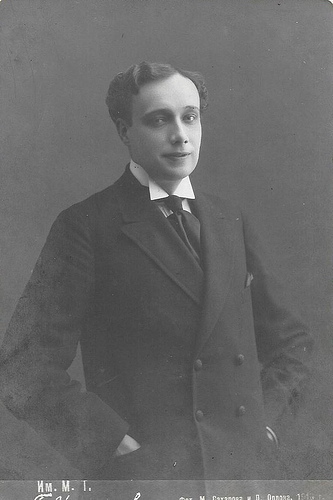
Vladimir Maksimov . Russian postcard. Collection: Didier Hanson.
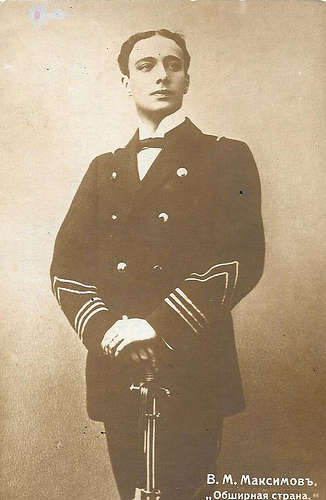
Vladimir Maksimov . Russian postcard. Collection: Didier Hanson.
From 1910 on, Russian stage actor Vladimir Maksimov (sometimes written as Vladimir Maximov, 1880-1937) appeared in films by Yakov Protazanov and Pyotr Chardynin and became a star of the Czarist cinema. He was known for Skorb beskonechnaya/Infinite Sorrow (Aleksandr Panteleyev, 1922), Katsi katsistvis mgelia/Man Is Enemy (Ivane Perestiani, 1923) and Dekabristy/The Decembrists (Aleksandr Ivanovsky, 1927). Maksimov died in 1937 in Moscow.
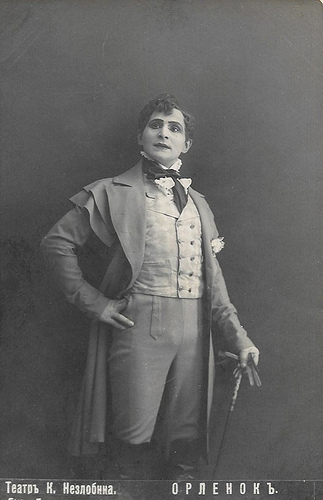
V. I. Likhachev. Russian postcard. Collection: Didier Hanson.
V. I. Likhachev (1879-1965) was a Russian stage actor, who had a great success as King Dagobert in André Rivoire's play Le Bon Roi Dagobert (Good King Dagobert) (1908) in the Nezlobin theatre in Moscow in 1909 and 1910. Later, Likhachev was imprisoned in the Solovki Prison Camp (1923-1939), where he and other prominent political prisoners performed in the Central Theatre.
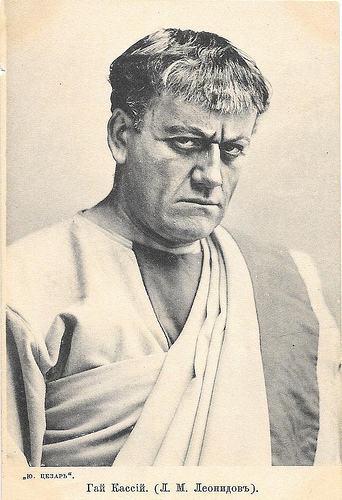
Leonid Leonidov. Russian postcard. Collection: Didier Hanson.
Russian actor and stage director Leonid Leonidov (1873-1941) was born in a Jewish family in Odessa (his real last name was Volfenzon, Russian: Вольфензон). From 1903 on, he worked in the Moscow Art Theatre under Konstantin Stanislavski, who called him "the only Russian tragic actor." His roles included Dmitri Karamazov, Othello, and Lopakhin. From 1918 on, Leonidov starred in several films, such as Khleb/Bread (Richard Boleslawski, Boris Sushkevich, 1918) with Olga Baclanova , and Krylya kholopa/The Wings of a Serf (Yuri Tarich, 1926) as Tsar Ivan the Terrible. He began teaching at the State Institute of Theatre Arts in 1935 and was its dean and artistic director from 1939 until his death. In his teaching, he represented the precepts of Stanislavski. Leonidov was honoured with People's Artist of the USSR in 1936.
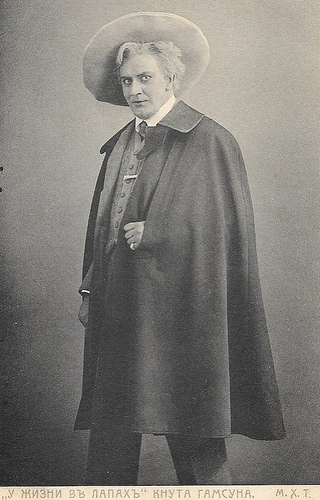
Vasily Kachalov . Russian postcard. Collection: Didier Hanson.
Russian film and stage actor Vasily Kachalov (1875-1948) was one of Konstantin Stanislavsky's best known performers. He led the so-called Kachalov Group within the Moscow Art Theatre. It was Kachalov who played Hamlet in the Symbolist production of 1911. He also appeared in four films.
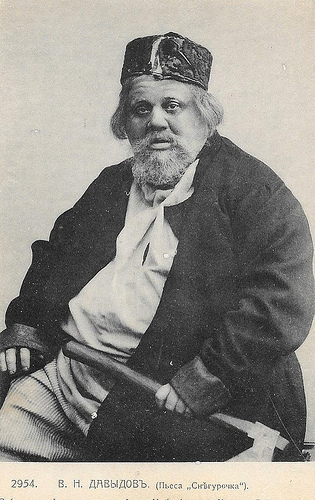
Vladimir Nikolaevich Davydov. Russian postcard, no. 2954. Collection: Didier Hanson.
Russian actor Vladimir Nikolaevich Davydov (1849-1925) was born into a noble family of modest means. He took drama lessons from I. V. Samarin, a famous actor of the Malyi Theater. From 1867 to 1880 he acted in the provinces. From 1880 to 1924 he was in the troupe of the St. Petersburg Alexandra Theatre. Davydov's brilliant technique in transforming himself into the character coupled with his ability to make the character seem true to life enabled him for roles in comedy, tragedy, and musical comedy. (He even played female roles.) His greatest achievements were in the Russian classics, especially the dramas of Anton Chekhov. In 1887, he was the original Ivanov in Chekhov's play. In 1883 he started to teach in the St. Petersburg Theatre School. In 1922 he was honoured as People’s Artist of the Republic.
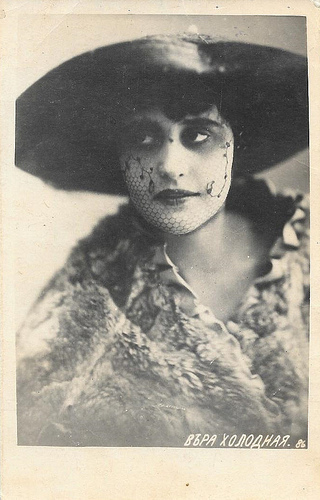
Vera Kholodnaya . Russian postcard, no. 86. Collection: Didier Hanson.
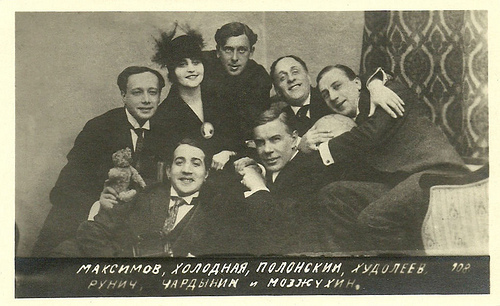
A Who is Who of the Russian silent cinema. In a circle from left: actor Vladimir Maksimov (with bear), actress Vera Kholodnaya , actor Vitold Polonsky, actor Ivan Khudoleyev, actor Ivan Mozzhukin , actor-director Pyotr Chardynin and Ossip Runitsch. Russian postcard, no. 108. Collection: Didier Hanson.
Check out our 12 October 2014 post 'Rare postcards from the Cinema of the Russian Empire'. Many thanks for sharing these postcards at EFSP, Didier!
Sources: The Great Soviet Encyclopedia, Wikipedia and .

Ye. Volkonskaya. Russian postcard. Photo: Parikas Foto. Collection: Didier Hanson.
Ye. Volkonskaya is an actress, known for supporting roles in the films La fille sauvage/The wild girl (Henri Étiévant, 1922) starring Nathalie Lissenko and Romuald Joubé , Medvezhya svadba/The Bear's Wedding (Konstantin Eggert, Vladimir Gardin, 1925) with Vera Malinovskaya , and Belyy oryol/The Lash of the Czar (Yakov Protazanov, 1928), starring Vasily Kachalov and Anna Sten .

Vera Kholodnaya . Russian postcard. Collection: Didier Hanson.
Vera Kholodnaya (1893-1919) was the first star of the Russian silent cinema. Only 26, the ‘Queen of Screen’ died of the Spanish flu during the pandemic of 1919. Although she worked only three years for the cinema, she must have made between fifty and hundred short films. The Soviet authorities ordered to destroy many of the Kholodnaya features in 1924, and only five of her films still exist.

Ivan Khudoleyev and Vera Kholodnaya . Russian postcard, no. 137. Collection: Didier Hanson. Photo: publicity still for Posledneiye tango/Last Tango (Vyacheslav Viskovsky, 1918).
Ivan Nikolaevich Khudoleyev (1875-1932) was a Russian silent film actor. From 1917 on he was the film partner of Vera Kholodnaya in films like Isterzannye dushi/Tortured soul (Vladimir Kasyanov, 1917), the Emile Zola adaptation Chelovek - zver/Man - Beast (Cheslav Sabinsky, 1917), Molchi, grust... molchi/Be quiet, sadness ... be quiet (Pyotr Chardynin, Cheslav Sabinsky, 1918) and Posledneiye tango/Last Tango (Vyacheslav Viskovsky, 1918). Later he starred in Soviet productions like Slesar i kantsler/Locksmith and Chancellor (Vladimir Gardin, 1923) and Do zavtra/Until tomorrow (Yuri Tarich, 1929).

Vladimir Maksimov . Russian postcard. Collection: Didier Hanson.

Vladimir Maksimov . Russian postcard. Collection: Didier Hanson.
From 1910 on, Russian stage actor Vladimir Maksimov (sometimes written as Vladimir Maximov, 1880-1937) appeared in films by Yakov Protazanov and Pyotr Chardynin and became a star of the Czarist cinema. He was known for Skorb beskonechnaya/Infinite Sorrow (Aleksandr Panteleyev, 1922), Katsi katsistvis mgelia/Man Is Enemy (Ivane Perestiani, 1923) and Dekabristy/The Decembrists (Aleksandr Ivanovsky, 1927). Maksimov died in 1937 in Moscow.

V. I. Likhachev. Russian postcard. Collection: Didier Hanson.
V. I. Likhachev (1879-1965) was a Russian stage actor, who had a great success as King Dagobert in André Rivoire's play Le Bon Roi Dagobert (Good King Dagobert) (1908) in the Nezlobin theatre in Moscow in 1909 and 1910. Later, Likhachev was imprisoned in the Solovki Prison Camp (1923-1939), where he and other prominent political prisoners performed in the Central Theatre.

Leonid Leonidov. Russian postcard. Collection: Didier Hanson.
Russian actor and stage director Leonid Leonidov (1873-1941) was born in a Jewish family in Odessa (his real last name was Volfenzon, Russian: Вольфензон). From 1903 on, he worked in the Moscow Art Theatre under Konstantin Stanislavski, who called him "the only Russian tragic actor." His roles included Dmitri Karamazov, Othello, and Lopakhin. From 1918 on, Leonidov starred in several films, such as Khleb/Bread (Richard Boleslawski, Boris Sushkevich, 1918) with Olga Baclanova , and Krylya kholopa/The Wings of a Serf (Yuri Tarich, 1926) as Tsar Ivan the Terrible. He began teaching at the State Institute of Theatre Arts in 1935 and was its dean and artistic director from 1939 until his death. In his teaching, he represented the precepts of Stanislavski. Leonidov was honoured with People's Artist of the USSR in 1936.

Vasily Kachalov . Russian postcard. Collection: Didier Hanson.
Russian film and stage actor Vasily Kachalov (1875-1948) was one of Konstantin Stanislavsky's best known performers. He led the so-called Kachalov Group within the Moscow Art Theatre. It was Kachalov who played Hamlet in the Symbolist production of 1911. He also appeared in four films.

Vladimir Nikolaevich Davydov. Russian postcard, no. 2954. Collection: Didier Hanson.
Russian actor Vladimir Nikolaevich Davydov (1849-1925) was born into a noble family of modest means. He took drama lessons from I. V. Samarin, a famous actor of the Malyi Theater. From 1867 to 1880 he acted in the provinces. From 1880 to 1924 he was in the troupe of the St. Petersburg Alexandra Theatre. Davydov's brilliant technique in transforming himself into the character coupled with his ability to make the character seem true to life enabled him for roles in comedy, tragedy, and musical comedy. (He even played female roles.) His greatest achievements were in the Russian classics, especially the dramas of Anton Chekhov. In 1887, he was the original Ivanov in Chekhov's play. In 1883 he started to teach in the St. Petersburg Theatre School. In 1922 he was honoured as People’s Artist of the Republic.

Vera Kholodnaya . Russian postcard, no. 86. Collection: Didier Hanson.

A Who is Who of the Russian silent cinema. In a circle from left: actor Vladimir Maksimov (with bear), actress Vera Kholodnaya , actor Vitold Polonsky, actor Ivan Khudoleyev, actor Ivan Mozzhukin , actor-director Pyotr Chardynin and Ossip Runitsch. Russian postcard, no. 108. Collection: Didier Hanson.
Check out our 12 October 2014 post 'Rare postcards from the Cinema of the Russian Empire'. Many thanks for sharing these postcards at EFSP, Didier!
Sources: The Great Soviet Encyclopedia, Wikipedia and .
Published on February 18, 2015 22:00
February 17, 2015
Tita Binz
Tita Binz (1903-1970) was a German photographer, who portrayed in her Atelier Binz many of the film stars of the Third Reich. For Film-Foto-Verlag, she also made portraits of the soldiers who were holders of the Knight's Cross.
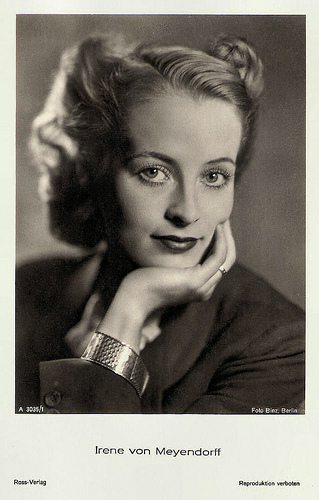
Irene von Meyendorff . German postcard by Ross-Verlag, no. A 3035/1, 1941-1944. Photo: Binz, Berlin.
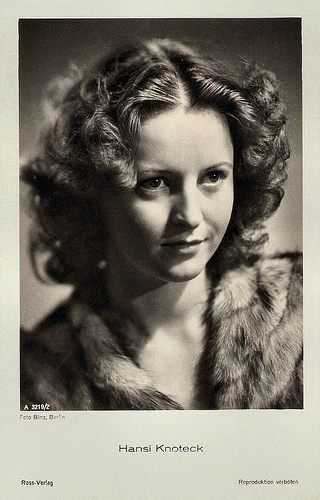
Hansi Knoteck . German postcard by Ross Verlag, Berlin, no. A 3218/2, 1941-1944. Photo: Binz, Berlin.
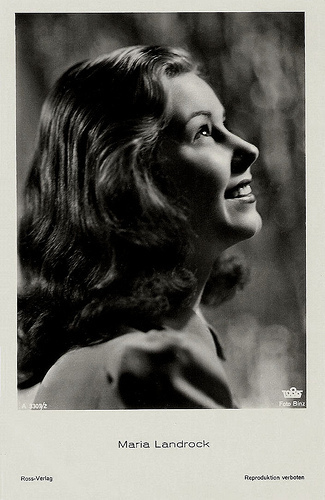
Maria Landrock . German postcard by Ross Verlag, no. A 3309/2, 1941-1944. Photo: Tobis / Binz.
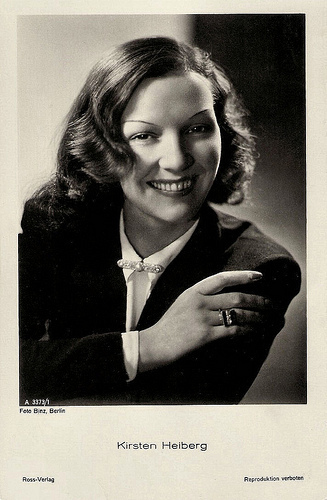
Kirsten Heiberg . German postcard by Ross Verlag, no. A 3373/1, 1941-1944. Photo: Binz, Berlin.
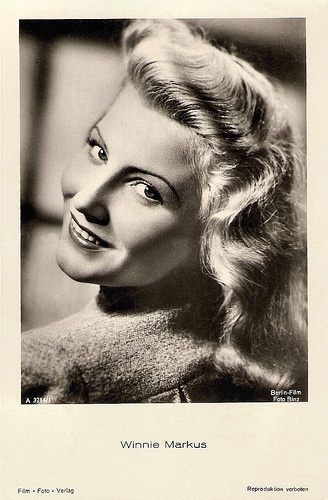
Winnie Markus . German postcard by Film-Foto-Verlag, no. A 3714/1, 1941-1944. Photo: Binz / Berlin-Film.
Showing personality
Tita Binz was born as Juanita Ladewig in Frankfurt am Main in 1903. Binz was the daughter of the chemist Prof. Arthur Binz and his wife, the writer Juanita Reutlinger. In 1911, her family moved to Berlin. During her school years Tita was already fascinated by photography.
From 1928 till 1930, she did an apprenticeship in Paris at the photo studio of her uncle, the famous photographer Léopold Reutlinger . The renowned Reutlinger Studio was opened in 1850 and had become one of the most prestigious photo studios internationally since then.
Later, Binz settled in Berlin. She first earned her living as an assistant in photo studios, but in 1938 she opened her own studio, Foto Binz, located on the chic Kurfürstendamm. Her studio had five employees.
From the start, Foto Binz specialized in portrait photography. Tita Binz portrayed actors, scientists, artists as Käthe Kollwitz, authors, but also military and politicians. The newspaper Berliner Tageblatt praised her for "her talent to show the personality of the person she portrayed".
One of the first clients of Foto Binz was the publisher Film-Foto-Verlag, formerly Ross Verlag . Since 1937, Ross Verlag was no longer in the control of its Jewish founder, Heinrich Ross. The National Socialists had forced Ross out through their Arisierung (Aryanization) program (no Jews could own a business.)
Interestingly enough, the Nazis retained the Ross Verlag name until 1941, next to the new name Film-Foto-Verlag. Film-Foto-Verlag became known for its postcards of film stars who figured in the German and also in the fascist Italian cinema during the years just before and during World War II.
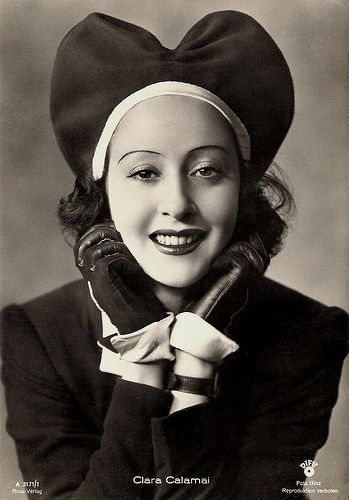
Clara Calamai . German postcard by Ross Verlag, no. A 3171/1, 1941-1944. Photo: Binz / DIFU.
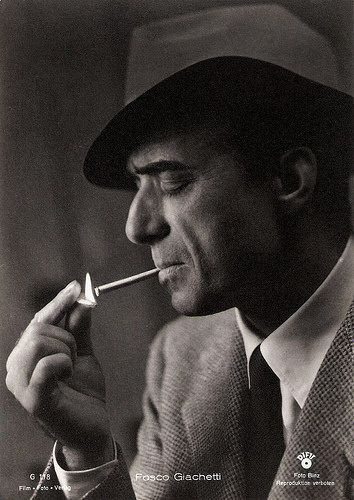
Fosco Giachetti . German postcard by Film-Foto-Verlag, no. G 118, 1941-1944. Photo: DIFU / Binz, Berlin.
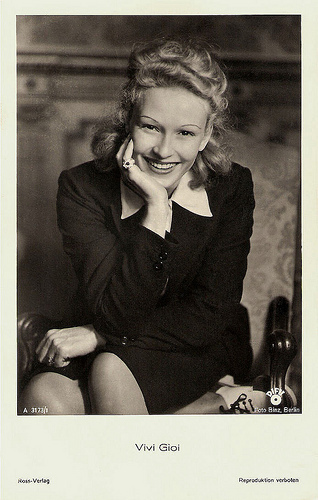
Vivi Gioi . German postcard by Ross-Verlag, no. A 3173/1, 1941-1944. Photo: Binz, Berlin / Difu.

Viktor de Kowa . German postcard by Film-Foto-Verlag, no. A 3457/1, 1941-1944. Photo: Tobis / Foto Binz.
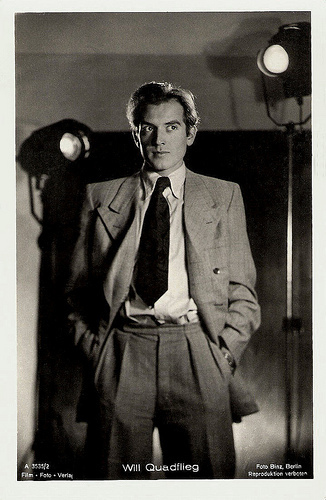
Will Quadflieg . German postcard by Film-Foto-Verlag, no. A 3525/2, 1941-1944. Photo: Foto Binz, Berlin.
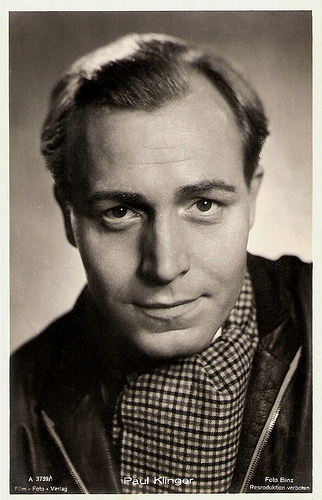
Paul Klinger . German postcard by Film-Foto-Verlag, no. A 3739/1, 1941-1944. Photo: Foto Binz, Berlin.
Propaganda Postcards
Tita Binz was also asked by Film-Foto-Verlag to portray soldiers who were holders of the Ritterkreuz (the Knight's Cross) for their R series of military propaganda postcards. The Nazi regime needed more propaganda and therefore the R series was started in 1939.
At his blog, Pantorijn writes: “It is at this point that two different worlds seem to run together at least in pictures. The actor, the hero of the silver screen and the soldier, the hero of the theatre of war were both raised in the same way. (…) it was not only the image itself but also the design of the postcard that ensured that these two worlds together began to look like one another. It was decided that the lay-out for actors also had to be used for the knight cross bearers.”
Pantorijn illustrates this with the example of film star Hannes Stelzer , a popular Ufa hero during the Nazi period. In 1941 he starred as a Luftwaffe pilot in the propaganda film Stukas (1941). Director of the film was Luftwaffe Major Karl Ritter and director and star worked five times together.
In 1941, Binz photographed Stelzer for Ross-Verlag/Film-Foto-Verlag in a uniform of the Luftwaffe to promote Stukas. Two years later, Stelzer was obliged to report for active duty and got a pilot training. In 1944, the Luftwaffe pilot died when his airplane was shot in Russia.
Binz did never photograph the Waffen-SS. Pantorijn: “This might be due to the fact that she was friends with Hans Oster, a convinced opponent of the Nazi regime. She knew by that friendship also the 'conspirators' Erwin von Witzleben and Erich Hoepner who she portrayed all three. These pictures were not made for Film-Foto-Verlag.”
Immediately after World War II ended in 1945, Tita Binz left Berlin. Until 1949, she lived and worked in Heidelberg. That year, she moved to Mannheim.
Tita Binz died in 1970 in Mannheim at the age of 67. In the collection of the Deutsches Historisches Museum (DHM) are her portraits of Konrad Adenauer, Luise Rinser, Viktor de Kowa , Otto Hahn, Gustav Heinemann, Theodor Heuss, and many other celebrities.
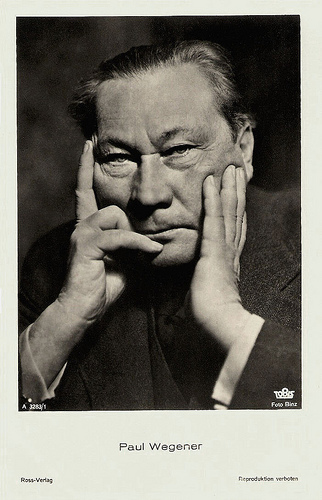
Paul Wegener . German postcard by Ross Verlag, no. A 3283/1, 1941-1944. Photo: Tobis / Foto Binz.
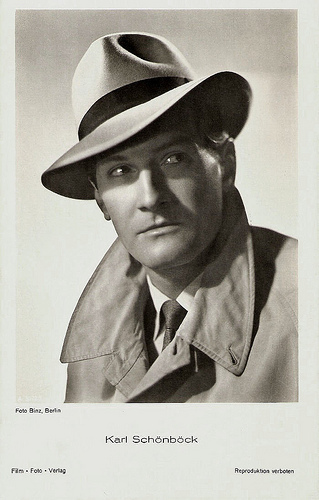
Karl Schönbock . German postcard by Film-Foto-Verlag, no. A 3572/1, 1941-1944. Photo: Foto Binz, Berlin.
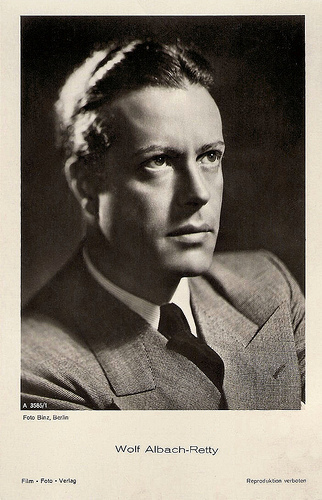
Wolf Albach-Retty . German postcard by Film-Foto-Verlag, no. A 3585/1, 1941-1944. Photo: Foto Binz, Berlin.
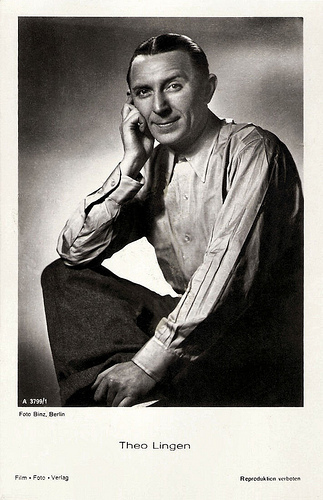
Theo Lingen . German Postcard by Film-Foto-Verlag, no. A 3799/1, 1941-1944. Photo: Foto Binz, Berlin.
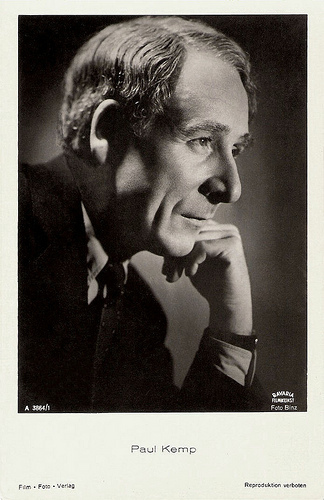
Paul Kemp . German postcard by Film-Foto-Verlag, no. A 3864/1, 1941-1944. Photo: Foto Binz / Bavaria Filmkunst.
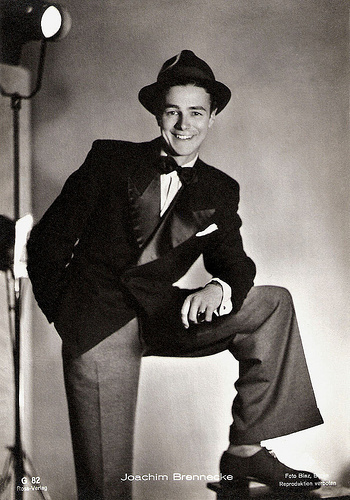
Joachim Brennecke . German postcard by Ross-Verlag, no. G 82, 1941-1944. Photo: Foto Binz, Berlin.
Check out our other posts on film star photographers. See the links at right under the caption 'The Photographers'.
Sources: Pantorijn, Film.Foto.Verlag.comhttp://www.filmfotoverlag.com/about-the-r-series.html, DHM (German), Wikipedia (German), and IMDb.

Irene von Meyendorff . German postcard by Ross-Verlag, no. A 3035/1, 1941-1944. Photo: Binz, Berlin.

Hansi Knoteck . German postcard by Ross Verlag, Berlin, no. A 3218/2, 1941-1944. Photo: Binz, Berlin.

Maria Landrock . German postcard by Ross Verlag, no. A 3309/2, 1941-1944. Photo: Tobis / Binz.

Kirsten Heiberg . German postcard by Ross Verlag, no. A 3373/1, 1941-1944. Photo: Binz, Berlin.

Winnie Markus . German postcard by Film-Foto-Verlag, no. A 3714/1, 1941-1944. Photo: Binz / Berlin-Film.
Showing personality
Tita Binz was born as Juanita Ladewig in Frankfurt am Main in 1903. Binz was the daughter of the chemist Prof. Arthur Binz and his wife, the writer Juanita Reutlinger. In 1911, her family moved to Berlin. During her school years Tita was already fascinated by photography.
From 1928 till 1930, she did an apprenticeship in Paris at the photo studio of her uncle, the famous photographer Léopold Reutlinger . The renowned Reutlinger Studio was opened in 1850 and had become one of the most prestigious photo studios internationally since then.
Later, Binz settled in Berlin. She first earned her living as an assistant in photo studios, but in 1938 she opened her own studio, Foto Binz, located on the chic Kurfürstendamm. Her studio had five employees.
From the start, Foto Binz specialized in portrait photography. Tita Binz portrayed actors, scientists, artists as Käthe Kollwitz, authors, but also military and politicians. The newspaper Berliner Tageblatt praised her for "her talent to show the personality of the person she portrayed".
One of the first clients of Foto Binz was the publisher Film-Foto-Verlag, formerly Ross Verlag . Since 1937, Ross Verlag was no longer in the control of its Jewish founder, Heinrich Ross. The National Socialists had forced Ross out through their Arisierung (Aryanization) program (no Jews could own a business.)
Interestingly enough, the Nazis retained the Ross Verlag name until 1941, next to the new name Film-Foto-Verlag. Film-Foto-Verlag became known for its postcards of film stars who figured in the German and also in the fascist Italian cinema during the years just before and during World War II.

Clara Calamai . German postcard by Ross Verlag, no. A 3171/1, 1941-1944. Photo: Binz / DIFU.

Fosco Giachetti . German postcard by Film-Foto-Verlag, no. G 118, 1941-1944. Photo: DIFU / Binz, Berlin.

Vivi Gioi . German postcard by Ross-Verlag, no. A 3173/1, 1941-1944. Photo: Binz, Berlin / Difu.

Viktor de Kowa . German postcard by Film-Foto-Verlag, no. A 3457/1, 1941-1944. Photo: Tobis / Foto Binz.

Will Quadflieg . German postcard by Film-Foto-Verlag, no. A 3525/2, 1941-1944. Photo: Foto Binz, Berlin.

Paul Klinger . German postcard by Film-Foto-Verlag, no. A 3739/1, 1941-1944. Photo: Foto Binz, Berlin.
Propaganda Postcards
Tita Binz was also asked by Film-Foto-Verlag to portray soldiers who were holders of the Ritterkreuz (the Knight's Cross) for their R series of military propaganda postcards. The Nazi regime needed more propaganda and therefore the R series was started in 1939.
At his blog, Pantorijn writes: “It is at this point that two different worlds seem to run together at least in pictures. The actor, the hero of the silver screen and the soldier, the hero of the theatre of war were both raised in the same way. (…) it was not only the image itself but also the design of the postcard that ensured that these two worlds together began to look like one another. It was decided that the lay-out for actors also had to be used for the knight cross bearers.”
Pantorijn illustrates this with the example of film star Hannes Stelzer , a popular Ufa hero during the Nazi period. In 1941 he starred as a Luftwaffe pilot in the propaganda film Stukas (1941). Director of the film was Luftwaffe Major Karl Ritter and director and star worked five times together.
In 1941, Binz photographed Stelzer for Ross-Verlag/Film-Foto-Verlag in a uniform of the Luftwaffe to promote Stukas. Two years later, Stelzer was obliged to report for active duty and got a pilot training. In 1944, the Luftwaffe pilot died when his airplane was shot in Russia.
Binz did never photograph the Waffen-SS. Pantorijn: “This might be due to the fact that she was friends with Hans Oster, a convinced opponent of the Nazi regime. She knew by that friendship also the 'conspirators' Erwin von Witzleben and Erich Hoepner who she portrayed all three. These pictures were not made for Film-Foto-Verlag.”
Immediately after World War II ended in 1945, Tita Binz left Berlin. Until 1949, she lived and worked in Heidelberg. That year, she moved to Mannheim.
Tita Binz died in 1970 in Mannheim at the age of 67. In the collection of the Deutsches Historisches Museum (DHM) are her portraits of Konrad Adenauer, Luise Rinser, Viktor de Kowa , Otto Hahn, Gustav Heinemann, Theodor Heuss, and many other celebrities.

Paul Wegener . German postcard by Ross Verlag, no. A 3283/1, 1941-1944. Photo: Tobis / Foto Binz.

Karl Schönbock . German postcard by Film-Foto-Verlag, no. A 3572/1, 1941-1944. Photo: Foto Binz, Berlin.

Wolf Albach-Retty . German postcard by Film-Foto-Verlag, no. A 3585/1, 1941-1944. Photo: Foto Binz, Berlin.

Theo Lingen . German Postcard by Film-Foto-Verlag, no. A 3799/1, 1941-1944. Photo: Foto Binz, Berlin.

Paul Kemp . German postcard by Film-Foto-Verlag, no. A 3864/1, 1941-1944. Photo: Foto Binz / Bavaria Filmkunst.

Joachim Brennecke . German postcard by Ross-Verlag, no. G 82, 1941-1944. Photo: Foto Binz, Berlin.
Check out our other posts on film star photographers. See the links at right under the caption 'The Photographers'.
Sources: Pantorijn, Film.Foto.Verlag.comhttp://www.filmfotoverlag.com/about-the-r-series.html, DHM (German), Wikipedia (German), and IMDb.
Published on February 17, 2015 22:00
February 16, 2015
Louis Jourdan (1921-2015)
Last Saturday, dashingly handsome French actor Louis Jourdan died in California, aged 93. Jourdan played lead roles in several Hollywood films in which he often was type casted as the elegant European lover. He is best known for the nine Oscars winning musical Gigi (1958) with Leslie Caron. In the 1980s he could broaden his range with character roles like the eccentric villain opposite James Bond in Octopussy (1983).
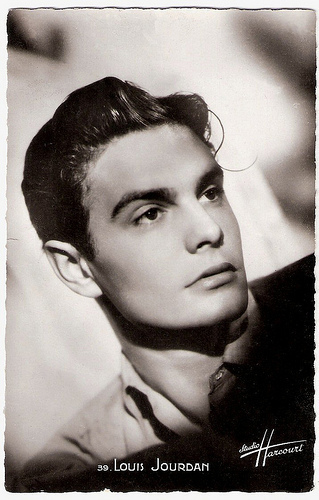
French postcard by S.E.R.P., Paris, no. 39. Photo: Studio Harcourt.
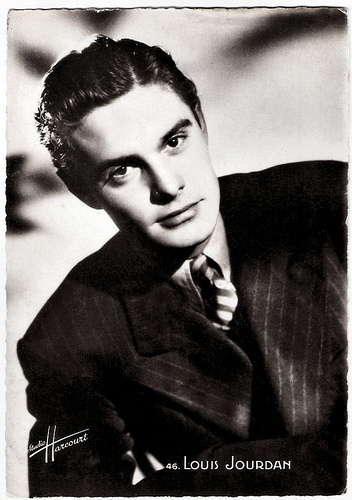
French postcard by S.E.R.P., Paris, no. 46. Photo: Studio Harcourt.
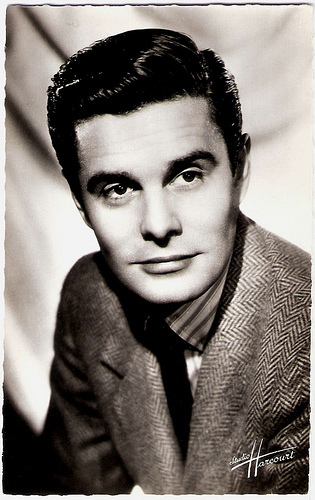
French postcard by Editions du Globe, Paris, no. 76. Photo: Studio Harcourt.
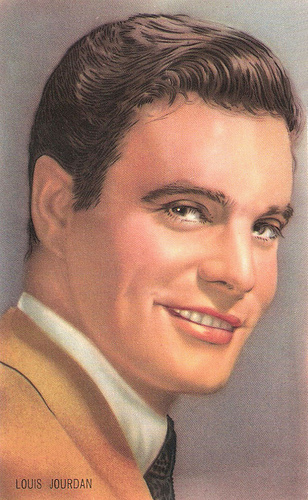
Collectors card.
The Most Handsome French Actor of His Era
Louis Jourdan was born as Louis Gendre in Marseille, France, in 1921 (some sources say 1919 or 1920). His parents, Yvonne Jourdan and Henry Gendre, managed a string of hotels in Cannes, Nice, and Marseille. One of his two brothers was actor-director Pierre Jourdan .
Louis was educated in France, Britain, and Turkey, and in 1938 he received his dramatic training with René Simon at the Écôle Dramatique in Paris. The following year he was discovered by a talent scout and debuted on-screen in Le Corsaire (Marc Allégret, 1939) with Charles Boyer .
He went on to play dashing young leads in French romantic comedies and dramas, such as La comédie du bonheur/The Comedy of Happiness (Marcel L’Herbier, 1940) with Michel Simon and Hollywood legend Ramon Novarro, and Premier rendez-vous/Her First Affair (Henri Decoin, 1941) starring Danielle Darrieux .
Following the German occupation of France during World War II, Jourdan continued to make films, including L’Arlésienne (Marc Allégret, 1942) with Raimu and Gaby Morlay , and Les petites du quai aux fleurs/The Girls of the Quai aux Fleurs (Marc Allégret, 1944) with Micheline Presle , with whom he was briefly married.
After refusing to participate in Nazi propaganda films, his budding film career was cut short. When his hotelier father was arrested by the Gestapo, Jourdan and his brothers joined the French résistance, and helped publish and distribute a newspaper for the underground. After the 1944 liberation of France by the Allies, Jourdan married for a second time. This time with his childhood sweetheart Berthe Frederique, with whom he later would have a son.
Shortly after the liberation, he was seen in leading roles in Félicie Nanteuil (Marc Allégret, 1945) with Micheline Presle and Claude Dauphin , and La Vie de Bohème/La Bohème/The Bohemian Life (Marcel L’Herbier, 1945), with María Denis . These were actually films which were already shot during the war. Jourdan was the stand-out, and he became known as the most handsome French actor of his era.
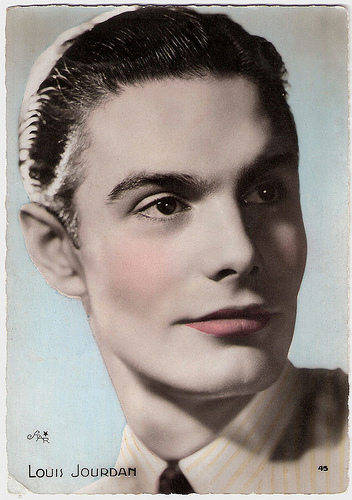
French postcard by Editions O.P., Paris, no. 45. Photo: Star.
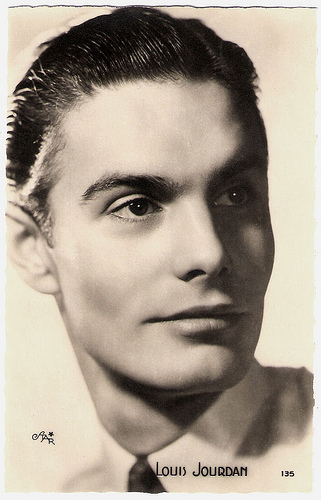
French postcard by Editions O.P., Paris, no. 135. Photo: Star.
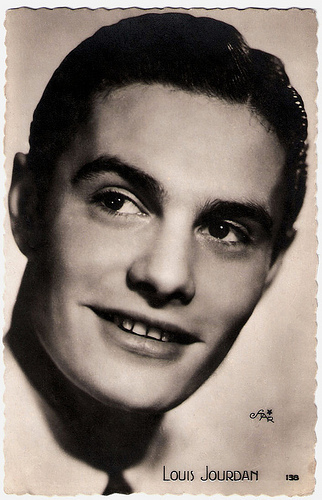
French postcard by Editions O.P., Paris, no. 138. Photo: Star.
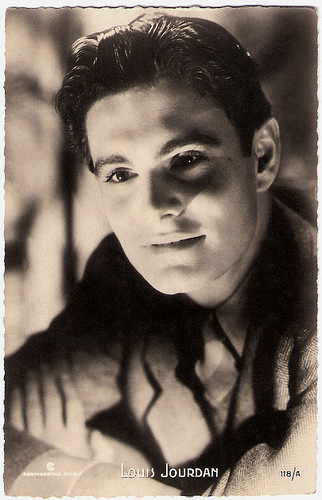
French postcard by Editions Continental, no. 118 A. Photo: Continental Film.
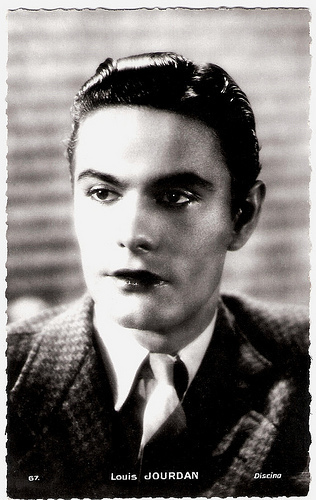
French postcard by Edition Chantal, Rueil, no. 67. Photo: Discina.
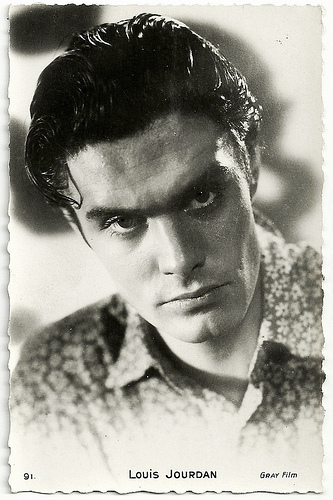
French postcard by Ed. Chantal, Rueil, no. 91. Photo: Gray Film. Publicity still for L'Arlésienne (Marc Allégret, 1942).
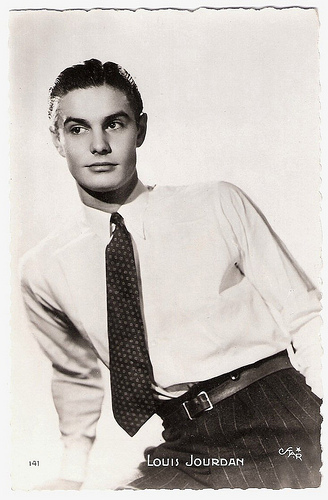
French postcard by Edition P.I., Paris, no. 141. Photo: Star.
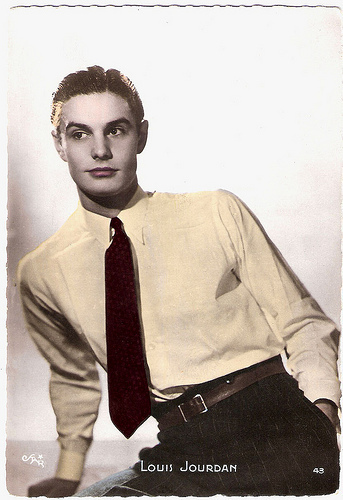
French postcard by Edition P.I., Paris, no. 43. Photo: Star.
Object of Secret Longings
In 1946, Louis Jourdan accepted an offer from Hollywood producer David O. Selznick to appear in the crime drama The Paradine Case (Alfred Hitchcock, 1947) starring Gregory Peck and Alida Valli .
He remained in the US and went on to star in a number of Hollywood films, including No Minor Vices (Lewis Milestone, 1948) with Dana Andrews and Lilli Palmer , Anne of the Indies (Jacques Tourneur, 1951) with Jean Peters and Debra Paget, the comedy The Happy Time (Richard Fleischer, 1952) with Charles Boyer , and Three Coins in the Fountain (Jean Negulesco, 1954) with Clifton Webb and Dorothy McGuire.
His Hollywood career was hampered by the limitations of the roles he was offered, most of which featured him as an old-fashioned European lover à la Charles Boyer . While he was memorable as the object of Joan Fontaine's secret longings in Letter from an Unknown Woman (Max Ophüls, 1948), he went on to play similar roles opposite Jennifer Jones in Madame Bovary (Vincente Minnelli, 1949) and Grace Kelly in The Swan (Charles Vidor, 1956).
In 1954 Jourdan made his Broadway debut in the lead role of Michel in The Immoralist. It was a success. He returned to Broadway for a short run in 1955 and that year he was a hit on television too as Inspector Beaumont in the series Paris Precinct (1955).
He also appeared in European productions, like the Boccaccio adaptation Decameron Nights (Hugo Fregonese, 1953) with Joan Fontaine, Rue de l'Estrapade/Françoise Steps Out (Jacques Becker, 1953) with Daniel Gélin and Anne Vernon, La mariée est trop belle/The Bride is Too Beautiful (Pierre Gaspard-Huit, 1956) opposite Brigitte Bardot , and Escapade (Ralph Habib, 1957) with Dany Carrel .
However, he is best remembered for the musical Gigi (Vincente Minnelli, 1958), based on the Colette novel. He played a French playboy in his late 30s who seduced Leslie Caron the moment she came of legal age, while Maurice Chevalier sang Thank Heaven for Little Girls. The film earned nine Academy Awards, including Best Picture. In 1982, he played the Chevalier role in Gigi on stage, at the age of 63.
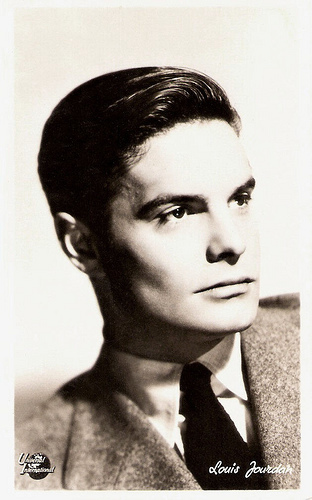
Belgian collectors card by Fotoprim, Brussels, A 8. Photo: Universal International. Publicity photo for Letter from an Unknown Woman (Max Ophüls, 1948).
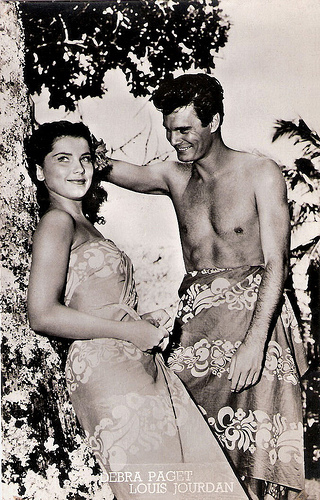
Vintage postcard, no. 552. Photo: 20th Century Fox. Publicity still for Anne of the Indies (Jacques Tourneur, 1951) with Debra Paget.
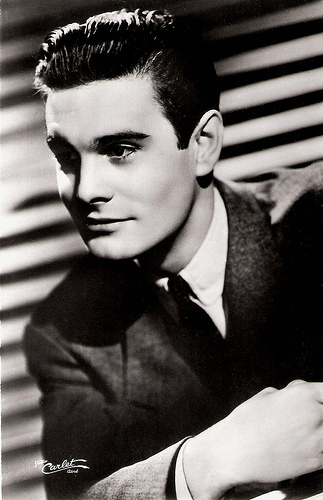
French postcard by Editions O.P., Paris, no. 60. Photo: Studio Carlet Ciné.
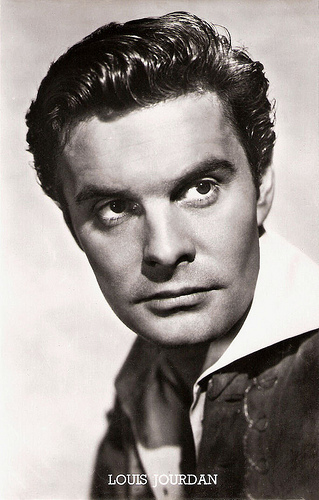
French postcard, no. 79. Photo: 20th Century Fox.
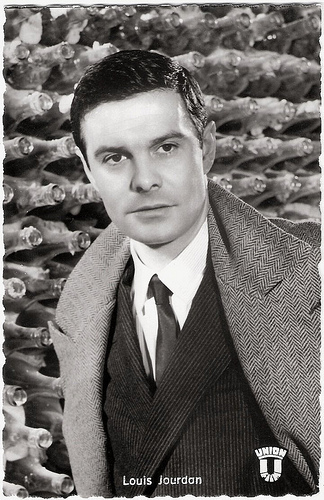
German postcard by Kolibri-Verlag G.m.b.H., Minden/Westf., no. 2887. Photo: Union-Film. Publicity still for Escapade (Ralph Habib, 1957).
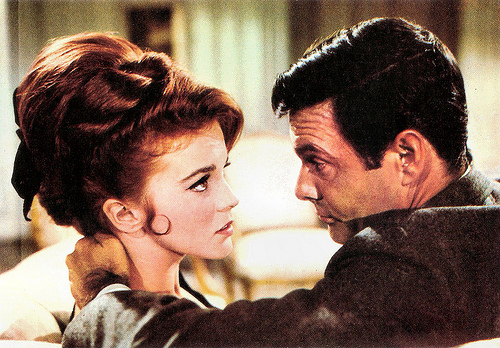
Italian postcard. Photo: Metro Goldwyn Mayer. Publicity still for Made in Paris (Boris Sagal, 1966) with Ann-Margret.
Eccentric Villains
During the 1960s and 1970s Louis Jourdan kept travelling between Hollywood and Europe. He starred in films like Le comte de Monte Cristo/The Count of Monte Cristo (Claude Autant-Lara, 1961) with Yvonne Furneaux, The V.I.P.s (Anthony Asquith, 1963) with Elizabeth Taylor, the TV film Run a Crooked Mile (Gene Levitt, 1969) with Mary Tyler Moore, a TV version of The Count of Monte-Cristo (David Greene, 1975), the BBC production Count Dracula (Mike Newell, 1977), and he was the narrator of the hit comedy Irma la Douce (Billy Wilder, 1963).
In 1981 Louis Jourdan found his only son dead in his Beverly Hills home. Louis Henry, 29, had suffered from depression and had apparently taken an overdose of drugs. The police labelled it a suicide, even though it may have been an accidental overdose.
The next year Louis Jourdan turned to playing eccentric villains, as Dr. Anton Arcane in the campy Sci-Fi film Swamp Thing (Wes Craven, 1982) and its sequel The Return of Swamp Thing (Jim Wynorski, 1989).
In 1983, he was cast as the very charming and sophisticated villain Kamal Khan in the James Bond film Octopussy (1983, John Glen) with Roger Moore .
In 1984, he played the role of Baron Pierre de Coubertin in the Emmy Award winning TV film The First Olympics: Athens 1896 (Alvin Rakoff, 1984). After shooting Year of the Comet (1992, Peter Yates) he retired, and moved to the south of France.
Louis Jourdan lived - part-time in the greater Los Angeles area and part-time in the South of France - with his wife for more than sixty years, Berthe Frederique. In July 2010, Jourdan was made a Chevalier de la Legion d'honneur. Berthe died in 2014, and last Saturday, Jourdan passed away at his home in Beverly Hills at the age of 93.
Trailer for Letter From an Unknown Woman (1948). Source: Xaatt (YouTube).
Trailer for The Swan (1956). Source: Jimusnr (YouTube).
Trailer for Gigi (1958). Source: Webothlovesoup (YouTube).
Trailer for for Made in Paris (1966). Source: Movieclips (YouTube).
Trailer for Octopussy (1983). Source: Chigawa's channel (YouTube).
Sources: Ephraim Katz (The Film Encyclopedia), (IMDb), Yahoo Movies, Filmreference.com, NNDB, Wikipedia, and .

French postcard by S.E.R.P., Paris, no. 39. Photo: Studio Harcourt.

French postcard by S.E.R.P., Paris, no. 46. Photo: Studio Harcourt.

French postcard by Editions du Globe, Paris, no. 76. Photo: Studio Harcourt.

Collectors card.
The Most Handsome French Actor of His Era
Louis Jourdan was born as Louis Gendre in Marseille, France, in 1921 (some sources say 1919 or 1920). His parents, Yvonne Jourdan and Henry Gendre, managed a string of hotels in Cannes, Nice, and Marseille. One of his two brothers was actor-director Pierre Jourdan .
Louis was educated in France, Britain, and Turkey, and in 1938 he received his dramatic training with René Simon at the Écôle Dramatique in Paris. The following year he was discovered by a talent scout and debuted on-screen in Le Corsaire (Marc Allégret, 1939) with Charles Boyer .
He went on to play dashing young leads in French romantic comedies and dramas, such as La comédie du bonheur/The Comedy of Happiness (Marcel L’Herbier, 1940) with Michel Simon and Hollywood legend Ramon Novarro, and Premier rendez-vous/Her First Affair (Henri Decoin, 1941) starring Danielle Darrieux .
Following the German occupation of France during World War II, Jourdan continued to make films, including L’Arlésienne (Marc Allégret, 1942) with Raimu and Gaby Morlay , and Les petites du quai aux fleurs/The Girls of the Quai aux Fleurs (Marc Allégret, 1944) with Micheline Presle , with whom he was briefly married.
After refusing to participate in Nazi propaganda films, his budding film career was cut short. When his hotelier father was arrested by the Gestapo, Jourdan and his brothers joined the French résistance, and helped publish and distribute a newspaper for the underground. After the 1944 liberation of France by the Allies, Jourdan married for a second time. This time with his childhood sweetheart Berthe Frederique, with whom he later would have a son.
Shortly after the liberation, he was seen in leading roles in Félicie Nanteuil (Marc Allégret, 1945) with Micheline Presle and Claude Dauphin , and La Vie de Bohème/La Bohème/The Bohemian Life (Marcel L’Herbier, 1945), with María Denis . These were actually films which were already shot during the war. Jourdan was the stand-out, and he became known as the most handsome French actor of his era.

French postcard by Editions O.P., Paris, no. 45. Photo: Star.

French postcard by Editions O.P., Paris, no. 135. Photo: Star.

French postcard by Editions O.P., Paris, no. 138. Photo: Star.

French postcard by Editions Continental, no. 118 A. Photo: Continental Film.

French postcard by Edition Chantal, Rueil, no. 67. Photo: Discina.

French postcard by Ed. Chantal, Rueil, no. 91. Photo: Gray Film. Publicity still for L'Arlésienne (Marc Allégret, 1942).

French postcard by Edition P.I., Paris, no. 141. Photo: Star.

French postcard by Edition P.I., Paris, no. 43. Photo: Star.
Object of Secret Longings
In 1946, Louis Jourdan accepted an offer from Hollywood producer David O. Selznick to appear in the crime drama The Paradine Case (Alfred Hitchcock, 1947) starring Gregory Peck and Alida Valli .
He remained in the US and went on to star in a number of Hollywood films, including No Minor Vices (Lewis Milestone, 1948) with Dana Andrews and Lilli Palmer , Anne of the Indies (Jacques Tourneur, 1951) with Jean Peters and Debra Paget, the comedy The Happy Time (Richard Fleischer, 1952) with Charles Boyer , and Three Coins in the Fountain (Jean Negulesco, 1954) with Clifton Webb and Dorothy McGuire.
His Hollywood career was hampered by the limitations of the roles he was offered, most of which featured him as an old-fashioned European lover à la Charles Boyer . While he was memorable as the object of Joan Fontaine's secret longings in Letter from an Unknown Woman (Max Ophüls, 1948), he went on to play similar roles opposite Jennifer Jones in Madame Bovary (Vincente Minnelli, 1949) and Grace Kelly in The Swan (Charles Vidor, 1956).
In 1954 Jourdan made his Broadway debut in the lead role of Michel in The Immoralist. It was a success. He returned to Broadway for a short run in 1955 and that year he was a hit on television too as Inspector Beaumont in the series Paris Precinct (1955).
He also appeared in European productions, like the Boccaccio adaptation Decameron Nights (Hugo Fregonese, 1953) with Joan Fontaine, Rue de l'Estrapade/Françoise Steps Out (Jacques Becker, 1953) with Daniel Gélin and Anne Vernon, La mariée est trop belle/The Bride is Too Beautiful (Pierre Gaspard-Huit, 1956) opposite Brigitte Bardot , and Escapade (Ralph Habib, 1957) with Dany Carrel .
However, he is best remembered for the musical Gigi (Vincente Minnelli, 1958), based on the Colette novel. He played a French playboy in his late 30s who seduced Leslie Caron the moment she came of legal age, while Maurice Chevalier sang Thank Heaven for Little Girls. The film earned nine Academy Awards, including Best Picture. In 1982, he played the Chevalier role in Gigi on stage, at the age of 63.

Belgian collectors card by Fotoprim, Brussels, A 8. Photo: Universal International. Publicity photo for Letter from an Unknown Woman (Max Ophüls, 1948).

Vintage postcard, no. 552. Photo: 20th Century Fox. Publicity still for Anne of the Indies (Jacques Tourneur, 1951) with Debra Paget.

French postcard by Editions O.P., Paris, no. 60. Photo: Studio Carlet Ciné.

French postcard, no. 79. Photo: 20th Century Fox.

German postcard by Kolibri-Verlag G.m.b.H., Minden/Westf., no. 2887. Photo: Union-Film. Publicity still for Escapade (Ralph Habib, 1957).

Italian postcard. Photo: Metro Goldwyn Mayer. Publicity still for Made in Paris (Boris Sagal, 1966) with Ann-Margret.
Eccentric Villains
During the 1960s and 1970s Louis Jourdan kept travelling between Hollywood and Europe. He starred in films like Le comte de Monte Cristo/The Count of Monte Cristo (Claude Autant-Lara, 1961) with Yvonne Furneaux, The V.I.P.s (Anthony Asquith, 1963) with Elizabeth Taylor, the TV film Run a Crooked Mile (Gene Levitt, 1969) with Mary Tyler Moore, a TV version of The Count of Monte-Cristo (David Greene, 1975), the BBC production Count Dracula (Mike Newell, 1977), and he was the narrator of the hit comedy Irma la Douce (Billy Wilder, 1963).
In 1981 Louis Jourdan found his only son dead in his Beverly Hills home. Louis Henry, 29, had suffered from depression and had apparently taken an overdose of drugs. The police labelled it a suicide, even though it may have been an accidental overdose.
The next year Louis Jourdan turned to playing eccentric villains, as Dr. Anton Arcane in the campy Sci-Fi film Swamp Thing (Wes Craven, 1982) and its sequel The Return of Swamp Thing (Jim Wynorski, 1989).
In 1983, he was cast as the very charming and sophisticated villain Kamal Khan in the James Bond film Octopussy (1983, John Glen) with Roger Moore .
In 1984, he played the role of Baron Pierre de Coubertin in the Emmy Award winning TV film The First Olympics: Athens 1896 (Alvin Rakoff, 1984). After shooting Year of the Comet (1992, Peter Yates) he retired, and moved to the south of France.
Louis Jourdan lived - part-time in the greater Los Angeles area and part-time in the South of France - with his wife for more than sixty years, Berthe Frederique. In July 2010, Jourdan was made a Chevalier de la Legion d'honneur. Berthe died in 2014, and last Saturday, Jourdan passed away at his home in Beverly Hills at the age of 93.
Trailer for Letter From an Unknown Woman (1948). Source: Xaatt (YouTube).
Trailer for The Swan (1956). Source: Jimusnr (YouTube).
Trailer for Gigi (1958). Source: Webothlovesoup (YouTube).
Trailer for for Made in Paris (1966). Source: Movieclips (YouTube).
Trailer for Octopussy (1983). Source: Chigawa's channel (YouTube).
Sources: Ephraim Katz (The Film Encyclopedia), (IMDb), Yahoo Movies, Filmreference.com, NNDB, Wikipedia, and .
Published on February 16, 2015 15:02
Paul van Yperen's Blog
- Paul van Yperen's profile
- 13 followers
Paul van Yperen isn't a Goodreads Author
(yet),
but they
do have a blog,
so here are some recent posts imported from
their feed.



